INTEGRAL (INTErnational Gamma-Ray Astrophysics Laboratory)
Non-EO
ESA
NASA
Quick facts
Overview
| Mission type | Non-EO |
| Agency | ESA, NASA |
| Launch date | 17 Oct 2002 |
INTEGRAL (INTErnational Gamma-Ray Astrophysics Laboratory)
Spacecraft Launch Mission Status Sensor Complement Ground Segment References
INTEGRAL is the first space observatory that can simultaneously observe objects in gamma rays, X-rays and visible light. Its principal targets are violent explosions known as gamma-ray bursts, powerful phenomena such as supernova explosions, and regions in the Universe thought to contain black holes. 1)
INTEGRAL was selected by the ESA (European Space Agency) in June 1993 as the next ESA medium-size scientific mission (M2) of its Horizon 2000 program. The mission was conceived as an observatory led by ESA with contributions from Russia (Proton launcher) and NASA (Deep Space Network ground station).
Scientific objectives: Gamma-ray astronomy explores the most energetic phenomena that occur in nature and addresses some of the most fundamental problems in physics and astrophysics. It embraces a great variety of gamma-ray continuum and gamma-ray line processes: nuclear excitation, radioactivity, positron annihilation and Compton scattering; and an even greater diversity of astrophysical objects and phenomena: nucleosynthesis, nova and supernova explosions, the interstellar medium, cosmic-ray interactions and sources, neutron stars, black holes, gamma-ray bursts, active galactic nuclei and the cosmic gamma-ray background. Not only do gamma-rays allow us to see deeper into these objects, but the bulk of the power radiated by them is often at gamma-ray energies.
The scientific goals of INTEGRAL are addressed through the use of high resolution spectroscopy with fine imaging and accurate positioning of celestial sources in the gamma-ray domain. Fine spectroscopy over the entire energy range permits spectral features to be uniquely identified and line profiles to be determined for physical studies of the source region. The fine imaging capability of INTEGRAL within a large field of view permits the accurate location and hence identification of the gamma-ray emitting objects with counterparts at other wavelengths, enables extended regions to be distinguished from point sources and provides considerable serendipitous science which is very important for an observatory-class mission.
Some of the topics addressed by INTEGRAL are:
• Compact Objects: White Dwarfs, Neutron Stars, Black Hole Candidates, High Energy Transients
• Extragalactic Astronomy: Galaxies, Clusters, AGN (Active Galactic Nuclei), Seyferts, Blazars (very compact quasars associated with a presumed supermassive black hole at the center of an active, giant elliptical galaxy), CDB (Cosmic Diffuse Background)
• Nucleosynthesis Studies: Hydrostatic Nucleosynthesis (AGB, WR Stars), Explosive Nucleosynthesis (Supernovae, Novae)
• The Galactic Center: Sgr A*, diffuse emission, monitoring the Galactic Center and Bulge
• GRBs (Gamma-Ray Bursts): Alerts, GRB properties
• Classification and Identification of High Energy Sources: Source Catalogues, Identifying Gamma-Ray Objects
• Unexpected Discoveries (Obscured sources, Supergiant Fast X-ray Transients, hard tails from magnetars).
Background: Gamma rays are even more powerful and penetrating than the X-rays used in medical examinations. Fortunately, Earth's atmosphere acts as a shield to protect us from this dangerous cosmic radiation. This means that gamma rays from space can only be detected above Earth’s atmosphere. INTEGRAL is the most advanced gamma-ray observatory ever launched. It can detect radiation from events far away and from the processes that shape the Universe.
Most of the elements in our bodies and in everything around us come from dying stars! However, how can new elements be formed when a star dies? To answer this question precisely, more basic research has to be done. INTEGRAL will help to find out more about this element-making process.
It sounds paradoxical: the events that made the Universe habitable were catastrophic. Violent stellar explosions provided the energy that was needed to form the elements from which planets and living things could be built. Gamma rays from these supernova explosions and from newly formed radioactive elements will be registered by INTEGRAL.
Intense sources of gamma rays lie in the center of our own galaxy, the Milky Way, caused by an enormous black hole, almost 3 million times more massive than our Sun. Results from INTEGRAL may help understanding the nature of this giant and enigmatic object. Gamma rays also appear after a supernova explosion when matter squirms in the intense gravity of the collapsed and very dense star remnant. Studying such compact objects as neutron stars or black holes is the second and very important task of INTEGRAL.
Besides stellar black holes, much bigger specimens of these extremely dense objects may exist. Most astronomers believe that in the heart of our galaxy, as in the center of other galaxies, there are giant black holes. INTEGRAL will not only find evidence of these exotic objects, but allow detailed studies of their physical properties.
Even stranger than the energetic radiation coming from the center of distant galaxies are the flashes of extremely powerful radiation that suddenly appear somewhere in the gamma sky and disappear again after a short time. Observations in different wavelengths confirm that these bursts are the biggest explosions in the Universe. However, what is exploding out there? INTEGRAL will help to solve this cosmic mystery.
Spacecraft
INTEGRAL is a truly international mission with the participation of all member states of ESA plus the United States, Russia, Czech Republic, and Poland. ESA appointed Alenia Spazio, Italy, as industrial prime contractor, responsible for the design, integration and testing of the satellite. On board, four instruments from teams led by scientists in Italy, France, Germany, Denmark, and Spain are today gathering and analyzing the gamma-rays from space. A Russian Proton rocket successfully placed the spacecraft into orbit. ESA and NASA ground stations are keeping in touch with INTEGRAL. The mission operations center responsible for satellite control is located at ESOC in Germany. The ISOC (INTEGRAL Science Operations Center) at Noordwijk, the Netherlands, is providing the observation plan, and Switzerland hosts the center for the scientific data, the ISDC (INTEGRAL Science Data Center).
The spacecraft consists of a service module (bus), containing all spacecraft subsystems, and a payload module, containing the scientific instruments. The service module is identical for the two ESA scientific missions INTEGRAL and XMM-Newton. The simplicity of the interface between the service and the payload modules is a major design driver. The electrical interface is reduced to a power and data handling bus. The modular approach has been conceived to allow for a parallel development, assembly, integration and test of the service and payload modules. 2) 3)
The spacecraft has been built under ESA contract by a large industrial consortium led by Alenia Spazio as prime contractor (Figure 1). Fixed solar arrays are used. Pointing any region in the sky (at any time) is constrained by thermal (and power) reasons: the difference between the solar array normal vector and the sun vector can be up to 40 degrees during the first two years of operations (during eclipse seasons: up to 30º) and up to 30º during the extended mission phase (from end of 2004 until 31 December 2012, subject to a further scientific review in the fall of 2009). This viewing constraint implies that the spacecraft (instrument line of sight) can not point to sources which are closer than 50º to the sun and to the anti-sun during nominal lifetime (60º if eclipse seasons and extended lifetime). During the first two years of the mission, the spacecraft pointed to 64% of the celestial sphere at any point in time (50% of the celestial sphere for the extended mission phase).

In order to suppress systematic effects on spatial and temporal background variations in the spectrometer (SPI) detectors, a controlled and systematic spacecraft dithering ("raster-scan") maneuver is required (Figure 2). This maneuver consists of several off-pointings of the spacecraft pointing axis from the target in steps of 2.17º. Two different pointing patterns (modes) are foreseen as operational baseline:
• Mode 1 consists of a hexagonal pattern around the nominal target location (1 source on-axis pointing, 6 off-source pointings);
• Mode 2 consists of a square pattern around the nominal target location (1 source on-axis pointing, 24 off-source pointings).
Mode 1 is used for a single known point source, mode 2 for multiple point sources in the FOV (Field of View), sources with unknown locations and extended diffuse emission which can also be observed through combination of mode 2 patterns. In order to reduce the amplitude of any residual background structures in the IBIS images, mode 2 has been modified in August 2004: the central pointing position of the next cycle is slightly offset from the last to ensure that residual structures in the background images are better averaged out, improving the achieved sensitivity. In addition, between each pointing of mode 2, the roll angle changed by 6º (from +3 to -3) since November 2007, helping again in reducing any residual structures in the background images. The integration time for each pointing on the raster varies from 1800 to 3600 seconds. The spacecraft continuously follows one dithering pattern throughout one observation. If scientific requirements (i.e., observation proposals) exist to observe sources for long uninterrupted periods of time, using all the four instruments (OMC, JEM-X, IBIS and SPI), then the dithering modes can be switched off.

The spacecraft configuration was in many ways predetermined by (i) the decision to re-use the XMM-Newton Service Module design, (ii) the mass and FOV requirements of the instruments and (iii) the constraining dimensions of the Proton fairing. The basic requirement of the INTEGRAL satellite being compatible with the Ariane 5 and Proton launchers implied interesting design challenges. It required all mechanical and electrical interfaces, the environmental requirements and the spacecraft envelope to be established for design integrity with both launchers.
The large mass of the spectrometer and the minimum focal length of the imager presented serious center-of-gravity and fairing envelope problems, besides the need to distribute the loads into the Service Module structure. With local cut-outs in the fairing insulation and by rounding off the corners of the payload module upper part, an almost perfect balancing of the satellite was achieved. The tight envelope also influenced the selected accommodation of the telecommunication antennae. By placing the antennae on short booms and on two diagonally opposite corners of the service module, the desire to avoid deployable booms and the fairing envelope constraints were both satisfied. A summary of the main facts and figures about INTEGRAL are given in Table 1. An exploded view of INTEGRAL is shown in Figure 3.
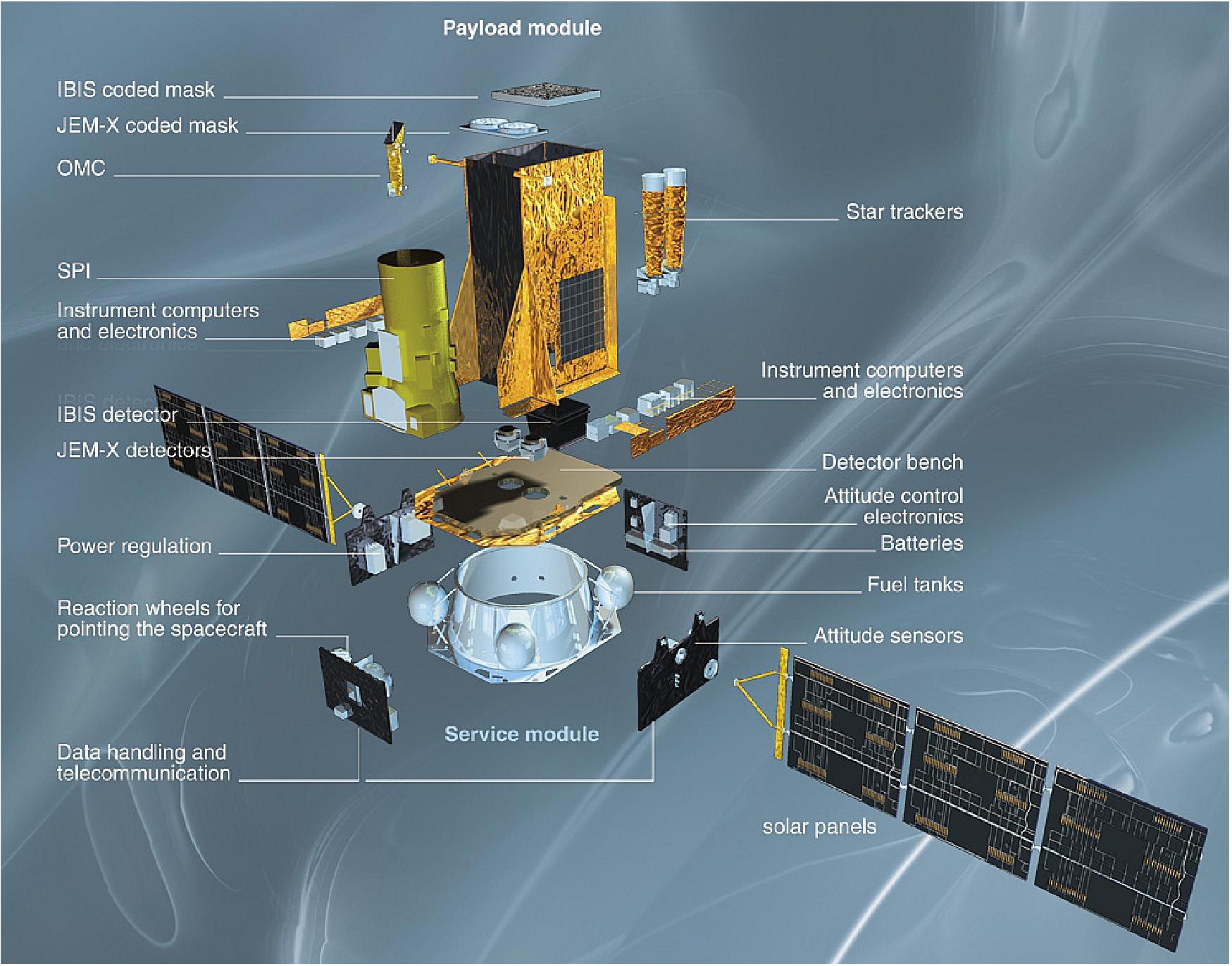
Objective | Fine imaging and spectroscopy of celestial gamma-ray sources in the energy range 15 keV to 10 MeV |
Instruments |
|
IBIS (Imager on Board the | 15 keV–10 MeV, coded aperture mask, 16483 CdTe detectors, each (4 x 4 x 2) mm, 4096 CsI detectors, each (8.4 x 8.4 x 30) mm |
SPI (Spectrometer on INTEGRAL) | 18 keV–8 MeV, coded aperture mask, 19 Ge detectors, each (6 x 7) cm, cooled @ 85 K |
JEM-X (Joint European X-ray | 4 keV–35 keV, coded aperture mask, micro-strip detector (2 x), (each Ø250 mm) Xe/CH4 gas |
OMC (Optical Monitoring Camera) | V-band (500–600 nm), CCD detector, refractive optics |
Launch vehicle | Proton with Block DM upper stage. Launch from Baikonur/Kazakhstan |
Operational orbit | Apogee height: 153,657 km |
Ground stations | Redu (Belgium) and Goldstone (California) |
Lifetime | 2.2 years nominal 5.2 years extended |
Dimensions | Satellite body dimension : (2.8 x 3.2 x 5) m |
Spacecraft mass | Total mass: 3954 kg |
Power/Energy Storage | 28 V regulated power bus |
Communications | S-band up and down link, 2 fixed antennae |
Mechanical Properties | First axial mode: ≥38 Hz |
Pointing and alignment | 3-axes stabilized spacecraft (instrument pointing axis: +X, Sun pointing: +Z) |
Main Operation Modes
The INTEGRAL spacecraft provides stable pointings with pointing characteristics as described in Table 1. For the SPI instrument, the background in each of the 19 independent detectors varies in time in a different way. This variation can limit the sensitivity that is obtainable. Several types of background variations are present: (i) short-term variations due to solar activity and solar system “weather”, (ii) variations over the orbital period (related to the position of INTEGRAL in the orbit), and (iii) long-term variations over the mission duration.
In order to reconstruct the image on the detectors for all sky pixels (~250) in the field-of-view with 2º resolution for a single pointing, a set of 19 equations with 156 unknowns would need to be solved. This is impossible, and the only way to increase the number of equations and make the system solvable is to observe more pointings. Thus, in order to solve this problem of background determination an appropriate dithering strategy has to be adopted for every observation.
This strategy consists of several off-pointings of the spacecraft pointing axis from the target in steps of 2º. The integration time for each pointing (all instruments) on the raster is flexible in the range between 0.5 hour to 1 hour. The integration time is adjusted in a way so that always multiples of a complete dither pattern are executed for each observation. The spacecraft will continuously follow one dithering pattern throughout one observation. Two different dither patterns and a staring mode (no dithering) are used as operational baseline:
1) Rectangular dithering (baseline):
This mode consists of a square pattern (Figure 4) centered on the nominal target location (1 source on-axis pointing, 24 off-source pointings, each 2º apart, in a rectangular pattern). This mode is used for multiple point sources in the FOV, sources with unknown locations, and extended diffuse emission which can also be observed through combination (“mosaic”) of this pattern.
2) Hexagonal dithering:
This mode consists of a hexagonal pattern centered on the nominal target location (1 source on-axis pointing, 6 off-source pointings, each 2º apart, in a hexagonal pattern). This mode will only be used for a single, strong, known point source, where no significant contribution from out-of-view sources is expected (Figure 4). Experience from earlier observations has shown that this is not very often fulfilled (e.g. because of transient sources).
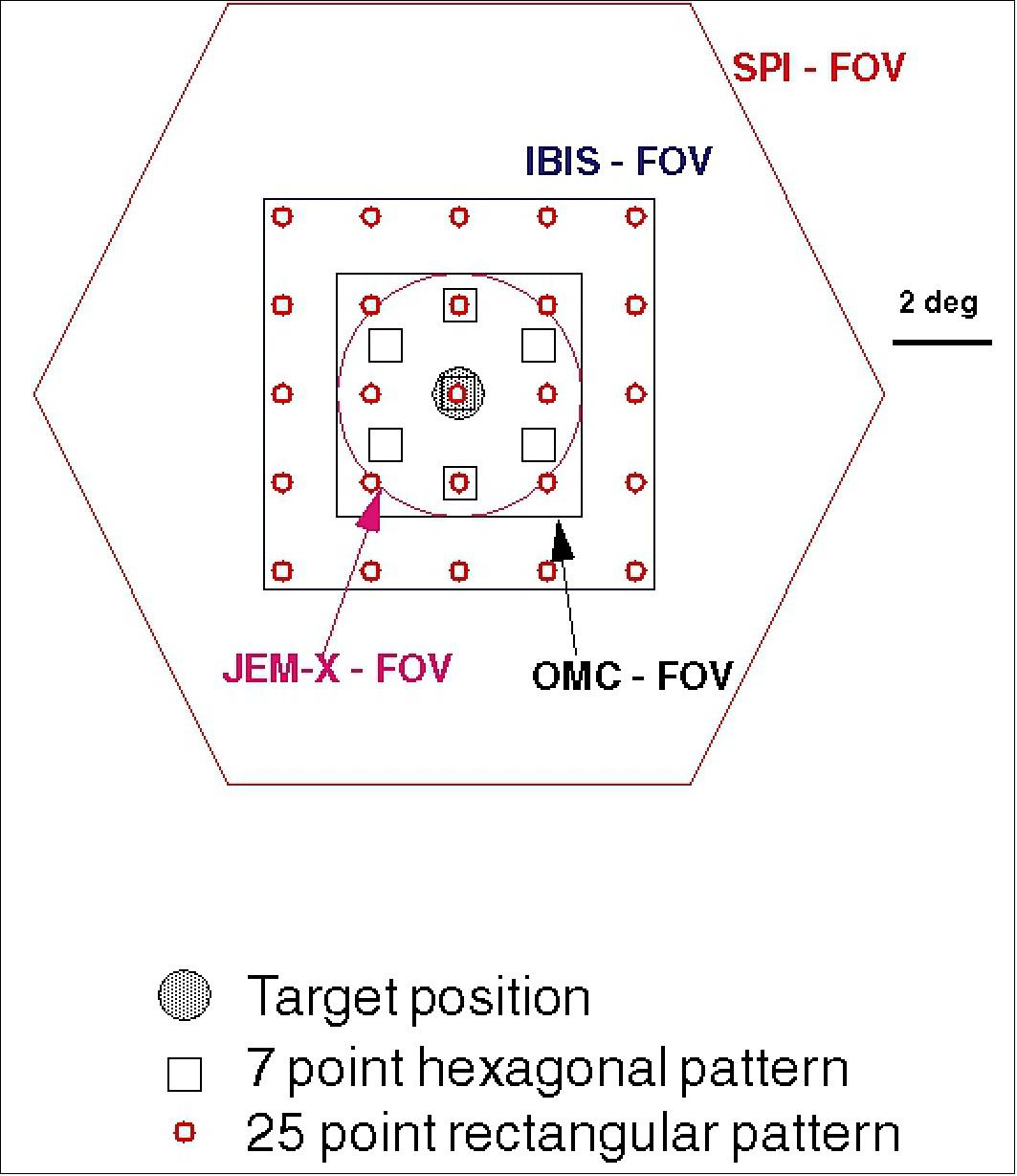
Autonomy
INTEGRAL has a large number of on-board autonomous functionalities despite it is operated in near-real time. This is mainly to control the spacecraft during unforeseen and planned periods with no ground contact and to recover from on-board anomalies where a quick reaction is required. INTEGRAL is designed to survive any 36 h outage period from ground assuming any single point failure. During the perigee passage there is a planned ground outage period of 4 to 6 h. During this period all the eclipses take place. Before and after an eclipse passage the spacecraft attitude and orbit control system and power system reconfigure itself as the Sun is not available for navigation and power source. A specific INTEGRAL feature is the BCP (Broad Cast Package) distributed on-board to all the instruments every 8 s. This BCP contains on-board generated information and on-ground loaded information and includes information about orbital events to which the instruments should react: (i) time/altitude when an observation can start or shall finish due to the radiation belts, (ii) time of eclipse entry to warn instruments before being switched off during eclipse, (iii) status of “On Target Flag”, which relates to the attitude stability. When the flag is set it indicates that instruments can start observations, e.g. after a slew, and, (iv) radiation monitor readings according to which the instruments shall power down the high voltage and go to safe mode, as soon as an instrument specific threshold is met. All these features are designed to optimize operational efficiency and protect the instruments in case of anomalies.
INTEGRAL has several on-board failure detection and recovery functionalities, which are mainly focussed on the attitude control and the on-board power system, which are the only two subsystems which eventually could endanger the survival of INTEGRAL in case of failure. The attitude and orbit control system operates with three hardware groups: nominal operation, failure detection and failure recovery. This ensures recovery for any single point failure. The failure recovery mode is a hardwired control mode using the thrusters for actuation. The spacecraft has in addition a software based onboard monitoring and action routine. Any onboard generated telemetry can be monitored, and in case a pre-set threshold is passed three consecutive times the defined action will be invoked. This function is already used to monitor the compressor power demand from the SPI cooling system. The function will be important later in the life cycle of INTEGRAL, when more onboard anomalies can be expected.
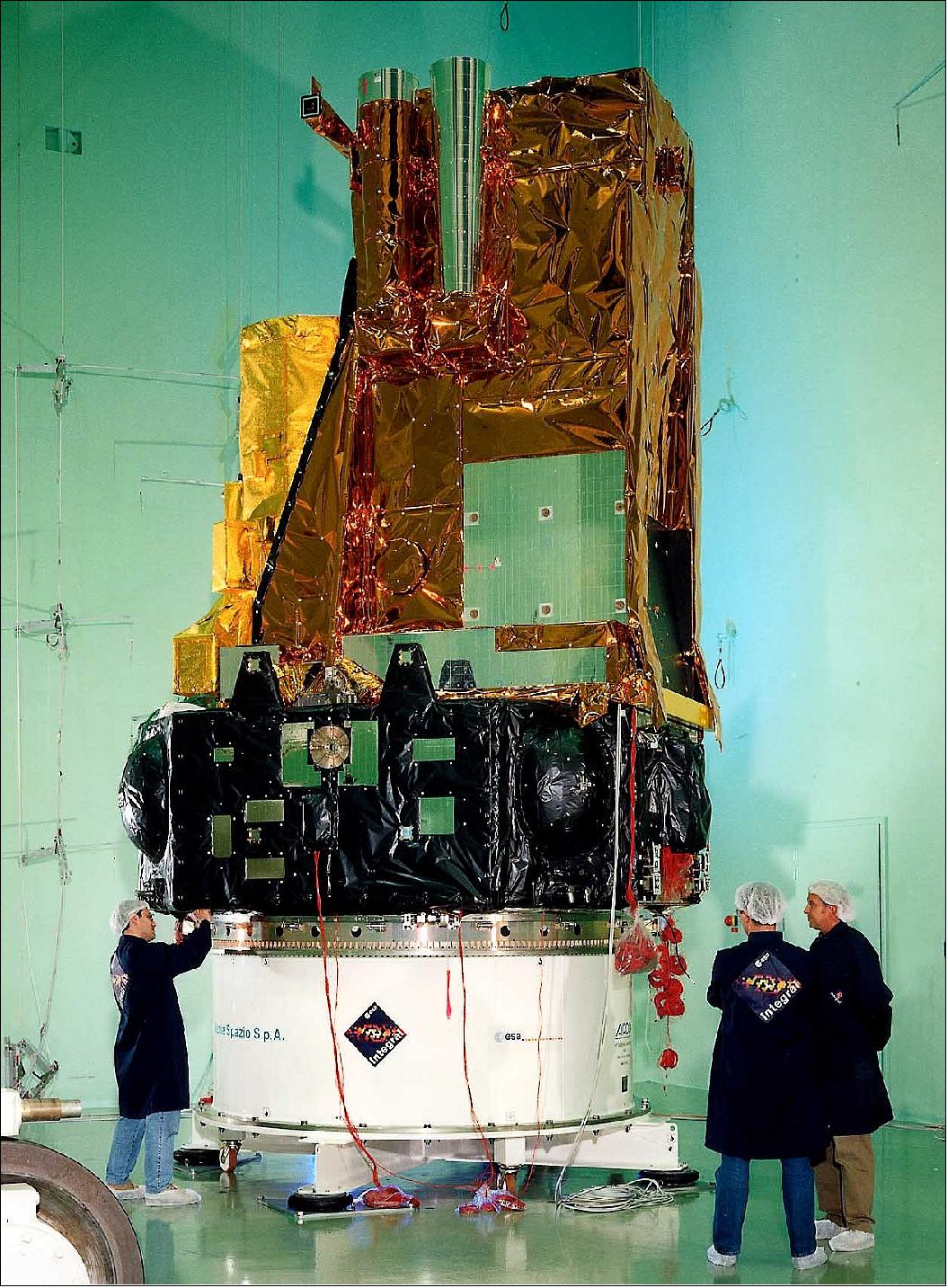
Launch
The INTEGRAL spacecraft was launched on 17 October 2002 by a Proton rocket, Russia's largest operational launch vehicle, from the Baikonur Cosmodrome in Kazakhstan. 4)
The Proton used three booster stages to place the spacecraft into a low ‘parking’ orbit. The Proton upper stage put the satellite into a highly eccentric 'transfer' orbit. Then INTEGRAL's own propulsion system brought the spacecraft to its operational 72-hour orbit.
Russia provided the launcher for INTEGRAL for free but in return for observation time. An arrangement between ESA and the Russian Space Agency (RSA) was signed in November 1997 and later approved by the Russian government in September 1999. As part of the arrangement, RSA shall be responsible for placing the satellite in the desired orbit using a Proton launcher, while ESA is responsible for delivering a satellite compatible with the launcher. In October 1999 a launcher adaptation contract was signed to ensure proper interfaces of the launcher with the satellite.
Orbit: INTEGRAL orbits Earth in HEO (Highly Elliptical Orbit) once every three days. It spends most of its time at an altitude higher than 60, 000 km - well outside Earth's radiation belts - to avoid the background radiation effects which would interfere with the measurement of gamma rays.
Its lowest point is 9,000 km (growing to 13,000 km after 5 years) and its highest point is 153,000 km. In addition to the orbit shape, the inclination (the angle compared with Earth's equator) also changes drastically during the 5 years.
The high and eccentric orbit guarantees long periods of uninterrupted observation with nearly constant background and away from trapped radiation in Earth's proton and electron belts. In this way, scientists can use more than 80% of the time spent in the orbit for scientific observations above an altitude of 60,000 km.
The orbital period of 72 hours is a multiple of 24 hours which guarantees an optimal coverage pattern from the ground stations. This coverage is continuous for INTEGRAL's orbit for all revolutions and allows repetitive working shifts on the ground.
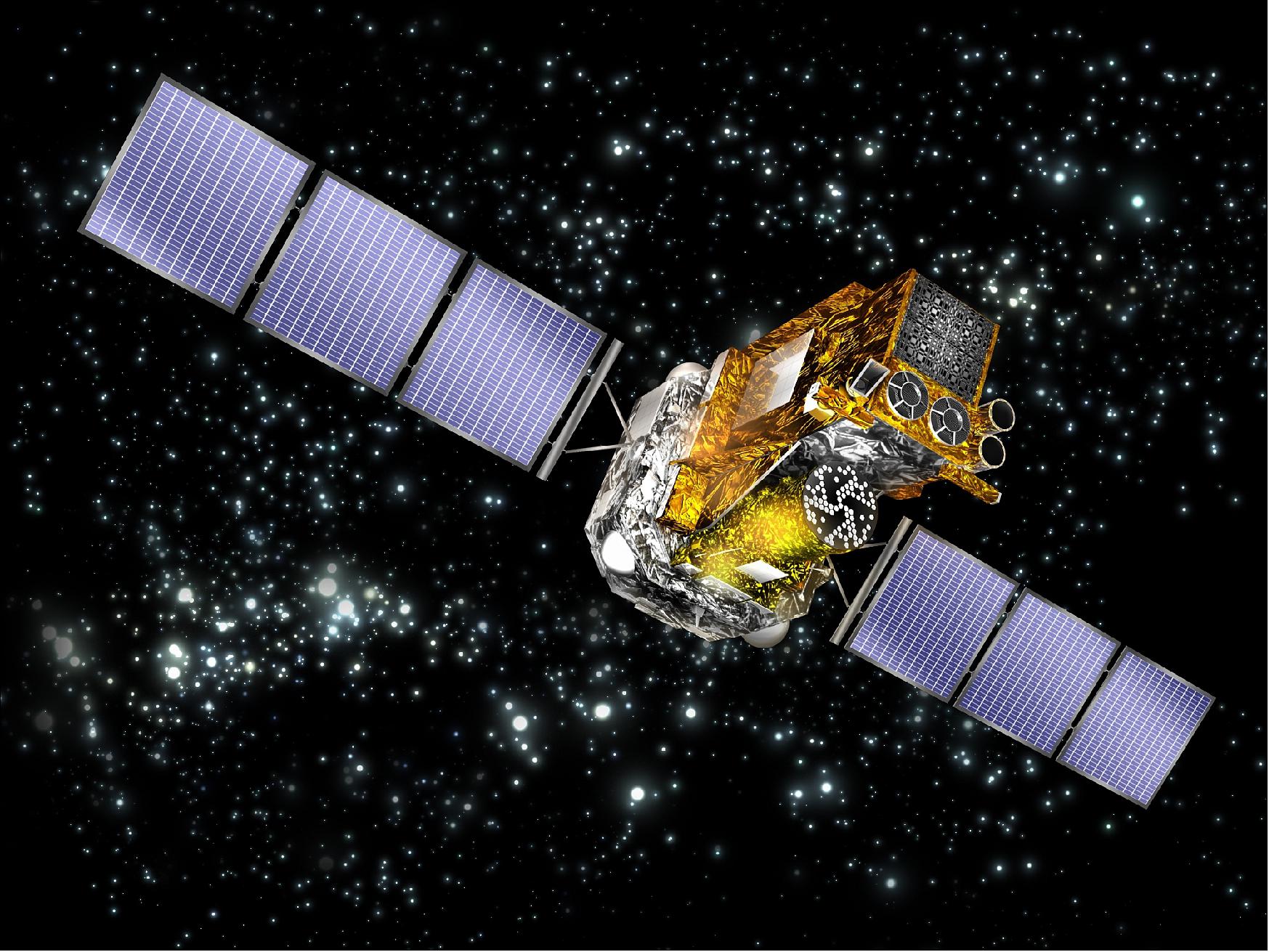
Mission Status
• October 18, 2021: On 22 September, around midday, ESA’s Integral spacecraft went into emergency Safe Mode. One of the spacecraft’s three active ‘reaction wheels’ had turned off without warning and stopped spinning, causing a ripple effect that meant the satellite itself began to rotate. 5)
- As a result of the spacecraft turning, data were only reaching ground control patchily and the batteries were quickly discharging. With just a few hours of power left, it seemed possible that the 19-year-old mission could be lost.
- The Integral Flight Control Team, together with Flight Dynamics and Ground Station Teams at ESA's ESOC mission control, teams at ESAC and Airbus Defence & Space, set to work. With quick thinking and ingenious solutions, they found the problem and rescued the mission.
What On Earth?
- A Single Event Upset (SEU) occurs when a charged particle strikes a sensitive part of electrical equipment, causing a one-off ‘change of state’ that disrupts its functioning. These charged, ‘ionized’ particles often come from the Sun when it spews out matter and energy during solar flares or coronal mass ejections.

- “I don't think that the SEU on this occasion was caused by our local, occasionally grumpy star. This strike happened on a day when no relevant space weather activity was observed,” explains Juha-Pekka Luntama, ESA’s Head of Space Weather.
- “Based on a discussion with our colleagues in the Flight Control Team, it looks like that the anomaly was triggered by charged particles trapped in the radiation belts around Earth.”
- The Van Allen radiation belts are two doughnut-shaped regions encircling Earth, where energetic charged particles are trapped inside Earth's magnetic field. Their properties vary according to solar activity and they represent a hazard to satellites and humans in space that pass through them. Because the lowest point of Integral’s orbit is now only 1500 km from Earth’s surface, the spacecraft passes through both radiation belts in its orbit.
‘Darmstadt, We Have A Problem’
- Integral uses ‘reaction wheels’ – wheels that store energy as they spin – to subtly control the direction the spacecraft points in without the need of thrusters.
- Suddenly, one of these reaction wheels stopped and, because of the law of conservation of energy, that turning force previously in the wheel had to go somewhere else – the entire spacecraft. The spacecraft began to spin, triggering an Emergency Safe Attitude Mode which unfortunately, due to a previous failure, was no longer reliable and did not manage to stabilize the mission.
- The reaction wheel was reactivated by teams on the ground, but the spacecraft kept spinning at an average rate of about 17 degrees per minute (roughly one rotation every 21 minutes), as well as wobbling unpredictably about its axes. This may not sound like much, but the spacecraft was rotating at five times its maximum when under control.
- “The data coming down from Integral was choppy, coming in for short periods due to it spinning. This made analysis even harder,” explains Richard Southworth, Operations Manager for the mission.
- “The batteries were discharging, as there were only short charging periods when the panels briefly faced the Sun.”
- The first challenge was to decrease Integral’s energy consumption to buy more time. First estimates of the charge remaining before blackout and the loss of the satellite was just three hours. Step by step, by turning off various instruments and non-critical components, this increased to more than six hours. Next step – stop the spinning.
- With support from industry experts, the team at ESOC analyzed the state of the reaction wheels, coming up with a series of commands to change their speed and brake the spinning satellite. By late afternoon, the commands were sent and immediately showed success, but another three long hours passed before the satellite was fully under control and out of immediate danger.
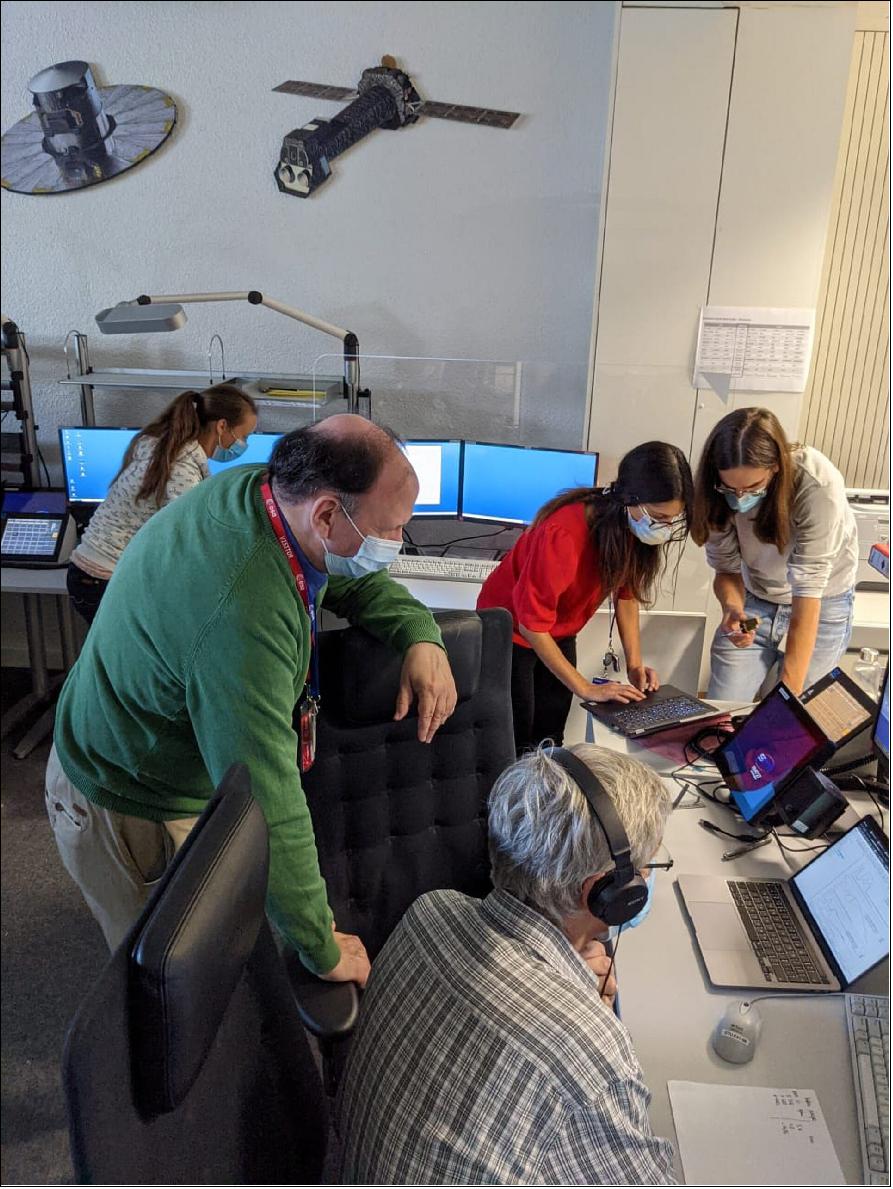
Integral’s ‘Apollo 13’ Moment
- “Everyone breathed a huge sigh of relief. This was very close, and we were immensely relieved to get the spacecraft out of this ‘near-death’ experience,” recalls Andreas Rudolph, Head of the Astronomy Missions Division in ESOC's Mission Operations Department. - “Most of the Control Team were working from home at this point – I was following operations from the train! – and worked until four in the morning to get the spacecraft fully stable, back into position and facing the Sun to recharge its batteries.”
- Unfortunately, a few hours later as the team reconvened to discuss the next steps, the spacecraft once again started to rotate, its reaction wheels again turning at high speed. The reason for this is still not completely understood but is thought to be associated with a ‘star tracker occultation’ or ‘blinding’ which wasn’t handled correctly by the satellite’s control systems – effectively when Earth gets in the way of the spacecraft’s view of the stars, which it uses to orient itself.

- The team repeated the previous days steps to stabilize the spacecraft and return to a Sun pointing position, this time without getting in the way of the star trackers. The recovery took just a couple of hours, putting in to practice the lessons learnt from the first time.
- Integral has since remained under control, and from 27 September all systems are back online. Since 1 October, after an extended checkout, its instruments are back observing the high energy Universe.
- One of the first targets for Integral will be to observe massive stars in the Orion region, and study the impact on their surroundings when they go supernova.
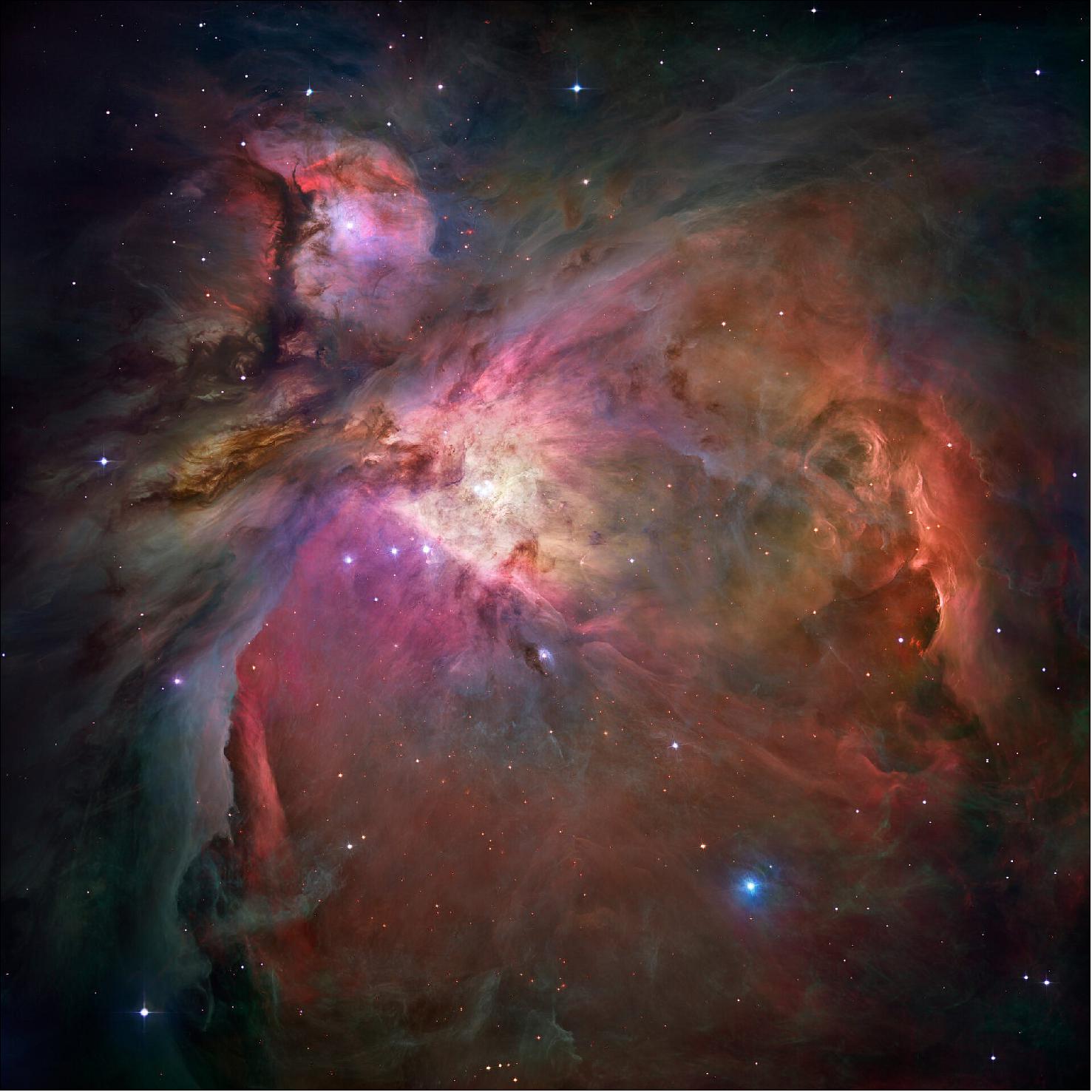
A Problem Of Thrust
- It’s not the first time this almost 20-year-old mission gave the control team at ESA’s ESOC Operations Centre a scare. Last year, Integral fired its thrusters for possibly the last planned time, after a failure with its propulsion system.
- It’s this deficient propulsion system that meant a normally rectifying Safe Mode was ineffective on this occasion. With the mode now disabled, the Control Team are working on a new automatic rescue sequence that should mimic many of the operations carried out after this anomaly, only much faster.
- When the propulsion system failed, the team realized they would have to learn to maneuver the four-ton satellite using its highly sensitive reaction wheels alone, to dump energy at regular periods and counteract forces on the spacecraft, including the gentle shove from the Sun’s light. It was a solution that had never been tried before.
- “I didn’t believe it was possible at first. We checked with our flight dynamics colleagues and the theory indicated it would work. After doing a simulation, we tested it on the spacecraft. It worked,” explains Richard.
- Thanks to our quick-witted team and the help of experts from across industry, Integral lives on. Almost two decades old, it is far outliving expectations for what was meant to be a five-year mission.”
• July 16, 2021: A year ago tomorrow, a failure on the Integral spacecraft meant it fired its thrusters for likely the last time. In the days since, the spacecraft in Earth orbit has continued to shed light on the violent gamma ray Universe, and it should soon be working even more efficiently than before, as mission control teams implement an ingenious new way to control the 18-year-old spacecraft. 6)
Mission Control, We Have A Problem
- In the summer 2020, while the Integral Flight Control Team in Germany were getting used to a very different working environment – learning to fly their mission from home while dealing with the uncertainty the COVID-19 pandemic created – the spacecraft decided to throw another spanner into the works.
- One day, Integral went into “Safe Mode” – when instruments are turned off and a spacecraft runs just its most basic functions, while facing the Sun to ensure it receives full power – alerting its control team to a problem. Under safe mode control, Integral seemed to go into an eclipse, a normal period of darkness as Earth gets between the spacecraft and the Sun. However, no eclipses were scheduled.
- “The satellite had suddenly rotated away from the Sun, which was a very unexpected and strange event. We’d never seen anything like this before”, explains Richard Southworth, Operations Manager for the mission.
- “It soon became clear we had a major problem. There was a general problem with Integral’s propulsion system. As we couldn’t trust its thrusters any more, we had to exit Safe Mode quickly, take over control of the spacecraft using its reaction wheels and then figure out what to do.”
Why Thrusters Matter To A Sensitive Mission
- As Integral is already in orbit, why do we still need its thrusters? To get rid of excess 'angular momentum'.
- Integral often points at a single source, for example a distant black hole, for many hours. During this time it is subject to external forces that cause it to rotate, in particular radiation pressure from the Sun acting on the spacecraft’s huge 18 meter solar arrays.
- To counteract this solar force and keep the spacecraft pointing at its target, the team uses “reaction wheels’’ – wheels that store energy as they spin, and can be used to subtly control the direction a spacecraft points in without the need of thrusters. These wheels “absorb” the extra energy from the Sun, keeping Integral in position and ensuring it remains the most sensitive gamma ray observatory ever flown.
- Over a couple of days, excess energy builds up in the reaction wheels in the form of “angular momentum” – the rotational equivalent of a force going in a straight line, for example the energy stored as you spin in a swivel chair.
- Every two to three days, the reaction wheels reach a maximum speed at which point they can't absorb any more momentum. The control team then performs a “momentum dump”, getting rid of excess angular momentum by decelerating the flywheels. In order to prevent the satellite rotating in the opposite direction as the wheels slow down, Integral’s thrusters are (normally) fired, stopping it going into a spin.
Inventing The “Z-flip”
- After days worrying over the fate of the mission, two team members came up with an idea.
- “I didn’t believe it was possible at first. We checked with our flight dynamics colleagues and the theory indicated it would work. After doing a simulation, we tested it on the spacecraft. It worked,” says Richard with relief.
- By using a specially designed sequence of maneuvers, the control team realized they could redistribute the angular momentum stored onboard the satellite using two different reaction wheels spinning in opposing directions, causing the spacecraft to flip.
- “So at this point we knew we could control the build up of energy absorbed from the Sun, and christened this new maneuver the “z-flip”. As far as I'm aware, this has never been done before. It was a great achievement, but could we continue to do science?”.

- After long and intensive discussions with colleagues at the Science Operations Centre in ESAC, Madrid, the team of scientific mission planners came up with a sequence of objects for Integral to observe that would fit within its new range of motion. The mission was fortunately back to (somewhat more limited) science operations.
- Gradually, the two teams experimented on more and more tricky sequences of observations, trying out different combinations of spinning wheels and flipping the spacecraft round various new angles. With dedicated teamwork between the control team and science operations team and many others, Integral’s scientific efficiency was restored by September 2020.
One Of ESA’s Oldest, Bulkiest Missions Gets Nimbler
- For most space observatories, observation schedules are planned well in advance. However every now and then something unexpected happens in the sky such as supernovae explosion or gravitational waves, and they need to respond quickly to take a look at what’s happened. This is particularly true for Integral, as gamma ray events tend to be short lived.
- “In the past when we had a propulsion system we would replan, calculate a new maneuver to the new object of interest, offload momentum and then prepare our new sequence of maneuvers. Our z-flip technique is unfortunately much slower,” explains Richard.
- However, the control team has developed an update to Integral’s onboard software that should make angular momentum less of an issue when pointing – slewing – the spacecraft.
- “We are very happy that thanks to this genius ‘z-flip’ strategy Integral can continue keeping an eye on the high-energy sky without problem”, says Erik Kuulkers, Integral Project Scientist.
- “And we now look forward to discoveries enabled by the new slewing mode, which means this 18 year old spacecraft should become even faster at responding to and observing sudden energetic events across the Universe than when it was launched almost two decades ago.”
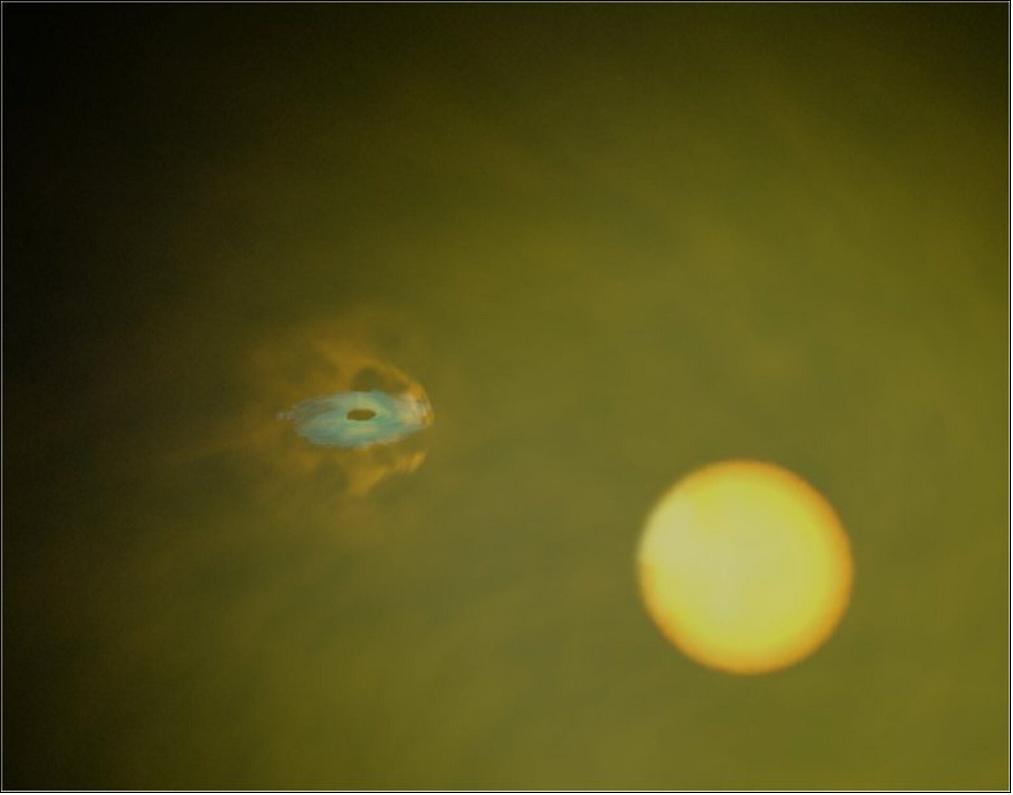
• July 28, 2020: ESA’s Integral helps unravel origin of Fast Radio Bursts. A global collaboration of telescopes including ESA’s Integral high-energy space observatory has detected a unique mix of radiation bursting from a dead star in our galaxy — something that has never been seen before in this type of star, and may solve a long-standing cosmic mystery. 7)
- The finding involves two kinds of interesting cosmic phenomena: magnetars and Fast Radio Bursts. Magnetars are stellar remnants with some of the most intense magnetic fields in the Universe. When they become ‘active’, they can produce short bursts of high-energy radiation that typically last for not even a second but are billions of times more luminous than the Sun.
- Fast Radio Bursts are one of astronomy’s major unsolved mysteries. First discovered in 2007, these events pulse brightly in radio waves for just a few milliseconds before fading away, and are only rarely seen again. Their true nature remains unknown, and no such burst has ever been observed either within the Milky Way, with a known origin, or emitting any other kind of radiation beyond the radio wave domain — until now.
- In late April, SGR 1935+2154, a magnetar discovered six years ago in the constellation of Vulpecula, following a substantial burst of X-rays, became active again. Soon after, astronomers spied something astonishing: this magnetar was not only radiating its usual X-rays, but radio waves, too.
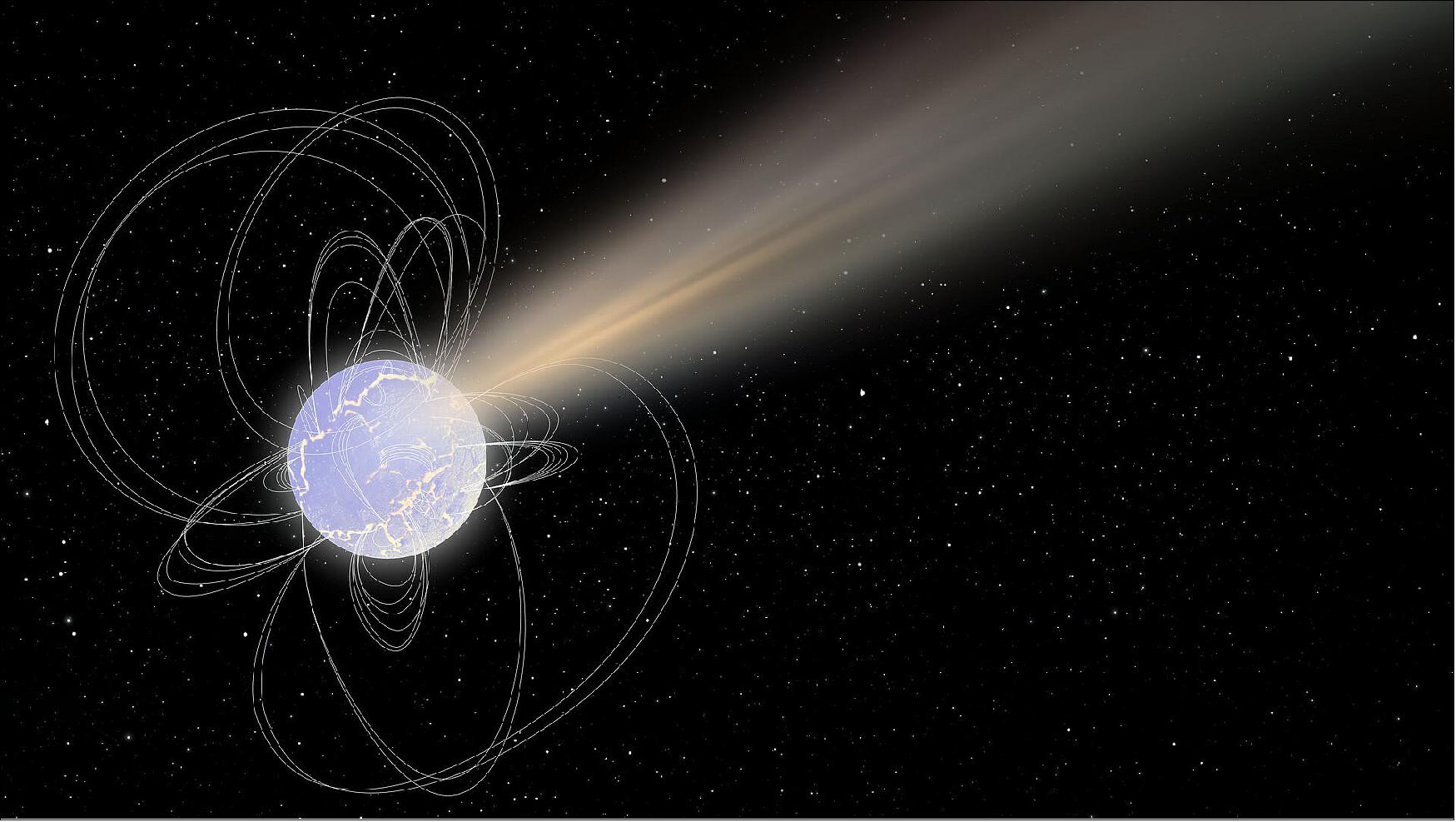
- “We detected the magnetar’s burst of high-energy, or ‘hard’, X-rays using Integral on 28 April,” says Sandro Mereghetti of the National Institute for Astrophysics (INAF–IASF) in Milan, Italy, lead author of a new study of this source based on the Integral data. 8)
- “The ‘Burst Alert System’ on Integral automatically alerted observatories worldwide about the discovery in just seconds. This was hours before any other alerts were issued, enabling the scientific community to act fast and explore this source in more detail.”
- Astronomers on the ground spotted a short and extremely bright burst of radio waves from the direction of SGR 1935+2154 using the CHIME radio telescope in Canada on the same day, over the same timeframe as the X-ray emission. This was independently confirmed a few hours later by the Survey for Transient Astronomical Radio Emission 2 (STARE2) in the US.
- “We’ve never seen a burst of radio waves, resembling a Fast Radio Burst, from a magnetar before,” adds Sandro.
- “Crucially, the IBIS imager on Integral allowed us to precisely pinpoint the origin of the burst, nailing its association with the magnetar,” says co-author Volodymyr Savchenko from the Integral Science Data Centre at the University of Geneva, Switzerland.
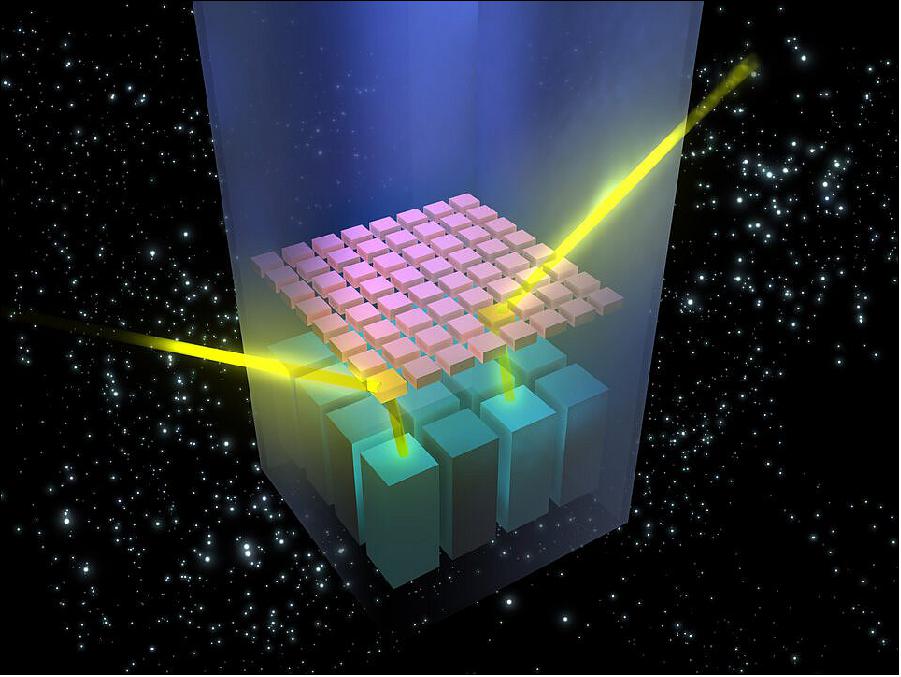
- “Most of the other satellites involved in the collaborative study of this event weren’t able to measure its position in the sky — and this was crucial in identifying that the emission did indeed come from SGR1935+2154.”
- “This is the first ever observational connection between magnetars and Fast Radio Bursts,” explains Sandro.
- “It truly is a major discovery, and helps to bring the origin of these mysterious phenomena into focus.”
- Launched in 2002, Integral carries a suite of four instruments able to simultaneously observe and take images of cosmic objects in gamma rays, X-rays, and visible light.
- At the time of the burst, the magnetar happened to be in the 30 degree by 30 degree field of view of the IBIS instrument, leading to an automatic detection by the satellite’s Burst Alert System software package – operated by the the Integral Science Data Centre in Geneva – immediately alerting observatories worldwide. At the same time, the Spectrometer on Integral (SPI) also detected the of X-rays burst, along with another space mission, China’s Insight Hard X-ray Modulation Telescope (HXMT).
- “This kind of collaborative, multi-wavelength approach and resulting discovery highlights the importance of timely, large-scale coordination of scientific research efforts,” adds ESA’s Integral project scientist Erik Kuulkers.
- “By bringing together observations from the high-energy part of the spectrum all the way to radio waves, from across the globe and in space, scientists have been able to elucidate a long-standing mystery in astronomy. We’re thrilled that Integral played a key role in this.”
• April 29, 2019: Data from ESA’s Integral high-energy observatory have helped shed light on the workings of a mysterious black hole found spitting out ‘bullets’ of plasma while rotating through space. 9)
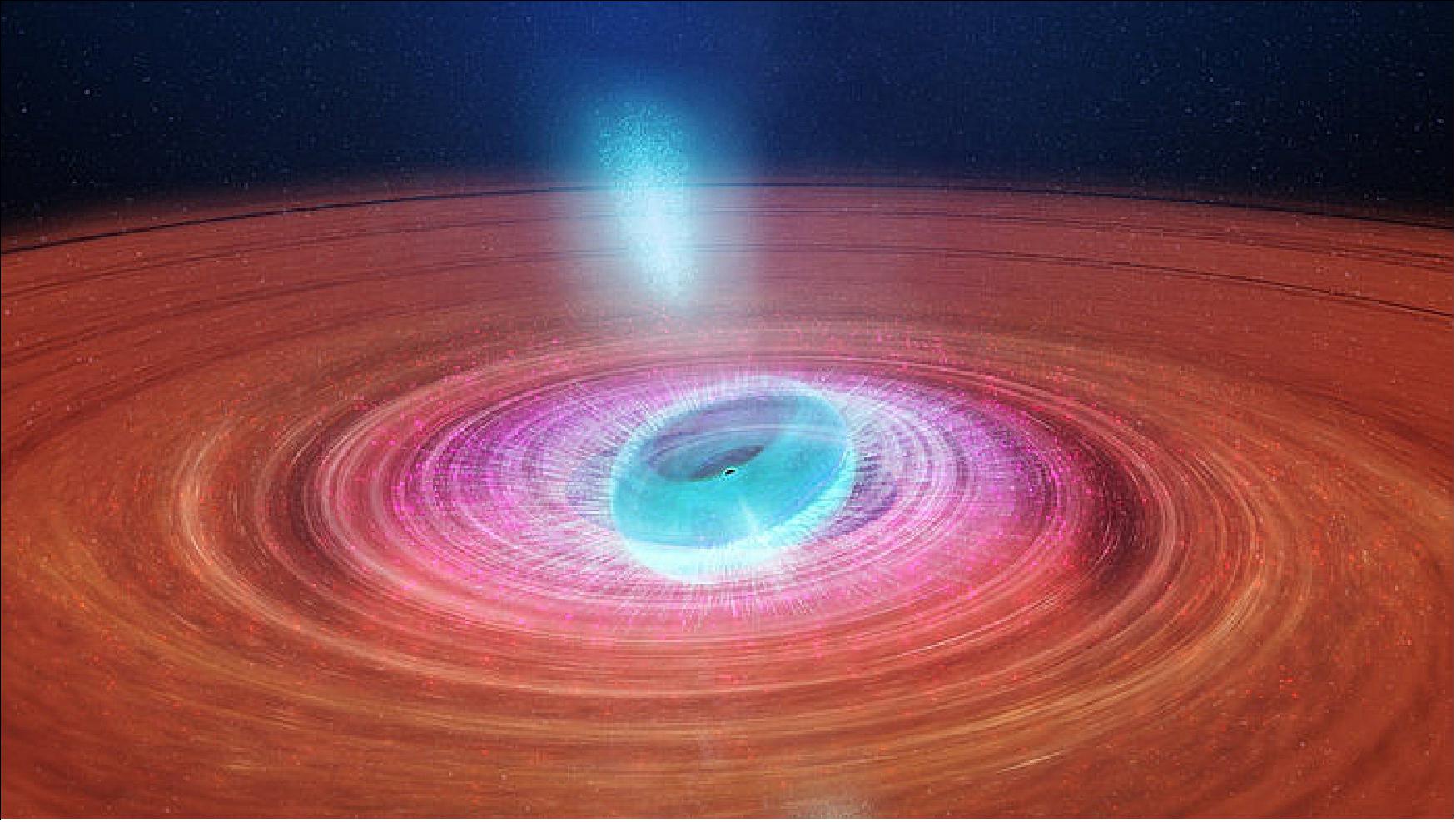
- The black hole is part of a binary system known as V404 Cygni and is sucking in material from a companion star. It is located in our Milky Way, some 8000 light-years away from Earth, and was first identified in 1989, when it caused a huge outburst of high-energy radiation and material.
- After 26 years of dormancy, it woke up again in 2015, becoming for a short period of time the brightest object in the sky observable in high-energy X-rays.
- Astronomers from all over the world pointed their ground and space-based telescopes towards the celestial object, and discovered that the black hole was behaving somewhat strangely.
- A new study, based on data collected during the 2015 outburst, has now revealed the inner workings of this cosmic monster. The results are reported today in the journal Nature. 10)
- “During the outburst we observed details of the jet emissions when material is ejected at a very high speed from the vicinity of the black hole,” says Simone Migliari, an astrophysicist at ESA who is a co-author on the paper.
- “We can see the jets shooting out in different directions on a timescale of less than an hour, which means that the inner regions of the system are rotating quite fast.”
- Usually astronomers see the jets shooting straight out from the poles of black holes, perpendicular to the surrounding disc of material that is accreted from the companion star.
- Previously, there had only been one black hole observed with a rotating jet. It was, however, rotating much slower, completing one cycle in about six months.
- The astronomers could observe the V404 Cygni jets in radio waves using telescopes like those of the Very Long Baseline Array in the US.
- Meanwhile, high-energy X-ray data from Integral and other space observatories helped them decode what was happening at the same time inside the inner region of the 10 million kilometer-wide accretion disc. This was important since it is the mechanics of the disc that causes the jet’s strange behavior.
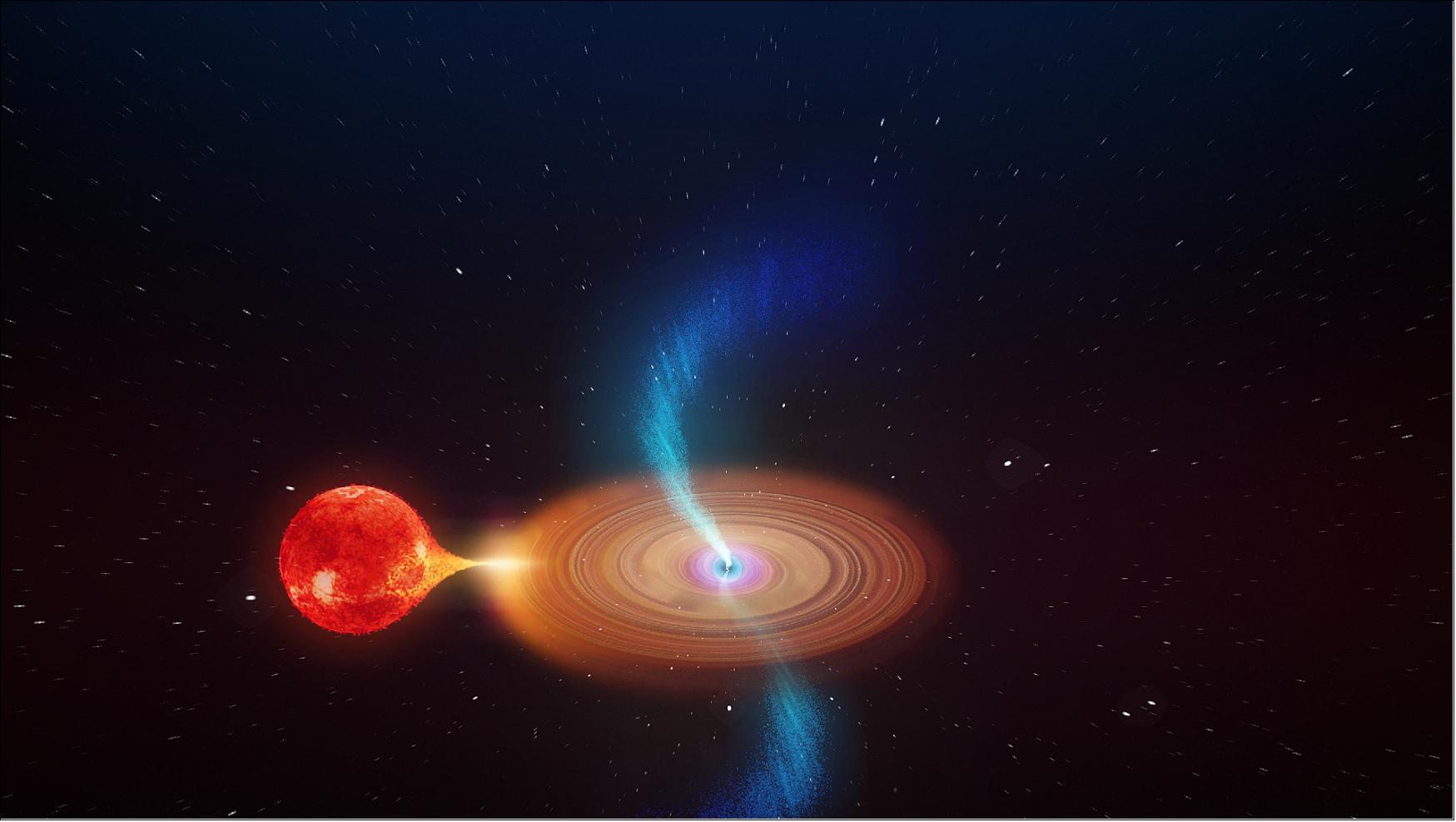
- “What’s different in V404 Cygni is that we think the disc of material and the black hole are misaligned,” says Associate Professor James Miller-Jones, from ICRAR (International Centre for Radio Astronomy Research) at Curtin University, Australia, who is the lead author of the new paper. “This appears to be causing the inner part of the disc to wobble like a spinning top that is slowing down, and fire jets out in different directions as it changes orientation.”
- During the outburst, a large amount of the surrounding material was falling into the black hole at once, temporarily increasing the accretion rate of disc material towards the black hole and resulting in a sudden surge of energy. This was seen by Integral as an abrupt increase of the X-ray emission.
- Integral’s observations were used to estimate the energy and geometry of the accretion onto the black hole, which in turn were crucial to understand the link between the incoming and outflowing material to create a complete picture of the situation.
- “With Integral, we were able to keep looking at V404 Cygni continuously for four weeks, while other high-energy satellites could only take shorter snapshots,” says Erik Kuulkers, Integral Project Scientist at ESA.
- “The X-ray data support a model where the inner part of the accretion disc is tilted with respect to the rest of the system, most likely due to the spin of the black hole being inclined with respect to the orbit of the companion star,” explains Simone.
- Scientists have been studying what caused this strange misalignment. One possibility is that the black hole spin axis may have been tilted by the ‘kick’ received during the supernova explosion that created it.
- “The results would fit in a scenario, also studied in recent computer simulations, where the accretion flow in the vicinity of the black hole and the jets can rotate together,” says Erik. “We should expect similar dynamics in any strongly-accreting black hole whose spin is misaligned with the inflowing gas, and we will have to take into account varying jet inclination angles when interpreting observations of black holes across the Universe.”
• January 10, 2019: ESA's high-energy space telescopes INTEGRAL and XMM-Newton have helped to find a source of powerful X-rays at the center of an unprecedentedly bright and rapidly evolving stellar explosion that suddenly appeared in the sky earlier this year. 11) 12)
- The ATLAS (Asteroid Terrestrial-impact Last Alert System) telescope in Hawaii first spotted the phenomenon, since then named AT2018cow - and nicknamed "the Cow" after the coincidental final letters in its official name - on 16 June. Soon after that, astronomers all over the world were pointing many space- and ground-based telescopes towards the newly found celestial object, located in a galaxy some 200 million light years away.
- They soon realized this was something completely new. In only two days the object exceeded the brightness of any previously observed supernova – a powerful explosion of an aging massive star that expels most of its material into the surrounding space, sweeping up the interstellar dust and gases in its vicinity.
- A new paper, accepted for publication in the Astrophysical Journal, presents the observations from the first 100 days of the object's existence, covering the entire electromagnetic spectrum of the explosion from radio waves to gamma rays. 13)
- The analysis, which includes observations from ESA's INTEGRAL and XMM-Newton, as well as NASA's NuSTAR and Swift space telescopes, found a source of high-energy X-rays sitting deep inside the explosion.
- The behavior of this source, or engine, as revealed in the data, suggests that the strange phenomenon could either be a nascent black hole or neutron star with a powerful magnetic field, sucking in the surrounding material.
- "The most exciting interpretation is that we might have seen for the first time the birth of a black hole or a neutron star," says Raffaella Margutti of Northwestern University, USA, lead author of the paper.
- "We know that black holes and neutron stars form when stars collapse and explode as a supernova, but never before have we seen one right at the time of birth," adds co-author Indrek Vurm of Tartu Observatory, Estonia, who worked on modelling the observations.
- The AT2018cow explosion was not only 10 to 100 times brighter than any other supernova previously observed: it also reached peak luminosity much faster than any other previously known event – in only a few days compared to the usual two weeks.
- INTEGRAL made its first observations of the phenomenon about five days after it had been reported and kept monitoring it for 17 days. Its data proved crucial for the understanding of the strange object.
- "INTEGRAL covers a wavelength range which is not covered by any other satellite," says Erik Kuulkers, INTEGRAL project scientist at ESA. "We have a certain overlap with NuSTAR in the high-energy X-ray part of the spectrum but we can see higher energies, too."
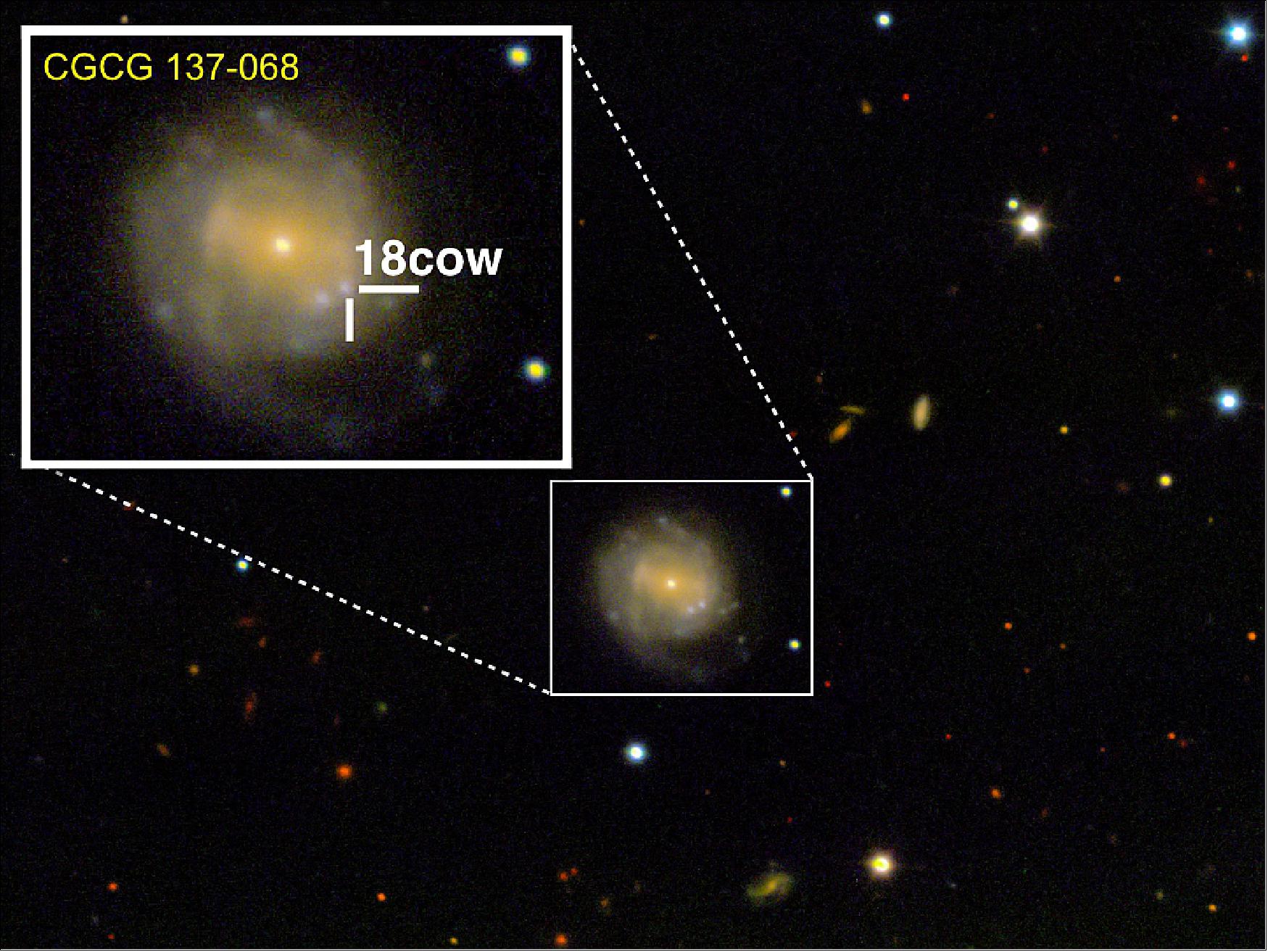
Legend to Figure 19: The insert in the top left shows a zoom onto the galaxy, indicating the location of the supernova. - The supernova was first spotted on 16 June 2018 with the ATLAS telescope, also in Hawaii. Further observations performed with a large team of telescopes – including ESA's high-energy space telescopes INTEGRAL and XMM-Newton – revealed a source of powerful X-rays at the center of this unprecedentedly bright and rapidly evolving stellar explosion, suggesting that it could either be a nascent black hole or neutron star with a powerful magnetic field, sucking in the surrounding material.
- So while data from NuSTAR revealed the hard X-ray spectrum in great detail, with INTEGRAL the astronomers were able to see the spectrum of the source entirely, including its upper limit at soft gamma-ray energies.
- "We saw a kind of a bump with a sharp cut-off in the spectrum at the high energy end," says Volodymyr Savchenko, an astronomer at the University of Geneva, Switzerland, who worked on the INTEGRAL data. "This bump is an additional component of the radiation released by this explosion, shining through an opaque, or optically thick, medium."
- "This high-energy radiation most likely came from an area of very hot and dense plasma surrounding the source," adds Carlo Ferrigno, also of the University of Geneva.

- Because INTEGRAL kept monitoring the AT2018cow explosion over a longer period of time, its data was also able to show that the high-energy X-ray signal was gradually fading.
- Raffaella explains that this high-energy X-ray radiation that went away was the so-called reprocessed radiation – radiation from the source interacting with material ejected by the explosion. As the material travels away from the center of the explosion, the signal gradually wanes and eventually disappears completely.
- In this signal, however, the astronomers were able to find patterns typical of an object that draws in matter from its surroundings – either a black hole or a neutron star.
- "This is the most unusual thing that we have observed in AT2018cow and it's definitely something unprecedented in the world of explosive transient astronomical events," says Raffaella.
- Meanwhile, XMM-Newton looked at this unusual explosion twice over the first 100 days of its existence. It detected the lower-energy part of its X-ray emission, which, according to the astronomers, comes directly from the engine at the core of the explosion. Unlike the high-energy X-rays coming from the surrounding plasma, the lower-energy X-rays from the source are still visible.
- The astronomers plan to use XMM-Newton to perform a follow-up observation in the future, which will allow them to understand the source's behavior over a longer period of time in greater detail.
- "We are continuing to analyze the XMM-Newton data to try to understand the nature of the source," says co-author Giulia Migliori of University of Bologna, Italy, who worked on the X-ray data. "Accreting black holes leave characteristic imprints in X-rays, which we might be able to detect in our data."
- "This event was completely unexpected and it shows that there is a lot of which we don't completely understand," says Norbert Schartel, ESA's XMM-Newton project scientist. "One satellite, one instrument alone, would never be able to understand such a complex object. The detailed insights we were able to gather into the inner workings of the mysterious AT2018cow explosion were only achievable thanks to the broad cooperation and combination of many telescopes."
• November 19, 2018: ESA’s Integral satellite has been scouring the skies around the Earth for signs of high-energy radiation since 2002, observing particles thrown off by extreme phenomena such as black holes, neutron stars, and supernova explosions. On 10 November 2015, the probe serendipitously spotted something especially interesting – and a little closer to home: intense auroras dancing around Earth’s north pole. 14)
- Integral was initially preparing for astronomical research when it spied this aurora; the probe was planning to observe the skies at X-ray wavelengths to measure something known as the cosmic X-ray background, a diffuse level of radiation that pervades the cosmos and is linked to high-energy events such as black holes devouring nearby material in far away galaxies. This background is subtle and tricky to detect – and in this case, the unexpectedly strong auroras illuminating the Earth drowned it out.
- However, the observations were far from wasted. They may be known for their breath-taking light shows, but auroras can reveal much about the space surrounding our planet. They are created as particles from the solar wind enter the upper layers of our atmosphere and interact with matter there, triggering bursts of light and filling the sky with their characteristic glimmering, rippling sheets of color.
- Auroras are transient and difficult to predict; capturing such an intense example with Integral helped scientists to understand more about the distribution and amount of charged particles surrounding our planet, and to characterize the interaction between the Sun and our magnetosphere – the region of space over which the Earth’s magnetic field dominates. Read more about the observations, which were reported on in 2016, here.
- Integral took the X-ray images using the IBIS (Imager on Board the INTEGRAL Satellite) instrument at roughly eight minute intervals. The size, orientation and position of our planet within the frame changes from image to image with Integral’s position in orbit; the spacecraft travels on a highly eccentric 64-hour orbit, coming as close as 10,000 km and as distant as 140,000 km from Earth.
![Figure 21: This image is a single frame from a longer sequence of images, and shows the auroras forming a rough semi-circle at Earth’s northern latitudes. The auroras were first spotted around east Siberia, north of Japan, at around 11:00 GMT, and later seen lingering over a wider area on the opposite side of the planet above Canada and Greenland [image credit: ESA/Integral/ E. Churazov (IKI/MPA)/ M. Türler (ISDC/Univ. of Geneva)]](https://eoportal.org/ftp/satellite-missions/i/INTEGRAL_20102021/INTEGRAL_Auto26.jpeg)
Extended life for ESA's science missions 15)
• November 14, 2018: The SPC (Science Program Committee) of ESA has confirmed the continued operations of ten scientific missions in the Agency's fleet up to 2022. After a comprehensive review of their scientific merits and technical status, the SPC has decided to extend the operation of the five missions led by ESA's Science Program: Cluster, Gaia, INTEGRAL, Mars Express, and XMM-Newton. The SPC also confirmed the Agency's contributions to the extended operations of Hinode, Hubble, IRIS, SOHO, and ExoMars TGO. 15)
- This includes the confirmation of operations for the 2019–2020 cycle for missions that had been given indicative extensions as part of the previous extension process, and indicative extensions for an additional two years, up to 2022.
Note: Every two years, all missions whose approved operations end within the following four years are subject to review by the advisory structure of the Science Directorate. Extensions are granted to missions that satisfy the established criteria for operational status and science return, subject to the level of financial resources available in the science program. These extensions are valid for the following four years, subject to a mid-term review and confirmation after two years.
- The decision was taken during the SPC meeting at ESA/ESAC (European Space Astronomy Center) near Madrid, Spain, on 14 November.
- ESA's science missions have unique capabilities and are prolific in their scientific output. Cluster, for example, is the only mission that, by varying the separation between its four spacecraft, allows multipoint measurements of the magnetosphere in different regions and at different scales, while Gaia is performing the most precise astrometric survey ever realized, enabling unprecedented studies of the distribution and motions of stars in the Milky Way and beyond.
- Many of the science missions are proving to be of great value to pursue investigations that were not foreseen at the time of their launch. Examples include the role of INTEGRAL and XMM-Newton in the follow-up of recent gravitational wave detections, paving the way for the future of multi-messenger astronomy, and the many discoveries of diverse exoplanets by Hubble.
- Collaboration between missions, including those led by partner agencies, is also of great importance. The interplay between solar missions like Hinode, IRIS and SOHO provides an extensive suite of complementary instruments to study our Sun; meanwhile, Mars Express and ExoMars TGO are at the forefront of the international fleet investigating the Red Planet.
- Another compelling factor to support the extension is the introduction of new modes of operation to accommodate the evolving needs of the scientific community, as well as new opportunities for scientists to get involved with the missions.
• July 12, 2018: An international team of scientists has found first evidence of a source of high-energy neutrinos: a flaring active galaxy, or blazar, 4 billion light years from Earth. Following a detection by the IceCube Neutrino Observatory (Antarctica) on 22 September 2017, ESA's INTEGRAL satellite joined a collaboration of observatories in space and on the ground that kept an eye on the neutrino source, heralding the thrilling future of multi-messenger astronomy. 16)
- Neutrinos are nearly massless, ‘ghostly’ particles that travel essentially unhindered through space at close to the speed of light. Despite being some of the most abundant particles in the Universe – 100 000 billion pass through our bodies every second – these electrically neutral, subatomic particles are notoriously difficult to detect because they interact with matter incredibly rarely.
- While primordial neutrinos were created during the Big Bang, more of these elusive particles are routinely produced in nuclear reactions across the cosmos. The majority of neutrinos arriving at Earth derive from the Sun, but those that reach us with the highest energies are thought to stem from the same sources as cosmic rays – highly energetic particles originating from exotic sources outside the Solar System.
- Unlike neutrinos, cosmic rays are charged particles and so their path is bent by magnetic fields, even weak ones. The neutral charge of neutrinos instead means they are unaffected by magnetic fields, and because they pass almost entirely through matter they can be used to trace a straight path all the way back to their source.
- Acting as ‘messengers’, neutrinos directly carry astronomical information from the far reaches of the Universe. Over the past decades, several instruments have been built on Earth and in space to decode their messages, though detecting these particles is no easy feat. In particular, the source of high-energy neutrinos has, until now, remained unproven.
- On 22 September 2017, one of these high-energy neutrinos arrived at the IceCube Neutrino Observatory at the South Pole. The event was named IceCube-170922A.
Note: The IceCube Collaboration is funded primarily by the NSF (National Science Foundation) and is operated by a team headquartered at the University of Wisconsin–Madison, USA. The research efforts, including critical contributions to the detector operation, are supported by funding agencies in Australia, Belgium, Canada, Denmark, Germany, Japan, New Zealand, Republic of Korea, Sweden, Switzerland, the United Kingdom, and the USA.
- The IceCube observatory, which encompasses a cubic kilometer of deep, pristine ice, detects neutrinos through their secondary particles, muons. These muons are produced on the rare occasion that a neutrino interacts with matter in the vicinity of the detector, and they create tracks, kilometers in length, as they pass through layers of Antarctic ice. Their long paths mean their position can be well defined, and the source of the parent neutrino can be pinned down in the sky.
- During the 22 September event, a traversing muon deposited 22 TeV of energy in the IceCube detector. From this, scientists estimated the energy of the parent neutrino to be around 290 TeV, indicating a 50 percent chance that it had an astrophysical origin beyond the Solar System.
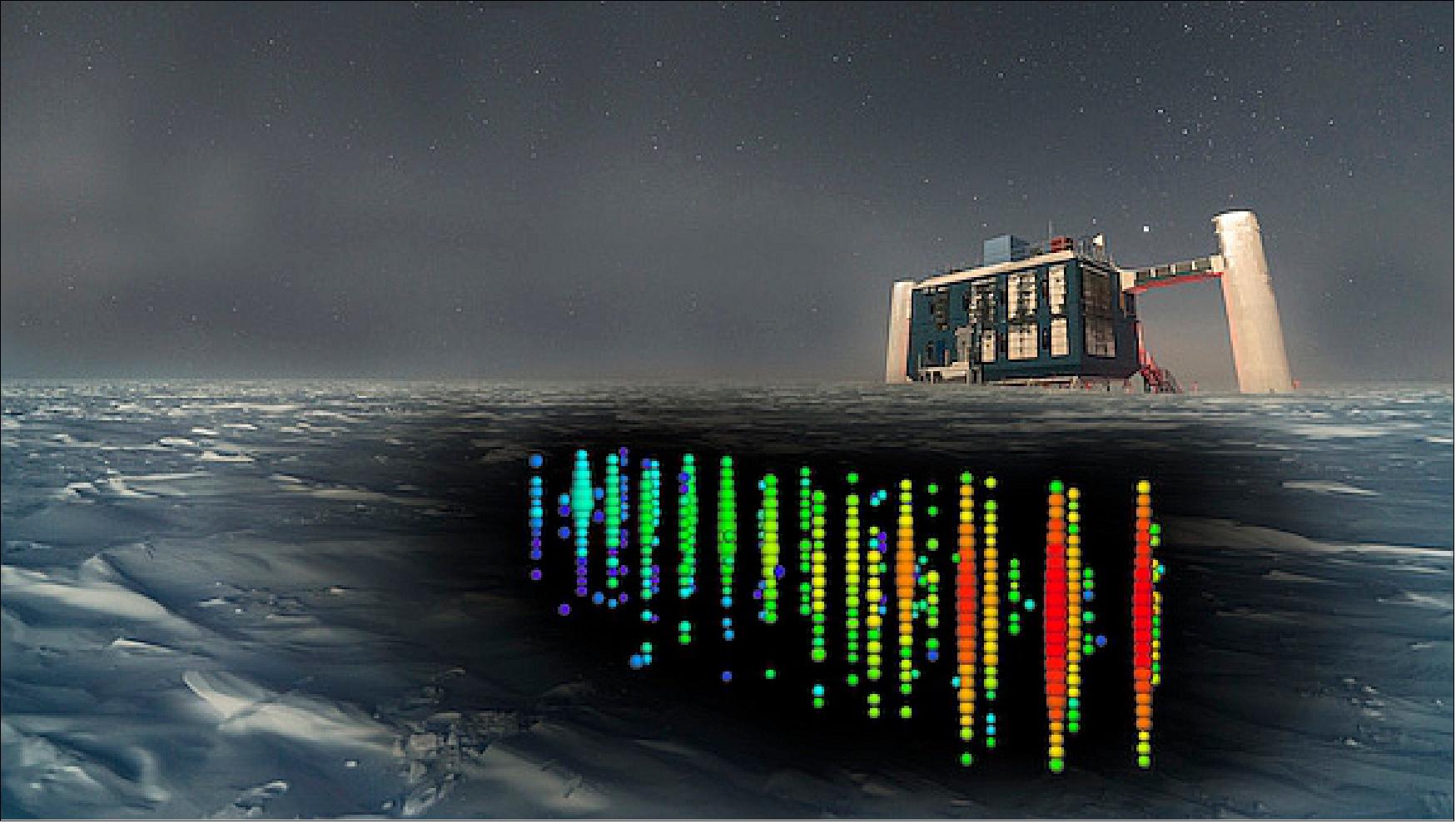
- When the origin of a neutrino cannot be robustly identified by IceCube, like in this case, multi-wavelength observations are required to investigate its source. So, following the detection, IceCube scientists circulated the coordinates in the sky of the neutrino’s origin, inferred from their observations, to a worldwide network of ground and space-based observatories working across the full electromagnetic spectrum.
- These included NASA's Fermi gamma-ray space telescope and the MAGIC (Major Atmospheric Gamma-Ray Imaging Cherenkov ) on La Palma, in the Canary Islands, which looked to this portion of the sky and found the known blazar, TXS 0506+056, in a ‘flaring’ state – a period of intense high-energy emission – at the same time the neutrino was detected at the South Pole.
- Blazars are the central cores of giant galaxies that host an actively accreting supermassive black-hole at their heart, where matter spiralling in forms a hot, rotating disc that generates enormous amounts of energy, along with a pair of relativistic jets.
- These jets are colossal columns that funnel radiation, photons and particles – including neutrinos and cosmic rays – tens of light years away from the central black hole at speeds very close to the speed of light. A specific feature of blazars is that one of these jets happens to point towards Earth, making its emission appear exceptionally bright.
- Scientists around the world began observing this blazar – the likely source of the neutrino detected by IceCube – in a variety of wavelengths, from radio waves to high-energy gamma rays. ESA's INTEGRAL gamma-ray observatory was part of this international collaboration. 17)
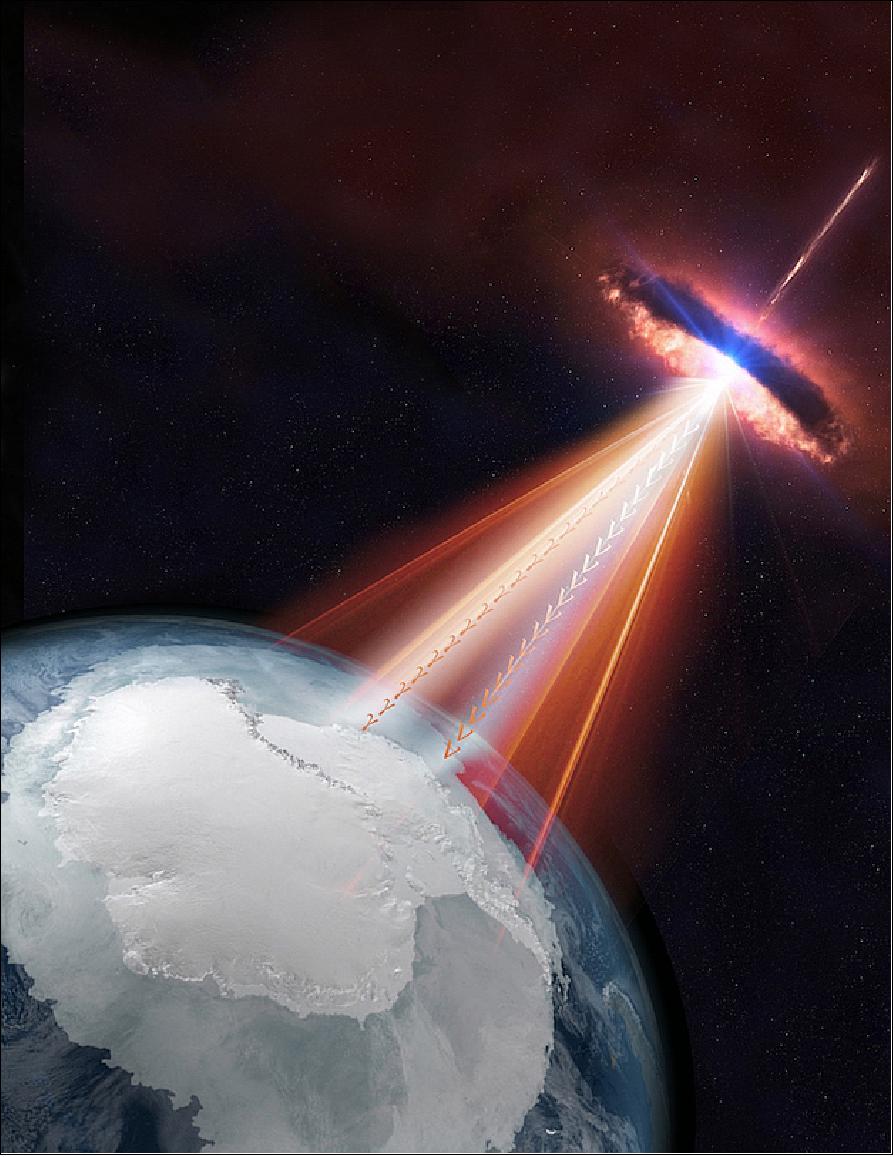
Note: Blazars are a type of active galaxy with one of its jets pointing toward Earth. In this artistic rendering, a blazar emits both neutrinos and gamma rays, like in the case of the IceCube-170922A event, recorded on 22 September 2017. On this occasion, the IceCube Neutrino Observatory at the South Pole detected a neutrino while at the same time gamma rays, coming from the same direction in the sky, were detected by other telescopes on Earth and in space.
• March 5, 2018: ESA’s Integral space observatory has witnessed a rare event: the moment that winds emitted by a swollen red giant star revived its slow-spinning companion, the core of a dead star, bringing it back to life in a flash of X-rays. 18)
- The X-ray flare was first detected by Integral on 13 August 2017 from an unknown source in the direction of the crowded center of our Milky Way. The sudden detection triggered a slew of follow-up observations in the following weeks to pin down the culprit.
- The observations revealed a strongly magnetized and slowly rotating neutron star that had likely just begun to feed on material from a neighboring red giant star.

- Stars the mass of our Sun, and up to eight times more massive, evolve into red giants towards the end of their lives. Their outer layers puff up and expand millions of kilometers, their dusty, gassy shells blown away from the central star in relatively slow winds up to few hundreds of km/s.
- Even larger stars, up to 25–30 times more massive than the Sun, race through their fuel and explode in a supernova, sometimes leaving behind a spinning stellar corpse with a strong magnetic field, known as a neutron star. This tiny core packs the mass of nearly one and half Suns into a sphere only 10 km across, making them some of the densest celestial objects known.
- It is not uncommon to find stars paired together, but the new system of a neutron star and red giant is a particularly rare breed known as a ‘symbiotic X-ray binary’, with no more than 10 known.
- “Integral caught a unique moment in the birth of a rare binary system,” says Enrico Bozzo from the University of Geneva and lead author of the paper that describes the discovery. 19) “The red giant released a sufficiently dense slow wind to feed its neutron star companion, giving rise to high-energy emission from the dead stellar core for the first time.”
- The pairing is certainly peculiar. ESA’s XMM-Newton and NASA’s NuSTAR space telescopes showed that the neutron star spins almost every two hours – very slow compared with other neutron stars, which can spin up to many times per second. Then, the first measurement of the magnetic field of such a neutron star revealed it to be surprisingly strong.
- A strong magnetic field typically points to a young neutron star – the magnetic field is thought to fade over time – while a red giant is much older, making it a bizarre couple to have grown up together.
- “These objects are puzzling,” says Enrico. “It might be that either the neutron star magnetic field does not decay substantially with time after all, or the neutron star actually formed later in the history of the binary system. That would mean it collapsed from a white dwarf into a neutron star as a result of feeding off the red giant over a long time, rather than becoming a neutron star as a result of a more traditional supernova explosion of a short-lived massive star.”
- With a young neutron star and an old red giant, at some point the winds travelling from the puffed-up giant will begin to rain on to the smaller star, slowing its spin and emitting X-rays.
- “We haven’t seen this object before in the past 15 years of our observations with Integral, so we believe we saw the X-rays turning on for the first time,” says Erik Kuulkers, ESA’s Integral project scientist. “We’ll continue to watch how it behaves in case it is just a long ‘burp’ of winds, but so far we haven’t seen any significant changes.”
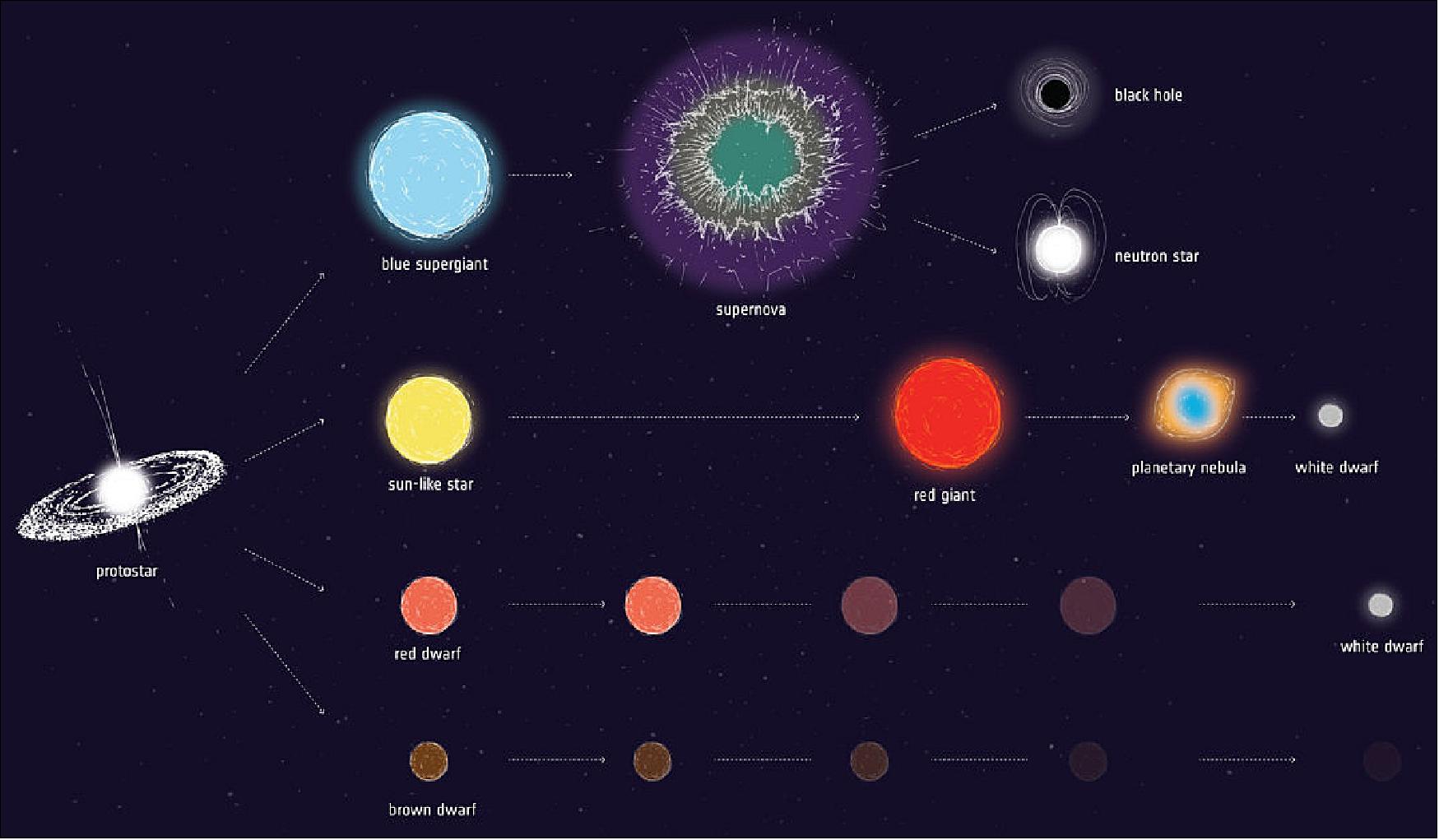
Legend to Figure 25: Some proto-stars, brown dwarfs, never actually get hot enough to ignite into fully-fledged stars, and simply cool off and fade away. Red dwarfs, the most common type of star, keep burning until they have transformed all their hydrogen into helium, turning into a white dwarf. Sun-like stars swell into red giants before puffing away their outer shells into colorful nebula while their cores collapse into a white dwarf. The most massive stars collapse abruptly once they have burned through their fuel, triggering a supernova explosion or gamma-ray burst, and leaving behind a neutron star or black hole.
• December 7, 2017: ESA's SPC (Science Program Committee) has approved indicative extensions, up to 2019-2020, for the operation of eight scientific missions. 20)
- During its meeting at ESA Headquarters in Paris, on 21-22 November, the SPC approved indicative extensions for the continued operation of five ESA-led missions: Gaia, INTEGRAL, Mars Express, SOHO, and XMM-Newton. This followed a comprehensive review of the current operational status and outlook of the missions and their expected scientific returns during the extension period. The decision will be subject to confirmation towards the end of 2018.
- The lifetime of Gaia, ESA's billion star surveyor, was extended by eighteen months, from 25 July 2019 to 31 December 2020. This is the first time that Gaia, which was launched in 2013 and originally funded for a five-year mission, has been subject to the extension process. — Mars Express, SOHO, and XMM-Newton each received extensions of two years, so their operations will continue at least until the end of 2020.
- The SPC extended the operations of the high-energy observatory INTEGRAL by one year, until 31 December 2019. A proposal to extend INTEGRAL until the end of 2020, as well as a proposal concerning a two-year extension of the magnetospheric plasma mission, Cluster, will be presented to the next meeting of the SPC in February 2018.
- The go-ahead was also given to continue ESA's contributions to the operations of three international collaborative missions: the HST (Hubble Space Telescope), and IRIS (Interface Region Imaging Spectrograph), which are both led by NASA, as well as the Japanese-led mission Hinode.
- Every two years, all missions whose approved operations end within the following four years are subject to review by the advisory structure of the Science Directorate. Extensions are granted to missions that satisfy the established criteria for operational status and science return, subject to the level of financial resources available in the science program. These extensions are valid for the following four years, subject to a mid-term review and confirmation after two years. Extensions for operations in the period 2017-2018 were approved by the SPC in November 2016, but the indicative extension, for 2019-2020, had been deferred until the November 2017 meeting to allow the SPC to evaluate the outcome of the ESA Ministerial Council meeting in December 2016.
• October 17, 2017: Fifteen years ago, on 17 October 2002 at 6:41 GMT, the European Space Agency's INTEGRAL observatory was launched. 21)
- From rare breeds of high-energy stars to the feeding habits of monster black holes and the annihilation of antimatter, the mission has been uncovering the secrets of the most energetic phenomena in the Universe. And since it is never too late to try something new, in recent times INTEGRAL has begun to play a crucial role in new fields of astrophysics, like follow-up of high-energy neutrinos, or especially exciting: the study of gravitational wave sources.

• October 16, 2017: INTEGRAL played a crucial role in discovering the flash of gamma rays linked to the gravitational waves released by the collision of two neutron stars. On 17 August, INTEGRAL, as well as NASA's Fermi satellite recorded a short Gamma-Ray Burst. Such bursts are not uncommon, but this one was preceded a few seconds earlier by a gravitational wave signal! 23)
- One of the two detectors of the LIGO (Laser Interferometer Gravitational-wave Observatory) experiment, in the USA, recorded the passage of gravitational waves – fluctuations in the fabric of spacetime caused by powerful cosmic events.
- "This is a ground-breaking discovery, revealing for the first time gravitational waves and highly energetic light released by the same cosmic source," says Erik Kuulkers, INTEGRAL Project Scientist at ESA.
- Before this finding, gravitational waves had been confirmed on four occasions: in all cases, they were traced back to pairs of merging black holes as they spiralled towards each other. — The two LIGO detectors had seen the first in September 2015, followed by two more in late 2015 and early 2017.
- Recently, on 14 August, the fourth observation of gravitational waves also involved Europe's Virgo instrument in Italy.
- Gravitational waves are the only 'messenger' expected when black holes collide. Following these four measurements, scientists across the world began searching with ground and space telescopes for possible luminous bursts linked to the gravitational waves.
- "We had contributed to these earlier searches with INTEGRAL, looking for gamma- or X-ray emission and finding none, as expected from the vast majority of theories," says Volodymyr Savchenko from the INTEGRAL Science Data Center in Geneva, Switzerland. - This time, however, the story took a different turn.
- Other cosmic clashes are suspected to release not only gravitational waves but also light across the electromagnetic spectrum. This can happen, for example, when the collision involves one or more neutron stars – like black holes, they are compact remnants of what were once massive stars.
- Merging neutron stars have also been thought to be the long-sought sources of short gamma-ray bursts, though no observational proof had yet been found.

- "We realized that we were witnessing something historic when we saw the notification of Fermi's and LIGO's detections appear on our internal network almost at the same time, and soon after we saw the confirmation in the data from INTEGRAL's SPI instrument, too," says Carlo Ferrigno, from the ISDC (INTEGRAL Science Data Center). - "Nothing like this had happened before: it was clearly the signature of a neutron star merger," adds Volodymyr.
- Ordinarily, an alert from only one of the three gravitational-wave detectors would not awaken curiosity so suddenly, but the coincidence with the gamma-ray blast detected from space prompted the LIGO/Virgo scientists to look again.
- It later appeared that both LIGO detectors had recorded the gravitational waves. Owing to its lower sensitivity and different orientation, Virgo produced a smaller response, but combining all three sets of measurements was crucial to locating the source.

- The data pointed to a 28 square degree patch in the sky, equivalent to a square spanning roughly 10 times the diameter of the full Moon on each side. The gravitational wave signal indicated that the source lies only about 130 million light-years away.
- Without further delay, a large number of ground and space telescopes turned to this portion of the sky.
- About half a day after the detections, scientists at various optical observatories, including the European Southern Observatory's telescopes in Chile, spotted something new near the core of galaxy NGC 4993. Sitting at just the distance indicated by LIGO/Virgo, it was just what you would expect to see in visible light as neutron stars merged.
- After the initial detection of the blast, INTEGRAL observed it for five and a half days. No further gamma rays were detected, an important fact in understanding how the neutron stars merged.
- The extensive follow-up campaign revealed signals across the spectrum, first in the ultraviolet, visible and infrared bands, then in X-rays and, eventually, radio wavelengths.
- "What we are witnessing is clearly a kilonova: the neutron-rich material released in the merger is impacting its surroundings, forging a wealth of heavy elements in the process," explains Carlo. - "This amazing discovery was made possible by a terrific collaboration of thousands of people working in different observatories and experiments worldwide," says Erik.
- "We are thrilled that INTEGRAL could provide a crucial contribution to confirming the nature of such a rare phenomenon that scientists have been seeking for decades."
- With high sensitivity to gamma rays and almost full-sky coverage for brief events, INTEGRAL is amongst the best astronomical facilities for keeping an eye on gamma-ray bursts.
- When the LIGO/Virgo sensors start their observations again, with improved sensitivity, in late 2018, it is crucial that as many gamma-ray satellites as possible are active to check on the gravitational wave detections.
• November 22, 2016: ESA's SPC (Science Program Committee) has today confirmed two-year mission extensions for nine scientific missions in which the Agency is participating. This secures their operations until the end of 2018. 24)
- After a comprehensive review of their current operational status and the likely scientific return from each mission, the SPC decided to extend the operation of six ESA-led missions (Cluster, INTEGRAL, Mars Express, PROBA-2, SOHO and XMM-Newton) from 1 January 2017 to 31 December 2018.
- The go-ahead was also given to continue ESA's contributions to the operations of three international collaborative missions: the Hubble Space Telescope and the Interface Region Imaging Spectrograph (IRIS), which are both led by NASA, as well as ASTRO-H/Hinode, which is a Japanese-led mission.
- Every two years, all missions whose approved operations end within the following four years are subject to review by the advisory structure of the Science Directorate. Extensions are granted to missions that satisfy the established criteria for operational status and science return, subject to the level of financial resources available in the science program. These extensions are valid for the following four years, subject to a mid-term review and confirmation after two years.
- For the current cycle, the committee deferred any decision for the period 2019-2020 until after the meeting of the ESA Council at Ministerial Level, which is being held in Lucerne, Switzerland, 1–2 December. Among many decisions to be taken, the ESA Council will decide the longer-term budget of the science program.
• March 30, 2016: Following the discovery of gravitational waves from the merging of two black holes, ESA's INTEGRAL satellite has revealed no simultaneous gamma rays, just as models predict. - On 14 September 2015, the terrestrial LIGO (Laser Interferometer Gravitational-wave Observatory) detected gravitational waves – fluctuations in the fabric of spacetime – produced by a pair of black holes as they spiralled towards each other before merging. The signal lasted less than half a second. The discovery was the first direct observation of gravitational waves, predicted by Albert Einstein a century ago. 25)
- Two days after the detection, the LIGO team alerted a number of ground- and space-based astronomical facilities to look for a possible counterpart to the source of gravitational waves. The nature of the source was unclear at the time, and it was hoped that follow-up observations across the electromagnetic spectrum might provide valuable information about the culprit.
- Gravitational waves are released when massive bodies are accelerated, and strong emission should occur when dense stellar remnants such as neutron stars or black holes spiral towards each other before coalescing.
- Models predict that the merging of two stellar-mass black holes would not produce light at any wavelength, but if one or two neutron stars were involved in the process, then a characteristic signature should be observable across the electromagnetic spectrum.
- Another possible source of gravitational waves would be an asymmetric supernova explosion, also known to emit light over a range of wavelengths.
- It was not possible to pinpoint the LIGO source – its position could only be narrowed down to a very long strip across the sky.
- Observatories searched their archives in case data had been serendipitously collected anywhere along this strip around the time of the gravitational wave detection. They were also asked to point their telescopes to the same region in search for any possible 'afterglow' emission.
- INTEGRAL is sensitive to transient sources of high-energy emission over the whole sky, and thus a team of scientists searched through its data, seeking signs of a sudden burst of hard X-rays or gamma rays that might have been recorded at the same time as the gravitational waves were detected.
- "We searched through all the available INTEGRAL data, but did not find any indication of high-energy emission associated with the LIGO detection," says Volodymyr Savchenko of the François Arago Centre in Paris, France. Volodymyr is the lead author of a paper reporting the results, published today in Astrophysical Journal Letters. 26)
- The team analyzed data from the Anti-Coincidence Shield on INTEGRAL's SPI instrument. The shield helps to screen out radiation and particles coming from directions other than that where the instrument is pointing, as well as to detect transient high-energy sources across the whole sky.
- The team also looked at data from INTEGRAL's IBIS instrument, although at the time it was not pointing at the strip where the source of gravitational waves was thought to be located.
- "The source detected by LIGO released a huge amount of energy in gravitational waves, and the limits set by the INTEGRAL data on a possible simultaneous emission of gamma rays are one million times lower than that," says co-author Carlo Ferrigno from the INTEGRAL Science Data Center at the University of Geneva, Switzerland.
- Subsequent analysis of the LIGO data has shown that the gravitational waves were produced by a pair of coalescing black holes, each with a mass roughly 30 times that of our Sun, located about 1.3 billion light years away. Scientists do not expect to see any significant emission of light at any wavelength from such events, and thus INTEGRAL's null detection is consistent with this scenario.
- Similarly, nothing was seen by the great majority of the other astronomical facilities making observations from radio and infrared to optical and X-ray wavelengths.
- The only exception was the Gamma-Ray Burst Monitor on NASA's Fermi Gamma-Ray Space Telescope, which observed what appears to be a sudden burst of gamma rays about 0.4 seconds after the gravitational waves were detected. The burst lasted about one second and came from a region of the sky that overlaps with the strip identified by LIGO.
- This detection sparked a bounty of theoretical investigations, proposing possible scenarios in which two merging black holes of stellar mass could indeed have released gamma rays along with the gravitational waves.
- However, if this gamma-ray flare had had a cosmic origin, either linked to the LIGO gravitational wave source or to any other astrophysical phenomenon in the Universe, it should have been detected by INTEGRAL as well. The absence of any such detection by both instruments on INTEGRAL suggests that the measurement from Fermi could be unrelated to the gravitational wave detection.
- "This result highlights the importance of synergies between scientists and observing facilities worldwide in the quest for as many cosmic messengers as possible, from the recently-detected gravitational waves to particles and light across the spectrum," says Erik Kuulkers, INTEGRAL Project Scientist at ESA.
- This will become even more important when it becomes possible to observe gravitational waves from space. This has been identified as the goal for the L3 mission in ESA's Cosmic Vision program, and the technology for building it is currently being tested in space by ESA's LISA Pathfinder mission.
- Such an observatory will be capable of detecting gravitational waves from the merging of supermassive black holes in the centers of galaxies for months prior to the final coalescence, making it possible to locate the source much more accurately and thus provide astronomical observatories with a place and a time to look out for associated electromagnetic emission.
- "We are looking forward to further collaborations and discoveries in the newly-inaugurated era of gravitational astronomy," concludes Erik.
• January 16, 2016: Normally busy with observing high-energy black holes, supernovas and neutron stars, ESA's INTEGRAL space observatory recently had the chance to look back at our own planet's aurora. 27)
- Auroras are well known as the beautiful light shows at polar latitudes as the solar wind interacts with Earth's magnetic field.
- As energetic particles from the Sun are drawn along Earth's magnetic field, they collide with different molecules and atoms in the atmosphere to create dynamic, colorful light shows in the sky, typically in green and red.
- But what may be less well known is that auroras also emit X-rays, generated as the incoming particles decelerate.
- INTEGRAL detected high-energy auroral X-rays on 10 November 2015 as it turned to Earth – although it was looking for something else at the time. - Its task was to measure the diffuse cosmic X-ray background that arises naturally from supermassive black holes that are gobbling up material at the centers of some galaxies.
- To achieve this, INTEGRAL records the X-ray brightness with and without the Earth in the way, blocking the background. These types of measurements help astronomers estimate how many distant supermassive black holes there are in the Universe.
- Unfortunately, on this occasion, the X-rays from Earth's aurora drowned out the cosmic background – but the observations were not a waste.
- They also help us to understand the distribution of electrons raining into Earth's upper atmosphere, and they reveal interactions between the solar wind and Earth's protective magnetic bubble, or magnetosphere.
- "Auroras are transient, and cannot be predicted on the timeframe that satellite observations are planned, so it was certainly an unexpected observation," comments Erik Kuulkers, INTEGRAL Project Scientist. "It's also quite unusual for us to point the spacecraft at Earth: it requires innovative planning by the operations teams to coordinate such a dedicated set of maneuvers to ensure it can operate safely with Earth inside the instruments' field of view and then return to its standard observing program.
- "Although the original background X-ray measurements didn't go quite to plan this time, it was exciting to capture such intense auroral activity by chance."
![Figure 29: INTEGRAL's X-ray view of Earth's aurora [image credit: ESA/INTEGRAL/ E. Churazov (IKI/MPA)/ M. Türler (ISDC/University of Geneva)]](https://eoportal.org/ftp/satellite-missions/i/INTEGRAL_20102021/INTEGRAL_X-ray_view_of_Earth_aurora.gif)
• July 6, 2015: The INTEGRAL, Fermi and Swift space observatories have used the magnifying power of a cosmic lens to explore the inner regions of a supermassive black hole. 28)
- Gamma rays are highly energetic radiation emitted by some of the most extreme objects in our Universe. Jets of gamma rays moving at close to the speed of light stream from the areas around black holes, for example. These jets are thought to be emitted by superheated material spinning wildly as it is devoured by the hungry black hole.
- A team of astronomers used the magnifying effect of the stars located in a spiral galaxy to 'zoom in' to another galaxy, known as PKS 1830-211, that lies along the same line of sight from Earth but is much farther away. Thanks to this unusual set-up, they could pick out very small structures in the distant galaxy, corresponding to the vicinity of the supermassive black hole. The black hole is devouring material from its surroundings while firing powerful jets of particles that emit light up to the high energies of gamma rays. Observing these jets with ESA's INTEGRAL and NASA's Fermi and Swift satellites, the astronomers could measure the size of the region around the black hole where they originate. 29) 30)
- Our telescopes will never be powerful enough to reveal these inner regions, but the intervening gravitational lens made the measurement possible. This is the first time that gravitational microlensing has been used with gamma rays to dissect the high-energy processes taking place around a supermassive black hole.
- Observing the gamma-ray source with ESA's INTEGRAL and NASA's Fermi and Swift allowed the astronomers to build up a more complete picture of the radiation streaming out.
- The more energetic gamma rays, detected by Fermi, are seen to be coming from the tiny base of the jet – the 'ant on the Moon'-size region – while the lower energy gamma rays, detected by INTEGRAL, were emitted from a much larger surrounding region.
- The team also studied X-rays using INTEGRAL and Swift. They found these X-rays to be emanating from a region stretching around the hole some 400 billion km or more.
- "This black hole is one of the most powerful known objects of its kind. Fully characterizing its emission will hopefully give us real insight into how these jets form," says Erik Kuulkers, ESA's INTEGRAL project scientist.
- "Fortunately, the black hole lies in the field of space located towards the center of our Galaxy, so INTEGRAL sees it often. "These observations provide unique information about the high-energy processes taking place around supermassive black holes, by allowing us to 'look inside' tiny structures lying very far away from us."
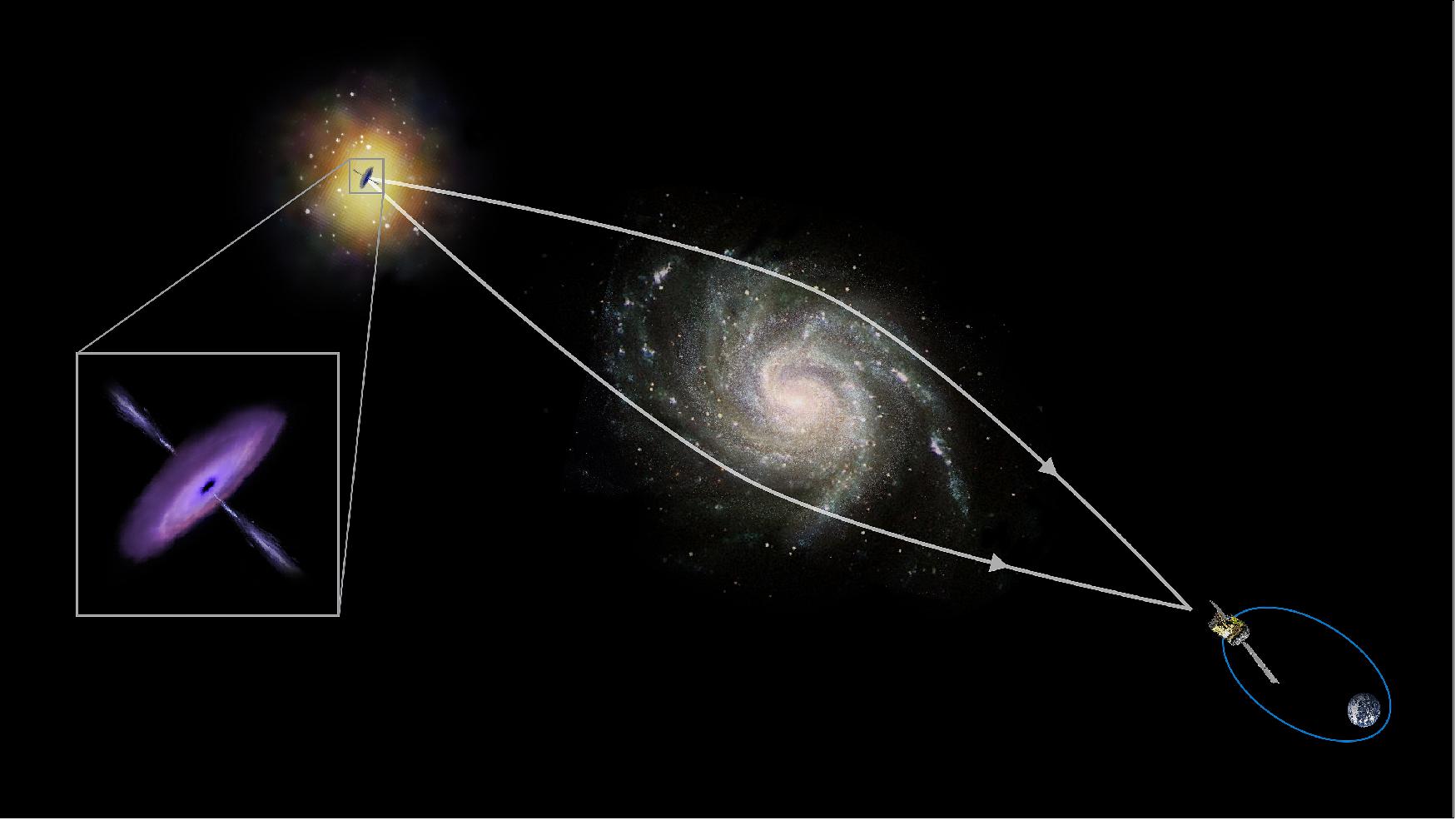
• January 23, 2015: Since 2002, ESA's INTEGRAL spacecraft has been observing some of the most violent events in the Universe, including gamma-ray bursts and black holes. While it still has years of life ahead, its fuel will certainly run out one day. 31)
- INTEGRAL, one of ESA's longest-serving and most successful space observatories, has begun a series of four thruster burns carefully designed to balance its scientific life with a safe reentry in 2029.
- That seems far off, but detailed planning and teamwork now will ensure that the satellite's eventual entry into the atmosphere will meet the Agency's guidelines for minimizing space debris.
- Making these disposal maneuvers so early will also minimize the fuel usage, allowing ESA to exploit the valuable satellite's lifetime to the fullest.
- This is the first time that a spacecraft's orbit is being adjusted, after 12 years in space, to achieve a safe reentry 15 years in the future, while maximizing valuable science return for the subsequent seven to eight years.
- "Our four burns will use about half of the estimated 96 kg of fuel available," says Richard Southworth, spacecraft operations manager at ESOC in Darmstadt, Germany. "This will influence how INTEGRAL's orbit evolves, so that even after we run out of propellant we will still have a safe reentry in February 2029 as a result of natural orbit decay. "No further maneuvers are required between now and then and INTEGRAL can continue to operate."
- Debris mitigation: The latest ESA debris guidelines require that a satellite must be disposed of in such a way that it poses no risk to other satellites in protected orbital regions for more than 25 years.
- "At first glance, it looked like the goals of space debris mitigation and maximizing science were incompatible, considering the limited amount of fuel available," explained Claudia Dietze and Gerald Ziegler, flight dynamics specialists working on INTEGRAL at ESOC. "However, after detailed analysis, a sequence was developed that meets both goals. Moreover, additional considerations of attitude constraints and ground station coverage had to be taken into account, making it a highly interesting and challenging undertaking."
- With the burns complete, INTEGRAL will continue scientific observations until its fuel runs out in the early 2020s.
- With the burns complete, INTEGRAL will continue scientific observations until its fuel runs out in the early 2020s. "However, we are also looking into ways to reduce routine fuel usage by applying techniques developed for other missions, such as our sister satellite, XMM-Newton," says Richard Southworth.
• November 24, 2014: During a meeting on 19 & 20 November 2014, the SPC (Science Program Committee) approved the confirmation of science operations until 31 December 2016, as well the indicative extension of science operations for INTEGRAL until 31 December 2018, subject to a mid-term review in 2016. The aim is to reduce the allocated resources for 2017/2018 by approximately 10% as compared to 2016. 32)
- After a comprehensive review by the Science Program’s advisory structure of the current operational status and likely scientific return of each mission in the future, the SPC agreed to continue funding for six ESA-led missions (Cluster, INTEGRAL, Mars Express, PROBA-2, SOHO and XMM-Newton) for the period 1 January 2015 – 31 December 2016.
• November 19, 2013: Astronomers looking at the radioactive afterglow of supernovae with ESA's INTEGRAL mission have revealed that the remains of stellar explosions move through the Milky Way much faster, on average, than stars and most of the Galaxy's gas. This stellar debris is most likely ejected by winds and supernova explosions in large groups of massive stars located primarily on the leading edges of the Galaxy's spiral arms. 33)
- While the night sky delivers a peaceful and almost immutable cosmic view, the picture belies a Universe alive with ceaseless motion from the smallest to the largest scales. All structures in the Milky Way, both the stars and the diffuse interstellar medium, swirl around the center of the Galaxy at velocities as high as hundreds of km/s, taking about one hundred million years to complete a revolution.
- By studying how these objects move, astronomers can figure out the structure of the Milky Way at large and, in particular, of the spiral arms – a prominent characteristic of our Galaxy. These investigations are key in the challenge of understanding the history of the Milky Way's evolution.
- Using data from ESA's INTEGRAL mission, a team of astronomers has mapped out galactic motions, exploiting a new tracer that follows stellar debris both through space and time. With this new method, they revealed that the remains of stellar explosions move, on average, much faster than stars and most of the gas in the Milky Way.
- "The stellar winds blown by a massive star, and the supernova explosions at the end of its life, are powerful agents. They release large amounts of matter and energy into interstellar space, and we managed to trace some of this matter during its very long journey," explains Karsten Kretschmer from the Laboratoire APC in Paris, France. Kretschmer is the lead author of the paper reporting on the new results, published in Astronomy & Astrophysics. 34)
- The astronomers traced the path of the supernova debris by tracking its velocity relative to us through the Galaxy. They sought the light emitted at a specific gamma-ray wavelength by the radioactive decay of aluminum-26 (26Al), an isotope produced in the supernova explosions. Matter ejected by a supernova is richer in heavy elements than the raw material from which the parent star formed, because many new atomic nuclei are created in the star's interior as well as during the explosion.
- Part of the ejected material is in the form of nuclei of radioactive isotopes, and the majority of them decay over short timescales – ranging between a few days and several years. But not 26Al. With a half-life of about 700,000 years, 26Al nuclei can travel very long distances before they decay. When they do so, astronomers can exploit the gamma rays emitted during the decay to trace the long-term reach of stellar explosions.
- "Looking at the radioactive afterglow of supernovae about a million years after the explosions, we followed how their debris has spread across the Galaxy. This is not possible with observations at other wavelengths, which only show the remnants of more recent supernovae," adds Kretschmer.
- Kretschmer and his collaborators used the SPI (SPectrometer on INTEGRAL) instrument to search for the emission from the radioactive decay of 26Al. With these data, they could map the distribution and velocity of this isotope across the Milky Way.
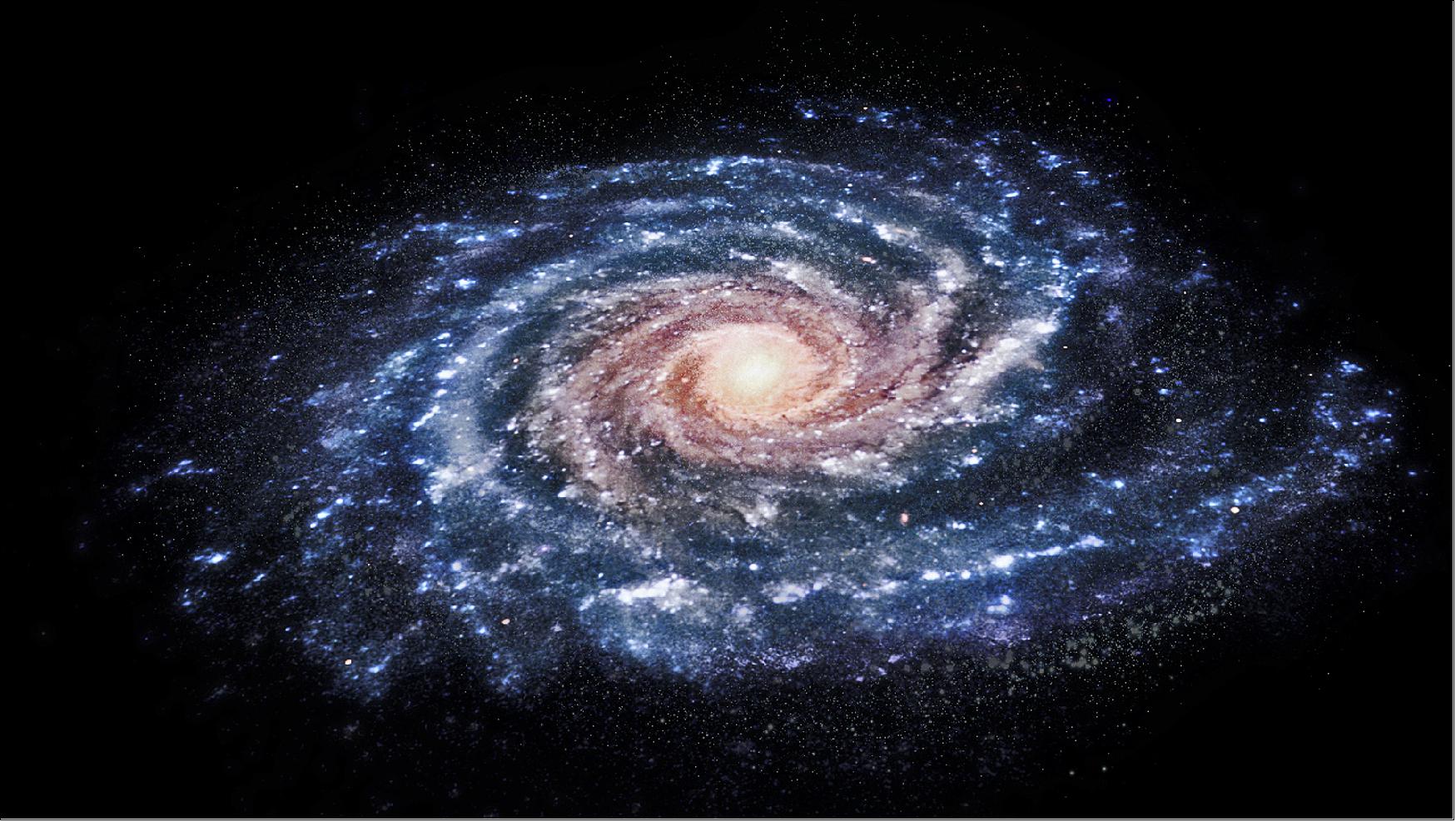
• October 17, 2012: ESA's INTEGRAL mission is celebrating the tenth anniversary of its launch, which took place on 17 October 2002. Over the past decade, the mission has observed the entire sky at hard X-ray and soft gamma-ray energies with unprecedented sensitivity and resolution, shedding new light on several classes of astronomical sources, galactic and extragalactic alike. Highlights of the mission so far have included the study of the emission from electron-positron annihilation across the sky, the discovery of two previously unknown classes of X-ray binaries, the characterization of the cosmic X-ray background and the first detection of polarization in gamma-ray sources. 35)
- During its monitoring of the sky, INTEGRAL has focussed on the center and the bulge of our Galaxy. There, the vast majority of high-energy sources correspond to the final products of stellar evolution: either neutron stars or black holes in X-ray binaries, or pulsars - highly magnetized, spinning neutron stars. In particular, the extensive data collected with INTEGRAL have revealed two new classes of high-mass X-ray binaries (HMXB), binary systems where the companion star providing matter to the accreting compact remnant is a bright and massive star (either an O or B star, a Be star or a blue supergiant).
- A baffling type of HMXB discovered with INTEGRAL are the so-called SFXTs (Supergiant Fast X-ray Transients). These sources were first noticed because of their occasional flares in X-rays: this transient activity, which lasts only a few hours, enhances the brightness of these otherwise very faint sources dramatically. Over the years, INTEGRAL has discovered about 25 SFXTs.
- "The discovery of short-lived phenomena such as SFXTs was possible thanks to the high sensitivity of INTEGRAL and to its long monitoring campaigns of the Galactic center," explains Winkler. "The origin of the outbursts in SFXTs is still debated, but is possibly linked to the accretion process that powers these X-ray binaries, where the compact remnant is fed by a clumpy stellar wind. Normally, the accretion proceeds at very slow rates and the source is relatively faint; the flares correspond to the compact remnant suddenly engulfing a denser patch of the stellar wind," he adds.
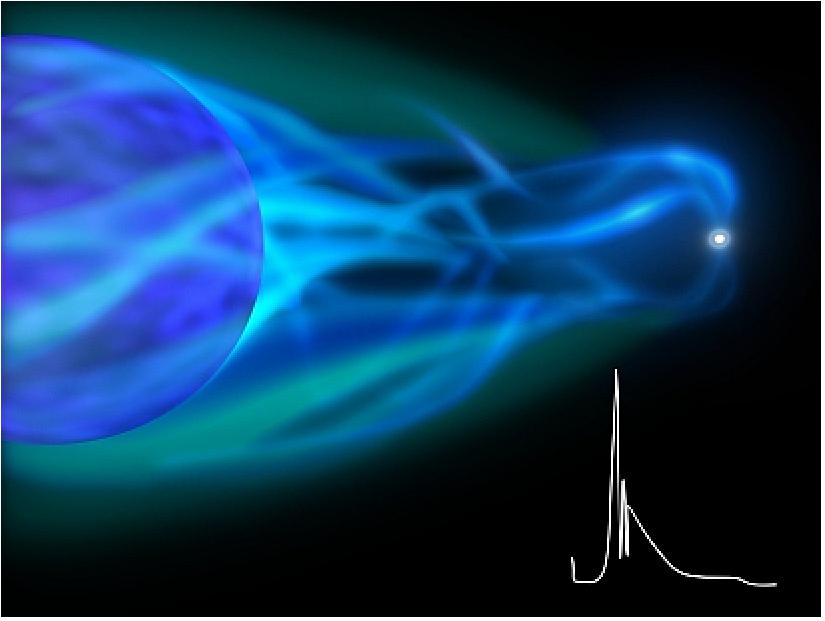
- Over 250 of the extragalactic point sources detected with INTEGRAL have been identified as AGN (Active Galactic Nuclei). These are galaxies hosting a central, supermassive black hole that is actively accreting matter; the accretion process causes AGN to radiate profusely across the electromagnetic spectrum. The hard X-ray energy band is particularly important for the study of AGN since the emission at these energies is dominated by non-thermal emission mechanisms. An example is the Compton scattering of lower-energy, soft X-ray photons, which are released by the accretion disc that feeds the supermassive black hole and later bounce off electrons in the surrounding plasma, gaining energy in the process. Emission from AGN in the soft gamma-ray band is also crucial to study the powerful jets of relativistic particles that stem from the vicinity of the supermassive black hole.

Legend to Figure 33: Most of the sources shown in the image belong to our Galaxy, the Milky Way, and are concentrated along the Galactic Plane and Bulge. These objects mainly correspond to the late stages of stellar evolution and are characterized by strong emission in the high-energy end of the electromagnetic spectrum, at X- and gamma-rays.
The majority of sources depicted in the image are X-ray binaries: binary systems containing a compact stellar remnant (a black hole or a neutron star) that exerts an intense gravitational pull on its companion star and thus accretes material from it. Other types of galactic sources shown are rotating neutron stars, also known as pulsars, and supernova remnants.
• October 25, 2011: Today during the perigee crossing from revolution 1102 to 1103 at a height of only 2,756.4 km, INTEGRAL has reached the lowest point in its orbit since the passage from revolution 3 to 4 on 25 October 2002. The INTEGRAL orbit is strongly evolving, from a perigee height of ~9,500 km in the early mission to more than 13,000 km in 2005/2006 followed by a decrease to the current value. In the coming years the orbit will again circularize somewhat, reaching a perigee height of close to 10,000 km in late 2015. 38)
- The increased particle radiation as INTEGRAL is passing through the proton belts is noted in accelerated degradation of the solar arrays. Still, the power margin is very good and appears sufficient to comfortably operate the satellite without additional power constraints until the end of the current mission extension. No significant effects of the increased radiation on the instruments have been observed.
- The image of Figure 34 visualizes the shape of three selected INTEGRAL revolutions for the early mission, peak perigee height and the perigee minimum. Note that the elliptical shapes seem elongated also due to projection effects as the plane of the orbit has rotated over the years.
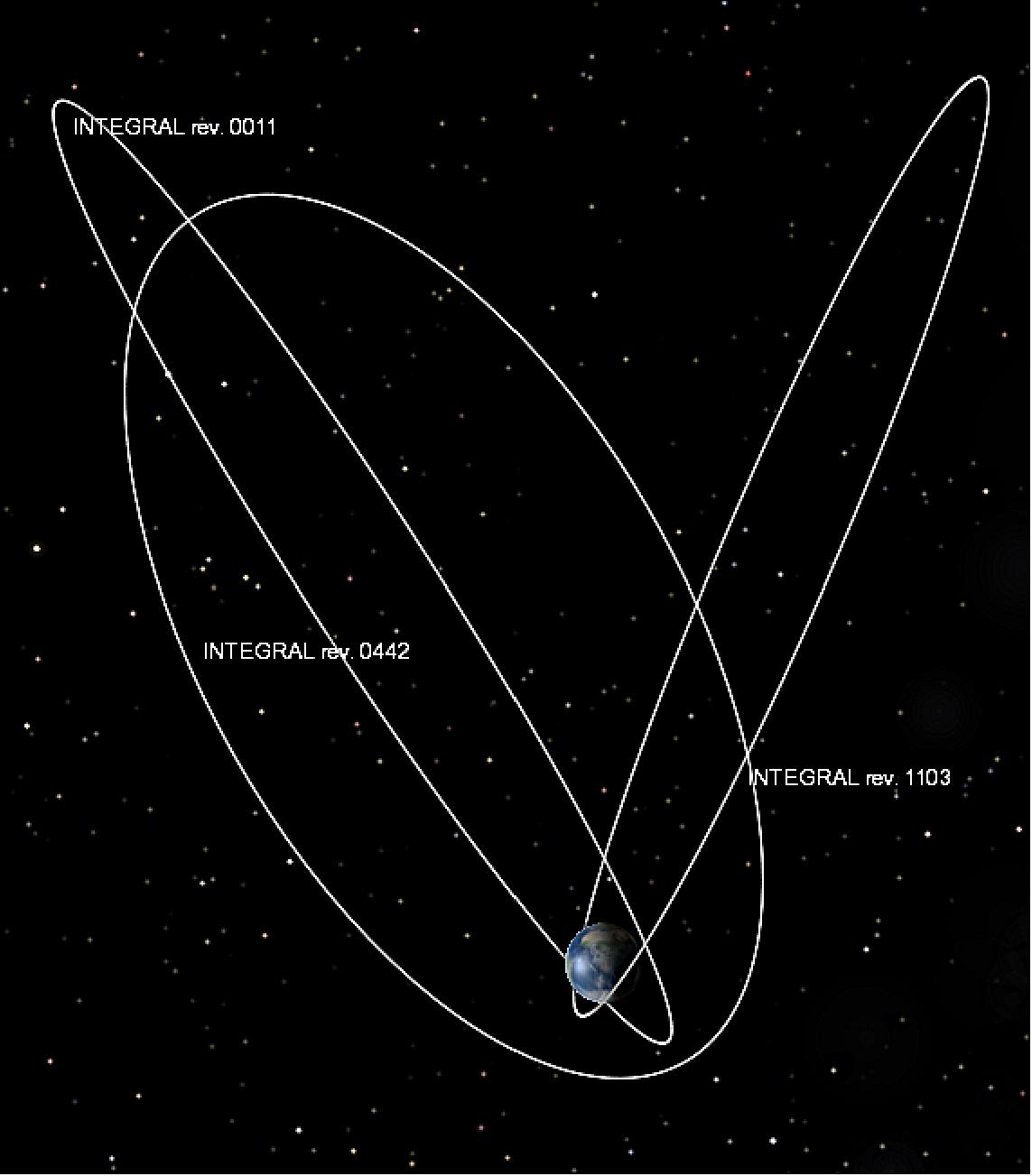
• August 5, 2011: A solar flare (class M9.3) on 04 August 2011 with associated bright coronal mass ejection has led to IBIS, JEM-X and OMC being in safe mode for the second time this year after a similar event in June. High background radiation levels due to the solar flare are persisting at the moment. Nominal operations will be resumed once the particle background level has subsided again. 39)

• January 27, 2009: The quick turn-around time of the INTEGRAL operation teams has enabled rare high-energy observations of a magnetar. The observations, which were performed as a Target of Opportunity, followed indications late last week that this magnetar, the Anomalous X-ray Pulsar, 1E 1547.0-5408, had entered outburst mode. 40)
- The 1E1547.0-5408 is one of only 9 confirmed AXPs (Anomalous X-ray Pulsars) - isolated, young neutron stars with unusually strong magnetic fields (1014G -1015G). Together with Soft Gamma Repeaters they make up a class of celestial object known as magnetars.
- The 1E 1547.0-5408 was first detected by the Einstein X-ray observatory. Subsequent observations by a series of X-ray observatories (ASCA, Chandra, XMM-Newton and Swift) have shown it to display the typical characteristics of an AXP. It has exhibited a small number of outbursts over the past few years but at weaker levels than those observed in the past few days.
- Magnetar active state triggers alerts on several satellites, including INTEGRAL: The first sign that this magnetar had entered a new active burst state came early on Thursday 22 January, when the Swift Burst Alert Telescope (GCN 8833) and the Fermi Gamma-Ray Burst Monitor (GCN 8835) recorded a number of hard X-ray triggers which were identified as originating from the direction of 1E 1547.0-5408.
- Volker Beckmann and the team at the ISDC (INTEGRAL Science Data Center), monitoring the real-time data from the almost omnidirectional SPI ACS (Anti-Coincidence System), which operates as a burst trigger on INTEGRAL, also noticed a significant increase in triggers: almost 200 on 22 January compared to a typical rate of a few per day. The bursts were among the brightest ever recorded by the ACS in the 6 years since INTEGRAL was launched and varied in length from 50 ms to 8 seconds. The ACS has a lower energy threshold of 50-150 keV (depending on the individual detector) and an upper threshold of about 100 MeV. Although the ACS cannot localize the position of a burst source, the temporal coincidence of some of the bursts with those identified by Swift and Fermi confirmed the source of the burst emission to be 1E 1547.0-5408 (GCN 8837).

- Exceptional activity results in public Target of Opportunity: Recognizing that this was a rare opportunity to observe close to, and possibly during, an outburst state, Beckmann and other scientists submitted ToO (Target of Opportunity) requests for immediate observations of this object to the INTEGRAL Science Operations Team. These were received on 22 and 23 January. After careful consideration the ToO was granted by the INTEGRAL Project Scientist, Christoph Winkler, and a 100,000 second observation planned and executed. This ToO began at 15:30:59 on 24 January and continued until the end of the visibility window at 22:14:36 on 25 January.
- Given the interest expressed by the scientific community in these observations the Project Scientist declared the ToO to be public and all scientific data recorded during this ToO has now been made publicly available from the INTEGRAL Science Data Center at Geneva.
- Early results: magnetar still active, spectrum measured. A preliminary examination of the data indicates that the magnetar was still in an active phase during the ToO and that it was detected by all X-ray instruments on-board the satellite. Apart from bursts, which occurred during the observation and were again seen by several satellites, it was also possible to determine the X-ray spectrum of this AXP. The spectrum extends up to energies of at least 150 keV and has the signature of processes usually associated with emission of a jet or other non-thermal processes, rather than showing a "hot spot" on the neutron star’s surface (ATEL 1908).
- A simultaneous observation of lower energy X-rays by the Swift satellite indicates that the X-ray emission is travelling towards us through dusty regions of our Galaxy causing ring-like halos in the X-ray images (GCN 8848). This allows scientists now not only to study the neutron star itself, but also the interstellar medium of the Milky Way.
• November 14, 2008: X-ray and gamma-ray data from ESA’s XMM-Newton and INTEGRAL orbiting observatories has been used to test, for the first time, the physical processes that make magnetars, an atypical class of neutron stars, shine in X-rays. 41) 42)
- Neutron stars are remnants of massive stars (10-50 times as massive as our Sun) that have collapsed on to themselves under their own mass. Made almost entirely of neutrons (subatomic particles with no electric charge), these stellar corpses concentrate more than the mass of our Sun within a sphere about 20 km in diameter.
- They are so compact that a teaspoon of neutron star stuff would weigh about one hundred million tons. Two other physical properties characterize a neutron star: their fast rotation and strong magnetic field.
- Magnetars form a class of neutron stars with ultra-strong magnetic fields. With magnetic fields a thousand times stronger than that of ordinary neutron stars, they are the strongest known magnets in the cosmos.
- In comparison, one would need 10 million million commonly-used hand magnets to generate a comparable magnetic field (most media used for data storage, for example, would be erased instantly if exposed to a magnetic field a mere million million times weaker).
- So far, about 15 magnetars have been found. Five of them are known as SGRs (Soft Gamma Repeaters), because they sporadically release large, short bursts (lasting about 0.1 s) of low energy (soft) gamma rays and hard X-rays. The rest, about 10, are associated with AXPs (Anomalous X-ray Pulsars). Although SGRs and AXPs were first thought to be different objects, we now know that they share many properties and that their activity is sustained by their strong magnetic fields.
- Magnetars are different from ‘ordinary’ neutron stars because their internal magnetic field is thought to be strong enough to twist the stellar crust. Like in a circuit fed by a gigantic battery, this twist produces currents in the form of electron clouds which flow around the star. These currents interact with the radiation coming from the stellar surface, producing the X-rays.
- Until now, scientists could not test their predictions, because it is not possible to produce such ultra-strong magnetic fields in laboratories on Earth.
- To understand this phenomenon, a team led by Nanda Rea from the University of Amsterdam used XMM-Newton and INTEGRAL data to search for these dense electron clouds around all known magnetars, for the first time.
- Rea’s team found evidence that large electron currents do actually exist, and were able to measure the electron density which is a thousand times stronger than in a ‘normal’ pulsar. They have also measured the typical velocity at which the electron currents flow. With it, scientists have now established a link between an observed phenomenon and an actual physical process, an important clue in the puzzle of understanding these celestial objects. 43)
- The team is now working hard to develop and test more detailed models on the same line, to fully understand the behavior of matter under the influence of such strong magnetic fields.
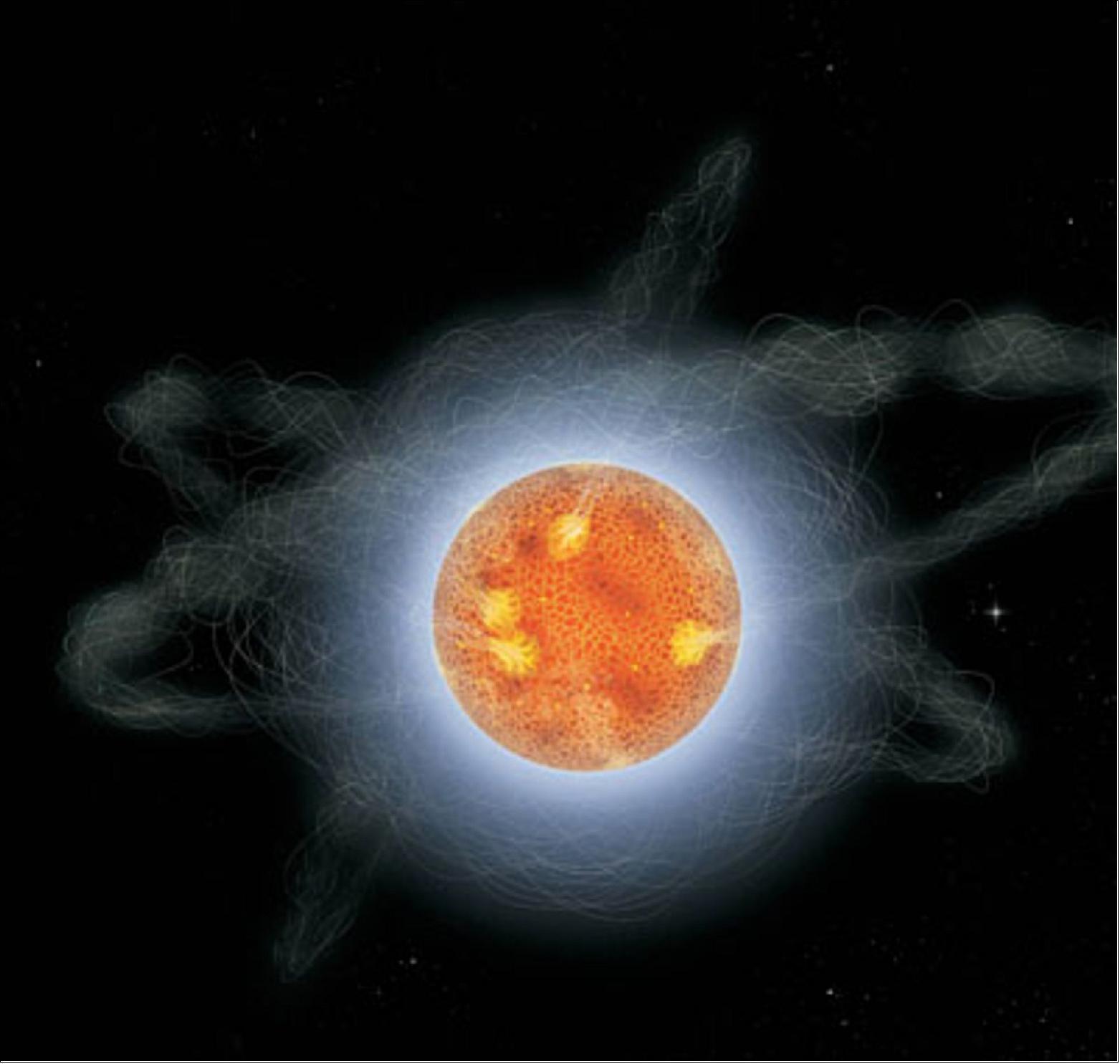
• August 29, 2008: Thanks to data from ESA’s INTEGRAL gamma-ray observatory, scientists have been able to locate where particles in the vicinity of the rotating neutron-star in the Crab Nebula are accelerated to immense energies. The discovery put in place another piece of the puzzle in understanding how neutron stars work. 44)
- Rotating neutron-stars, or 'pulsars', are known to accelerate particles to enormous energies, typically one hundred times more than the most powerful accelerators on Earth, but scientists are still uncertain exactly how these systems work and where the particles are accelerated.
- A step forward in this understanding is now accomplished thanks to a team of researchers from the UK and Italy, led by Professor Tony Dean of the University of Southampton, who studied high-energy polarized light emitted by the Crab Nebula – one of the most dramatic sights in deep space.
- The Crab Nebula is the result of a supernova explosion which was seen from Earth on 4 July 1054. The explosion left behind a pulsar with a nebula of radiating particles around it. The pulsar contains the mass of the Sun squeezed into a volume of about 10 km radius, rotating very fast – about 30 times a second – thereby generating very powerful magnetic fields and accelerating particles. A highly collimated jet, aligned with the spin axis of the pulsar and a bright radiating ‘donut’ structure (or torus) around the pulsar itself, are also seen.
- So, the Crab is known to accelerate electrons - and possibly other particles - to extremely high speed, and so produces high energy radiation. But where exactly are these particles accelerated?
- Looking into the heart of the pulsar with INTEGRAL’s spectrometer (SPI), the researchers made a detailed study to assess the polarization – or the alignment - of the waves of high-energy radiation originating from the Crab.
- They used data from more than 600 individual observations of the nebula, and saw that this polarized radiation is highly aligned with the rotation axis of the pulsar. So they concluded that a significant portion of the electrons generating the high-energy radiation must originate from a highly organized structure located very close to the pulsar, very likely directly from the jets themselves. The discovery allows the researchers to discard other theories that locate the origin of this radiation further away from the pulsar.
- Professor Tony Dean of the University’s School of Physics and Astronomy commented that the discovery of such alignment – also matching with the polarization observed in the visible band - is truly remarkable. “The findings have clear implications on many aspects of high energy accelerators such as the Crab,” he added.
- "The detection of polarized radiation in space is very complicated and rare, as it requires dedicated instrumentation and an in-depth analysis of very complex data”, said Chris Winkler, INTEGRAL Project Scientist at ESA. “INTEGRAL’s ability to detect polarized gamma-radiation and, as a consequence, to obtain important results like this one, confirms it once more as a world-class observatory.”
![Figure 38: High-energy polarized emission from Crab Nebula. This image shows the direction of polarization (alignment) of the high-energy radiation emitted by the Crab Nebula, as detected by ESA’s INTEGRAL gamma-ray observatory. The shaded part represents the error in the determination of this direction. This direction is remarkably aligned with the inner jets of the Crab. On their turn, these are aligned with the rotation axis of the pulsar located at the center of the system.- The Crab Nebula image in the background was obtained by combining an optical image by NASA/ESA’s Hubble Space Telescope and an X-ray image by NASA’s Chandra X-ray observatory [image credit: NASA/CXC/ASU/J. Hester et al.(for the Chandra image); NASA/HST/ASU/J. Hester et al. (for the Hubble image)]](https://eoportal.org/ftp/satellite-missions/i/INTEGRAL_20102021/INTEGRAL_Auto17.jpeg)
• October 17, 2007: With eyes that peer into the most energetic phenomena in the universe, ESA’s INTEGRAL has been setting records, discovering the unexpected and helping understanding the unknown over its first five years. INTEGRAL was launched on 17 October 2002. Since then, the satellite has helped scientists make great strides in understanding the gamma-ray universe - from the atoms that make up all matter, giant black holes, mysterious gamma-ray bursts to the densest objects in the universe. 45)
- Surveying the entire galaxy looking for the radioactive isotope 26AL with INTEGRAL, scientists have been able to calculate that a supernova goes off in our galaxy, once every 50 years.

- According to INTEGRAL, something is creating a lot of gamma rays at the center of our galaxy - the suspect is positrons, the antimatter counterparts of electrons. Scientists have been baffled as to how vast numbers of such particles can be generated every second and how these sources would be distributed over the sky to match the gamma-ray map.
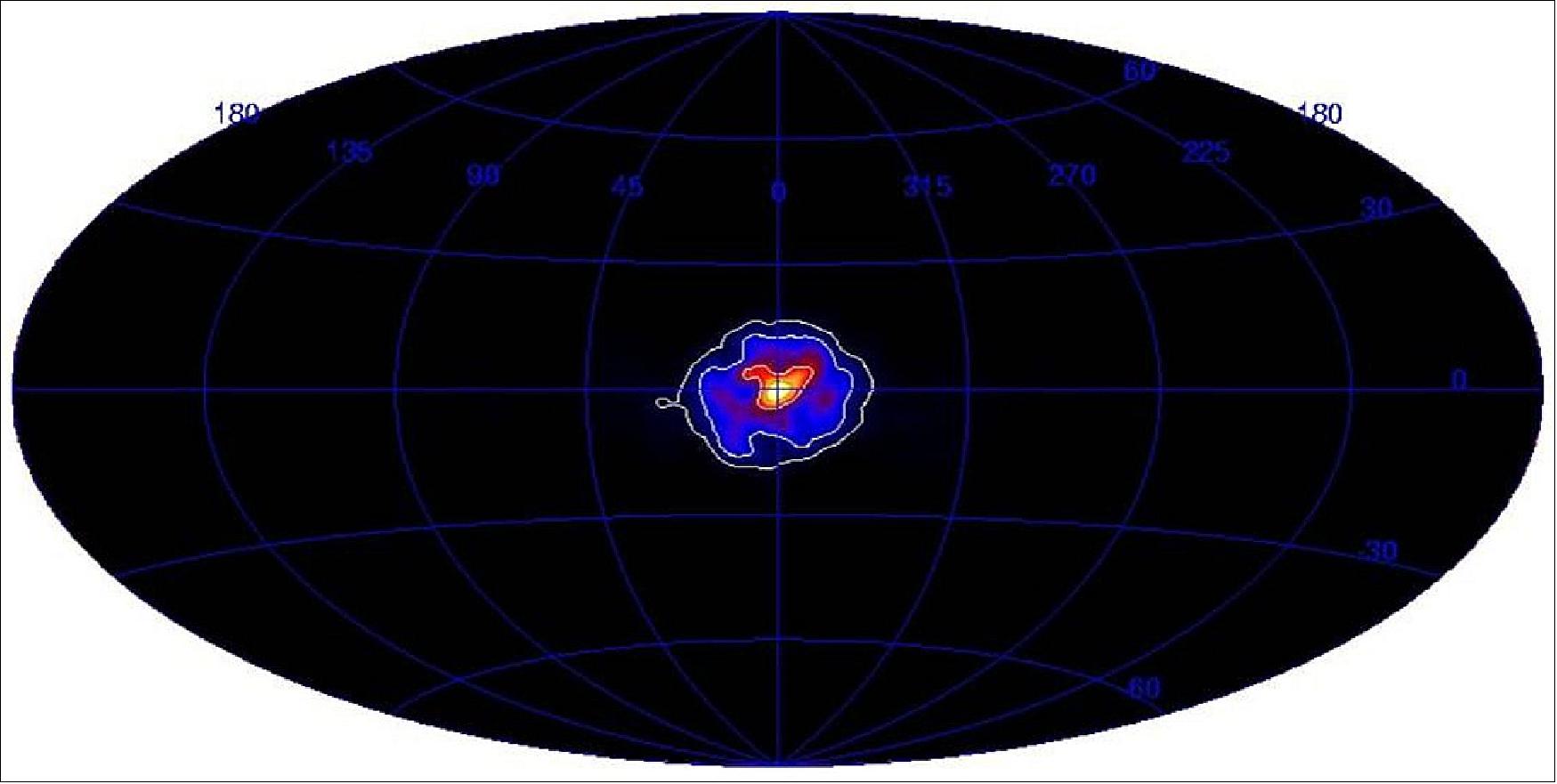
- Within months of operation, INTEGRAL solved a thirty-year-old mystery by showing that the broadband gamma-ray emission observed towards the center of the galaxy was produced by a hundred individual sources. A catalog of close to 500 gamma-ray sources from all over the sky, most of them new, was then complied.
- Scientists now know that a rare class of anomalous X-ray pulsars, or magnetars, generates magnetic fields a thousand million times stronger than the strongest steady magnetic field achievable in a laboratory on Earth. These sources show, unexpectedly, strong emission in the INTEGRAL energy range.
- INTEGRAL revealed that a sub-class of X-ray binary stars, called super-giant fast X-ray transients, previously thought to be extremely rare, is actually common in our galaxy. The satellite has also discovered a completely new class of high-mass X-ray binaries, called highly absorbed X-ray binaries.
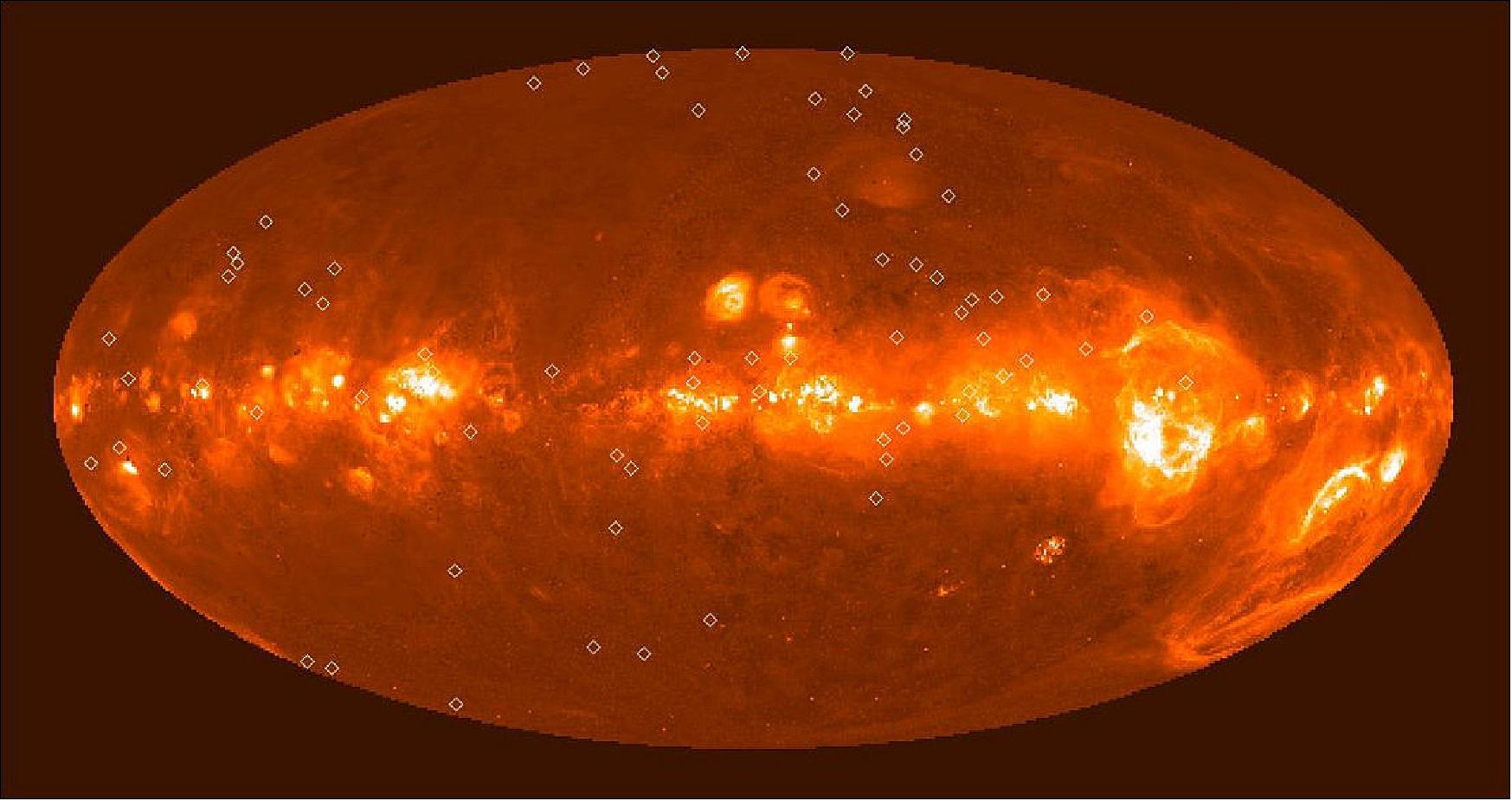
- INTEGRAL has seen about 100 of the brightest supermassive black holes, the main producers of gamma radiation in our universe, in other galaxies. But while looking for them in nearby galaxies, surprisingly few have been found. - They are either too well-hidden or are only present in the younger galaxies which populate the more distant universe.
- Galaxies throughout the universe are believed to be responsible for creating the diffuse background glow of gamma rays, observed over the entire sky. INTEGRAL used the Earth as a giant shield to disentangle this faint glow. Making the measurements possible was a technological and operational feat.
- The data will help understand the origin of the highest energy background radiation and possibly, provide new clues to the history of growth of supermassive black holes since the early epochs of the Universe.

- Mysterious bursts: Although not designed to be a gamma-ray-burst ‘watchdog’, scientists realized that INTEGRAL could perform this task if assisted by sufficiently powerful software. ESA set a new record for speed and accuracy with the INTEGRAL Burst Alert System on 3 December 2003 when a burst was detected, localized and astronomers were alerted in 18 seconds. - The event, called GRB 031203, was faint and close, in cosmological terms, which suggests that an entire population of low energy gamma-ray bursts has so far gone unnoticed.
- On 27 December 2004, INTEGRAL was hit by the strongest flux of gamma rays ever measured by any spacecraft and it even measured radiation that bounced off the Moon. The culprit was a magnetar, SGR 1806-20, located 50,000 light years away on the other side of our Milky Way. Thanks to this outburst, astronomers now think that some gamma-ray bursts might come from similar magnetars in other galaxies.
- INTEGRAL has also been able to take images of gamma ray bursts, while the telescope was not pointed in the right direction. This was done using radiation that passed through the side of INTEGRAL’s imaging telescope and struck the detector.
- Christoph Winkler, ESA’s INTEGRAL Project Scientist says “INTEGRAL has indeed played a major role in modern gamma-ray astronomy. So much has happened in the span of five years but much more is still to come.”
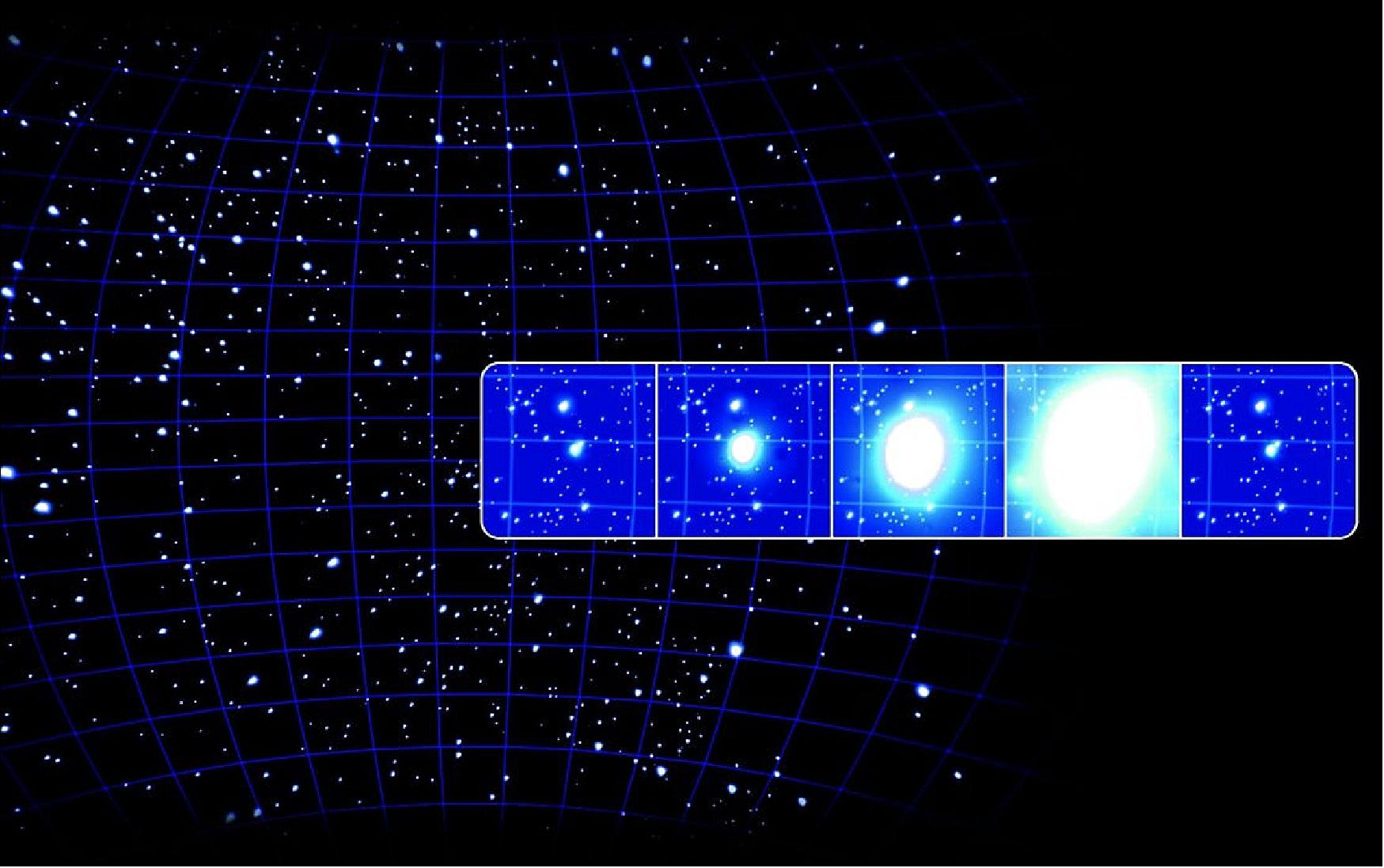
• June 25, 2017: ESA’s orbiting gamma-ray observatory, INTEGRAL, has made a pioneering unequivocal discovery of radioactive iron-60 in our galaxy that provides powerful insight into the workings of massive stars that pervade and shape it. Found drifting in space, the radioactive isotope has been sought for long. All past reported sightings of iron-60 have been subject to controversy. Now INTEGRAL has provided unequivocal evidence. 46) 47)
- Since late 2002, INTEGRAL has been collecting data from across the galaxy. It shows an enhancement in gamma rays at two characteristic energies, 1173 and 1333 keV. These are produced by radioactive decay of iron-60 into cobalt-60.
- Roland Diehl of the MPE (Max-Planck-Institut für extraterrestrische Physik), headed the work and believes it is a major step forward. “These gamma-ray lines have been detected before with some dispute. INTEGRAL, the only instrument capable of doing this, shows that iron-60 (60Fe) does exist in interstellar space in our Galaxy,” he says.
- More than a curiosity, its presence opens a door into the very heart of the most massive stars in the cosmos. The majority of chemical elements are built inside stars from raw ingredients present during star formation from an interstellar gas cloud. In addition to hydrogen and helium produced during the Big Bang, the gas contained enrichments, known to astronomers as ‘metals’, from previous generations of stars and their nuclear reactions.
- Until this detection, astronomers had only one radioactive isotope to probe into the current build-up of chemical elements in stars and their distribution with respect to future star formation. That was the radioactive isotope aluminum-26 (26AL), first discovered in 1978. “The study of aluminum-26 has developed into its own branch of astronomy,” says Diehl.
- Iron-60 gives astronomers valuable new insight - although produced in the same stars as aluminum-26, its production differs markedly. Iron-60 is synthesized both later in a star’s life and deeper inside.
- As massive stars age, they develop a layered structure in which different chemical elements are fused together. While aluminum-26 is one rung on the ladder of nuclear reactions, iron-60 is produced from pre-existing stable iron isotopes by a process called ‘neutron capture’ in the respective layers where helium and carbon atoms are undergoing fusion.
- “Iron-60 provides the entry into studying neutron capture in stars through contemporaneous radioactivity,” says Diehl. It has also prompted a number of particle accelerators to begin more detailed studies of how easily iron captures neutrons.
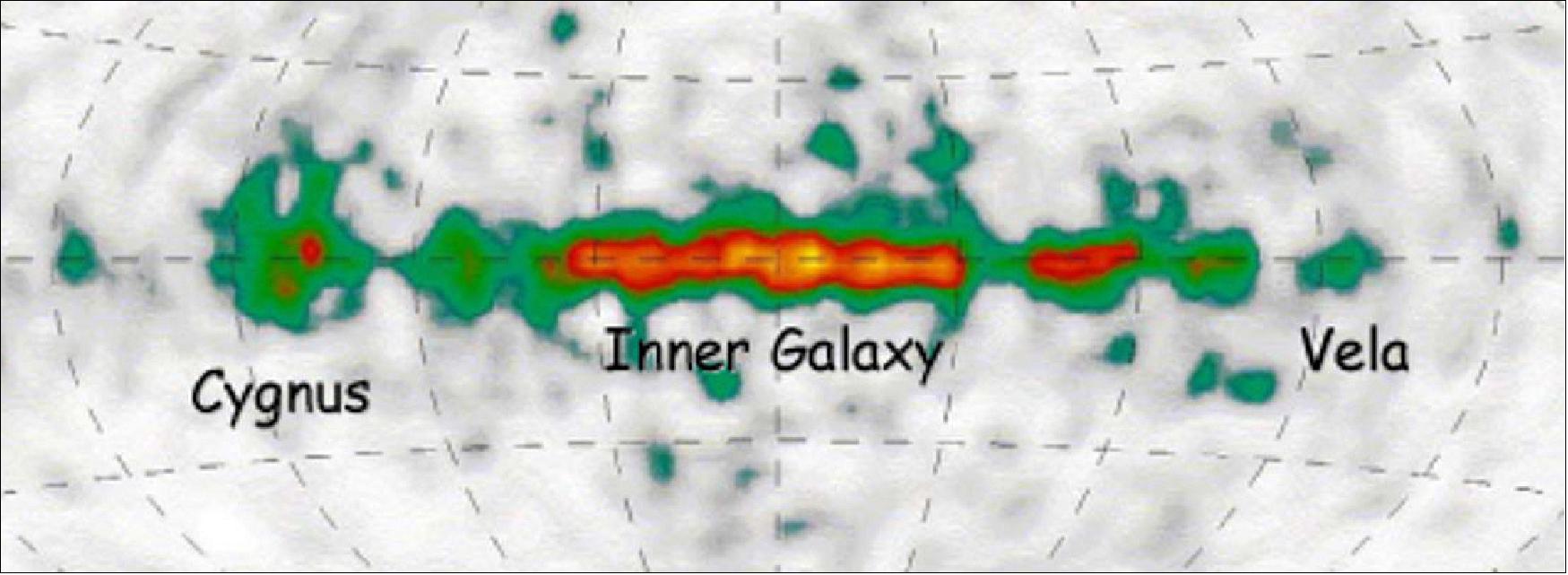
- Unlike aluminum-26, iron-60 is only expelled into space when the star explodes at the end of its life. It then decays with a half-life of 1.5 million years, producing the gamma rays that INTEGRAL detected.
- The new data pins down the ratio of iron-60 to aluminum-26, which has a half-life of 740,000 years. Previous predictions have fallen anywhere between 10 and 100 percent. INTEGRAL shows it to be 15 percent, which agrees well with current theoretical estimates. But theoreticians and nuclear physicists have been stimulated by INTEGRAL’s results to strive for more precise predictions.
- Although INTEGRAL clearly sees the telltale gamma rays, they are too faint for it to map out enhancements and paucities across the Galaxy. “Mapping the distribution of iron-60 is a job for the next generation of gamma-ray instruments,” says Diehl.
- Nevertheless, the team will continue observing with INTEGRAL for as long as they can, in the hope of gaining some coarse ideas about the isotope’s spread across the Galaxy.
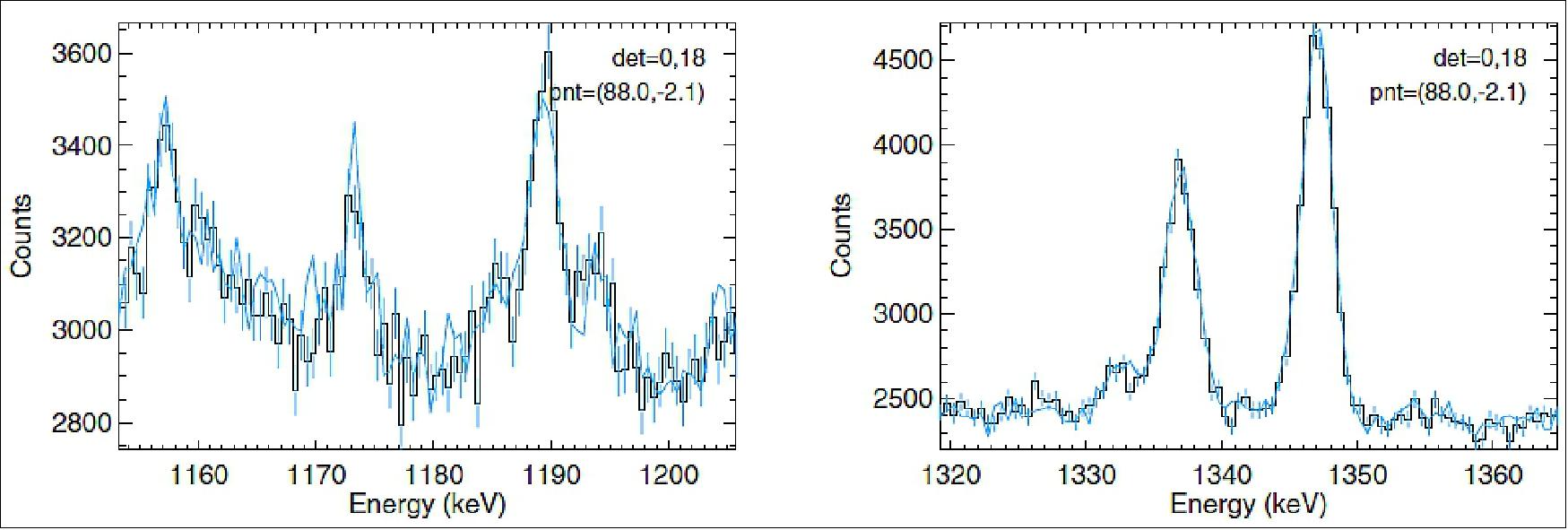
• November 27, 2006: ESA's gamma-ray observatory, INTEGRAL, has spotted a rare kind of gamma-ray outburst. The vast explosion of energy allowed astronomers to pinpoint a possible black hole in our Galaxy. The outburst was discovered on 17 September 2006 by staff at the ISDC (INTEGRAL Science Data Center), Versoix, Switzerland. Inside the ISDC, astronomers constantly monitor the data coming down from INTEGRAL because they know the sky at gamma-ray wavelengths can be a swiftly changing place. 48)
- "The galactic center is one of the most exciting regions for gamma ray astronomy because there are so many potential gamma-ray sources," says Roland Walter, an astronomer at the ISDC, and lead author of these results.
- To reflect the importance of this region, INTEGRAL is now running a Key Program, in which almost four weeks of its observing time is given over to the study of the galactic center. This is allowing astronomers to understand the gamma-ray characteristics of the galactic center and its celestial objects, better than ever before.
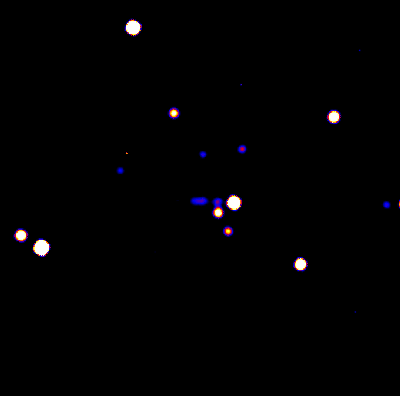
- It was during one of the first of these observations that astronomers saw the outburst take place. An unexpected event of this kind is known as a 'target of opportunity'. At first they did not know what kind of eruption they had detected. Some gamma ray outbursts last for only a short period of time and so they immediately alerted other observatories around the world of the outburst’s position, allowing them to target the explosion, too. Fortunately, INTEGRAL has the capability to pinpoint the position of such a very bright event incredibly accurately.
- In this case, the outburst continued to rise in brightness for a few days before beginning a gradual decline that lasted for weeks. The way the brightness of an outburst rises and falls is known to astronomers as a light curve. "It was only after a week that we could see the shape of the light curve and realized what a rare event we had observed," says Walter (Figure 47).
- Comparing the shape of the light curve to others on file revealed that this was an eruption thought to come from a binary star system in which one component is a star like our Sun whereas the other is a black hole.
- In these systems, the gravity of the black hole is ripping the Sun-like star to pieces. As the doomed star orbits the black hole, it lays down its gas in a disc, know as an accretion disc, surrounding the black hole.
- Occasionally, this accretion disc becomes unstable and collapses onto the black hole, causing the kind of outburst that INTEGRAL witnessed. Astronomers are still not sure why the accretion disc should collapse like this but one thing is certain: when it does collapse, it releases thousands of times the energy than at other times.
- Because such active star–black hole binaries are thought to be rare in the Galaxy, astronomers expect INTEGRAL to see such an outbursts only once every few years. That makes each and every one a precious resource for astronomers to study.
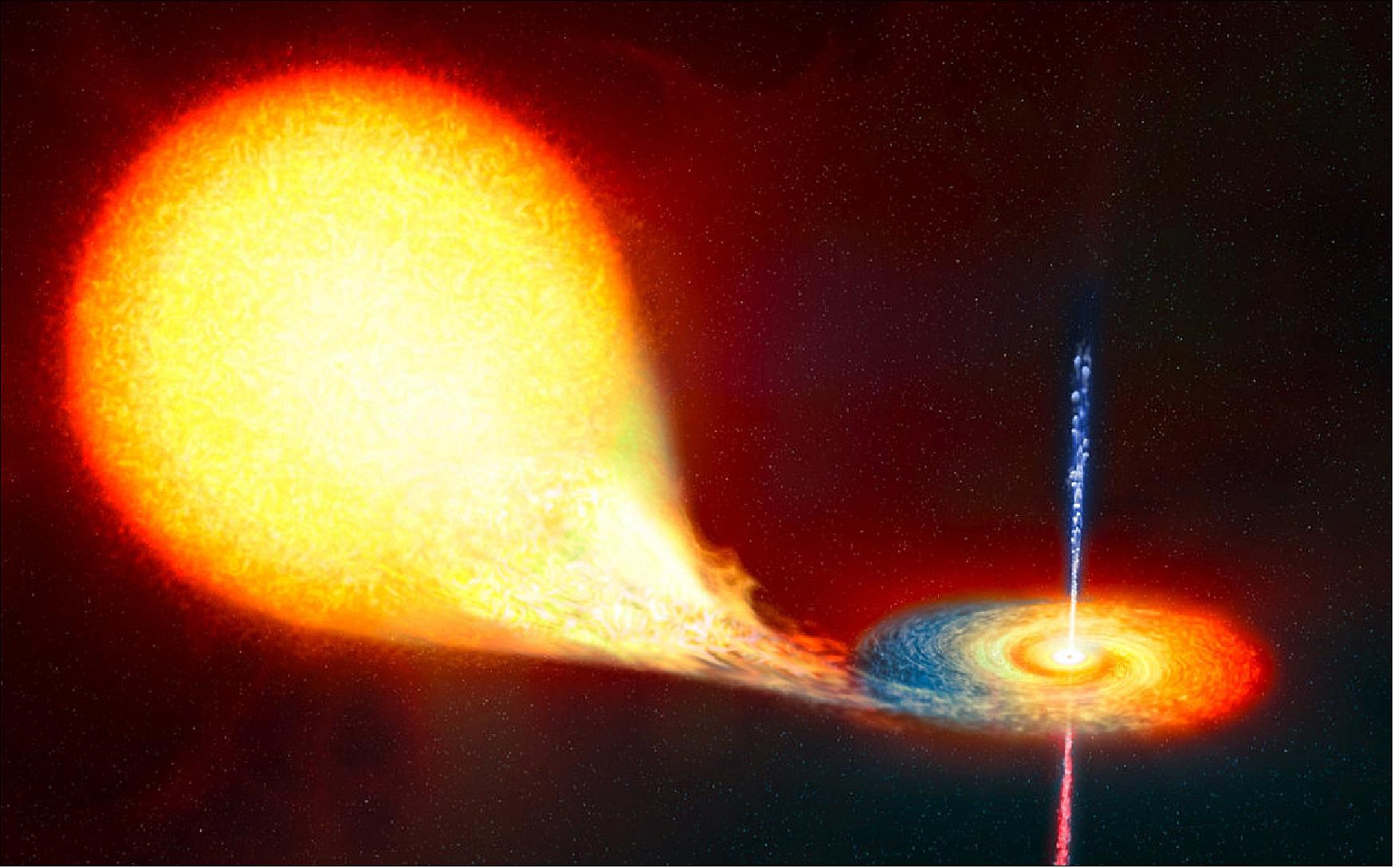
• September 7, 2006: Astronomers using ESA's orbiting gamma-ray observatory, INTEGRAL, have taken an important step towards estimating how many black holes there are in the Universe. An international team, led by Eugene Churazov and Rashid Sunyaev of IKI (Space Research Institute), Moscow, and involving scientists from all groups of the INTEGRAL consortium, used the Earth as a giant shield to watch the number of tell-tale gamma rays from the distant Universe dwindle to zero, as our planet blocked their view (Figure 48). 49)
- "Point INTEGRAL anywhere in space and it will measure gamma rays," says Pietro Ubertini from INAF, Italy, and Principal Investigator on INTEGRAL's gamma-ray imager. Most of those gamma rays do not come from nearby sources but from celestial objects so far away that they cannot yet be distinguished as individual sources. This distant gamma-ray emission creates a perpetual glow that bathes the Universe.
- Most astronomers believe that the unseen objects are supermassive black holes, millions or billions of times heavier than the Sun and each sitting at the center of a galaxy. As the black holes swallow matter, the swirling gases release X-rays and gamma rays. Accurately measuring the glow, known as the X-ray and gamma-ray background, is the first step towards calculating how many black holes are contributing to it and how far away in the Universe they are located.
- The new INTEGRAL observations were made during January and February 2006 and provide highly accurate data on the gamma-ray background. The key to success was using the Earth as a shield.
- The new INTEGRAL observations were made during January and February 2006 and provide highly accurate data on the gamma-ray background. The key to success was using the Earth as a shield.
- Allowing the Earth to enter INTEGRAL's field of view goes against the standard set of nominal observations for the satellite, because the optical devices needed to determine the spacecraft’s attitude would be blinded by the bright Earth. So, this operation required remarkable efforts from the ISOC/MOC teams operating the mission, who had to rely on alternative spacecraft control mechanisms. But the risk was worth it: by measuring the decrease of the gamma-ray flux once the Earth had blocked INTEGRAL's view and by making a model of the Earth’s atmospheric emission, the astronomers precisely gaged the gamma-ray background.
- Another bonus of the INTEGRAL observations is that the observatory's complementary instruments allowed the strength of both X-rays and gamma rays to be measured simultaneously. In the past, different satellites have had to measure the different energies of X-rays and gamma rays, leaving astronomers with the task of having to piece the results together like the pieces of a jigsaw puzzle.
- It is not just the overall glow that INTEGRAL has seen. Before the satellite's launch, only a few dozen celestial objects were observed in gamma rays. Now INTEGRAL sees about 300 individual sources in our Galaxy and around 100 of the brightest supermassive black holes in other galaxies. These are the tip of the iceberg. Astronomers believe there are tens of millions of active black holes spread throughout space, all contributing to the gamma-ray background. From earlier observations in the softer X-ray band it is known that the soft background radiation is almost entirely populated by AGN (Active Galactic Nuclei). So it is highly likely that these objects are also responsible here at higher INTEGRAL energies, even if this is not proven yet.
- The next step is for astronomers to program computer models to calculate how the emission from this unseen population of black holes merges to give the observed glow. These computer models will predict the number and distance of the black holes, and provide insights into the way they behave at the center of young, middle-aged and old galaxies. Meanwhile, the INTEGRAL team will continue to refine their measurements of the perplexing gamma-ray background.
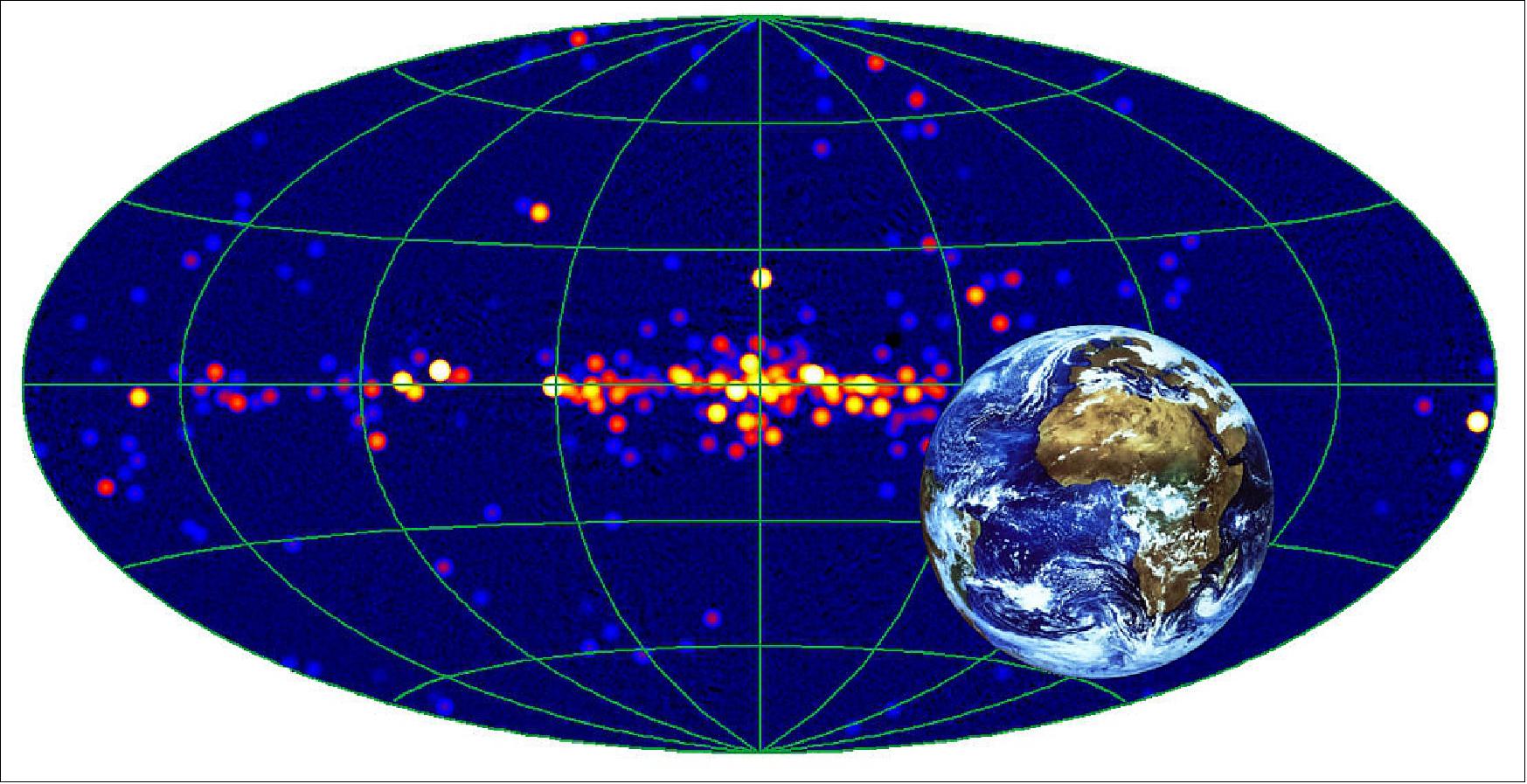
Legend to Figure 48: The sources in this image were artificially blurred and the color map was stretched to make both strong and weak sources readily visible. The concentration of sources along the mid plane of the image is due to neutron stars and stellar mass black holes in our Galaxy, while the majority of sources located far away from the Galactic plane are super-massive black holes in other galaxies. The Cosmic X-ray Background is composed from the emission of tens of millions of similar objects much further away from us.
Superposed is an Earth image by ESA/EUMETSAT’s Meteosat satellite. Using the Earth as a shield to block the emission from the population of distant black holes astronomers precisely gaged the X-ray and gamma-ray background. An angular size of the Earth as seen from INTEGRAL during actual observations was smaller than shown in the image.
• December 5, 2005: ESA's Science Program Committee has extended operations of the highly successful astronomical observatories INTEGRAL and XMM-Newton for four years, until 16 December 2010 and 31 March 2010, respectively. As usual, there will be a review of the scientific performance and of the missions status in another two years' time, around autumn 2007. 51)
• September 6, 2005: ESA's INTEGRAL space observatory, together with NASA's Rossi X-ray Timing Explorer spacecraft, has found a fast-spinning pulsar in the process of devouring its companion. 52)
- This finding supports the theory that the fastest-spinning isolated pulsars get that fast by cannibalizing a nearby star. Gas ripped from the companion fuels the pulsar's acceleration. This is the sixth pulsar known in such an arrangement, and it represents a 'stepping stone' in the evolution of slower-spinning binary pulsars into faster-spinning isolated pulsars.
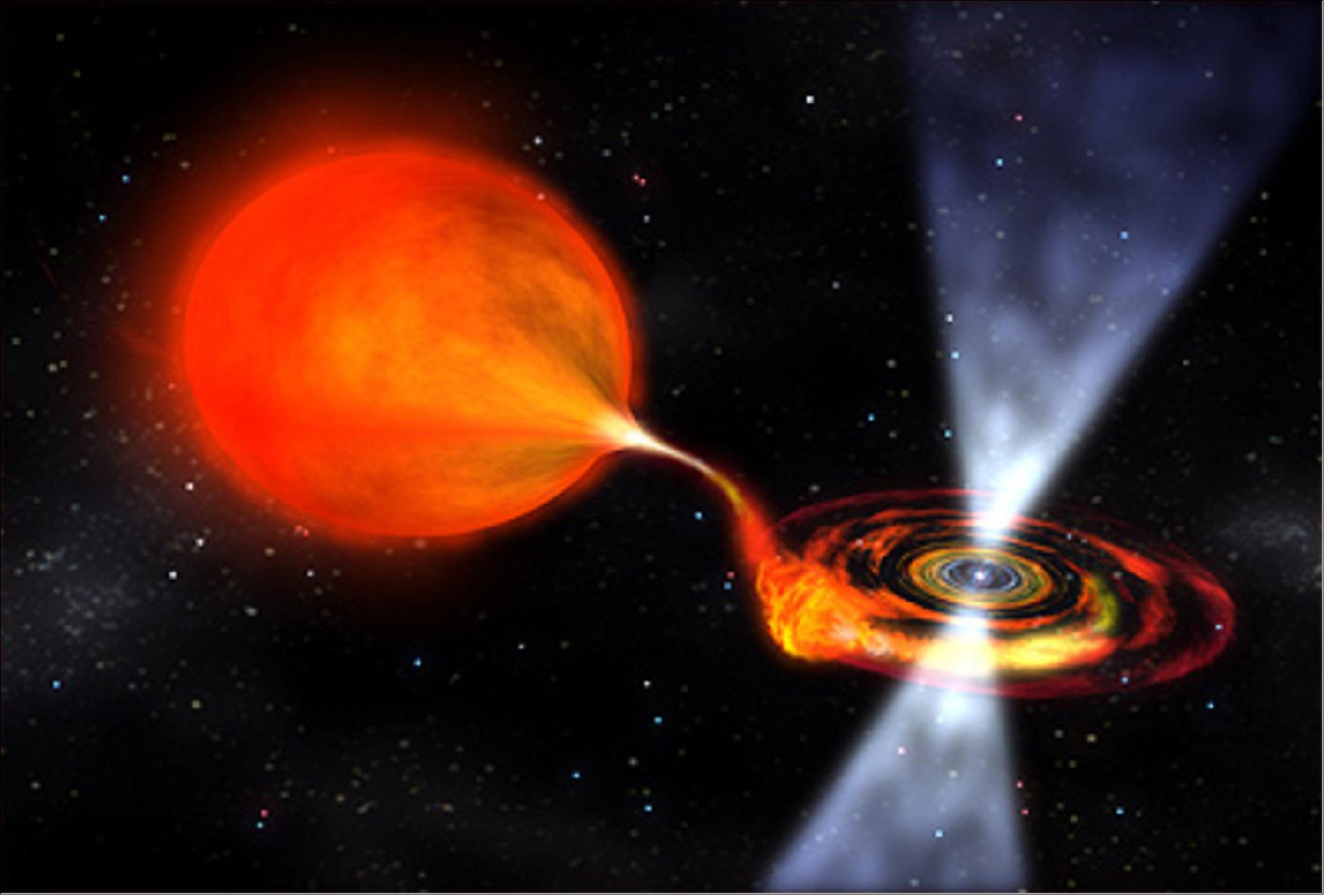
- "We're getting to the point where we can look at any fast-spinning, isolated pulsar and say, 'That guy used to have a companion'," said Dr Maurizio Falanga, who led the INTEGRAL observations, at CEA (Commissariat à l'Energie Atomique) in Saclay, France.
- 'Pulsars' are rotating neutron stars, which are created in stellar explosions. They are the remnants of stars that were once at least eight times more massive than the Sun. These stars still contain about the mass of our Sun compactified into a sphere of only about 20 km across.
- This pulsar, called IGR J00291+5934, belongs to a category of 'X-ray millisecond pulsars', which pulse with the X-ray light several hundred times a second, one of the fastest known. It has a period of 1.67 milliseconds which is much smaller than most other pulsars that rotate once every few seconds.
- Neutron stars are born rapidly spinning in collapses of massive stars. They gradually slow down after a few hundred thousand years. Neutron stars in binary star systems, however, can reverse this trend and speed up with the help from the companion star.
- For the first time ever, this speeding-up has been observed in the act. "We now have direct evidence for the star spinning faster whilst cannibalizing its companion, something which no one had ever seen before for such a system," said Dr Lucien Kuiper from the Netherlands Institute for Space Research (SRON), in Utrecht.
- A neutron star can remove gas from its companion star in a process called 'accretion'. The flow of gas onto the neutron star makes the star spin faster and faster. Both the flow of gas and its crashing upon the neutron star surface releases much energy in the form of X-ray and gamma radiation.
- Neutron stars have such a strong gravitational field that light passing by the star changes its direction by almost 100 degrees (in comparison light passing by the Sun is deflected by an angle which is 200 thousand times smaller). "This 'gravitational bending' allows us to see the back side of the star," points out Prof. Juri Poutanen from the University of Oulu, Finland.
- "This object was about ten times more energetic than what is usually observed for similar sources," said Falanga. "Only some kind of monster emits at these energies, which corresponds to a temperature of almost a billion degrees."
• July 13, 2005: An international team of scientists has uncovered a rare type of neutron star so elusive that it took three satellites to identify it. The findings, made with ESA’s INTEGRAL satellite and two NASA satellites, reveals new insights about star birth and death in our Galaxy. We report this discovery, highlighting the complementary nature of European and US spacecraft, on the day in which ESA’s INTEGRAL celebrates 1000 days in orbit. 54) 55)
- The neutron star, called IGR J16283-4838, is an ultra-dense ‘member’ of an exploded star and was first seen by INTEGRAL on 7 April 2005. This neutron star is about 20,000 light years away, in a ‘double hiding place’. This means it is deep inside the spiral arm Norma of our Milky Way galaxy, obscured by dust, and then buried in a two-star system enshrouded by dense gas.
- “We are always hunting for new sources,” said Simona Soldi, the scientist at the ISDC (INTEGRAL Science Data Center) in Geneva, Switzerland, who first saw the neutron star. “It is exciting to find something so elusive. How many more sources like this are out there?”
- Neutron stars are the core remains of ‘supernovae’, exploded stars once about ten times as massive as our Sun. They contain about a Sun's worth of mass compacted into a sphere about 20 km across. “Our Galaxy’s spiral arms are loaded with neutron stars, black holes and other exotic objects, but the problem is that the spiral arms are too dusty to see through,” said Volker Beckmann at NASA/GSFC (Goddard Spaceflight Center), lead author of the combined results. “The right combination of X-ray and gamma-ray telescopes could reveal what is hiding there, and provide new clues about the true star formation rate in our Galaxy,” he added.
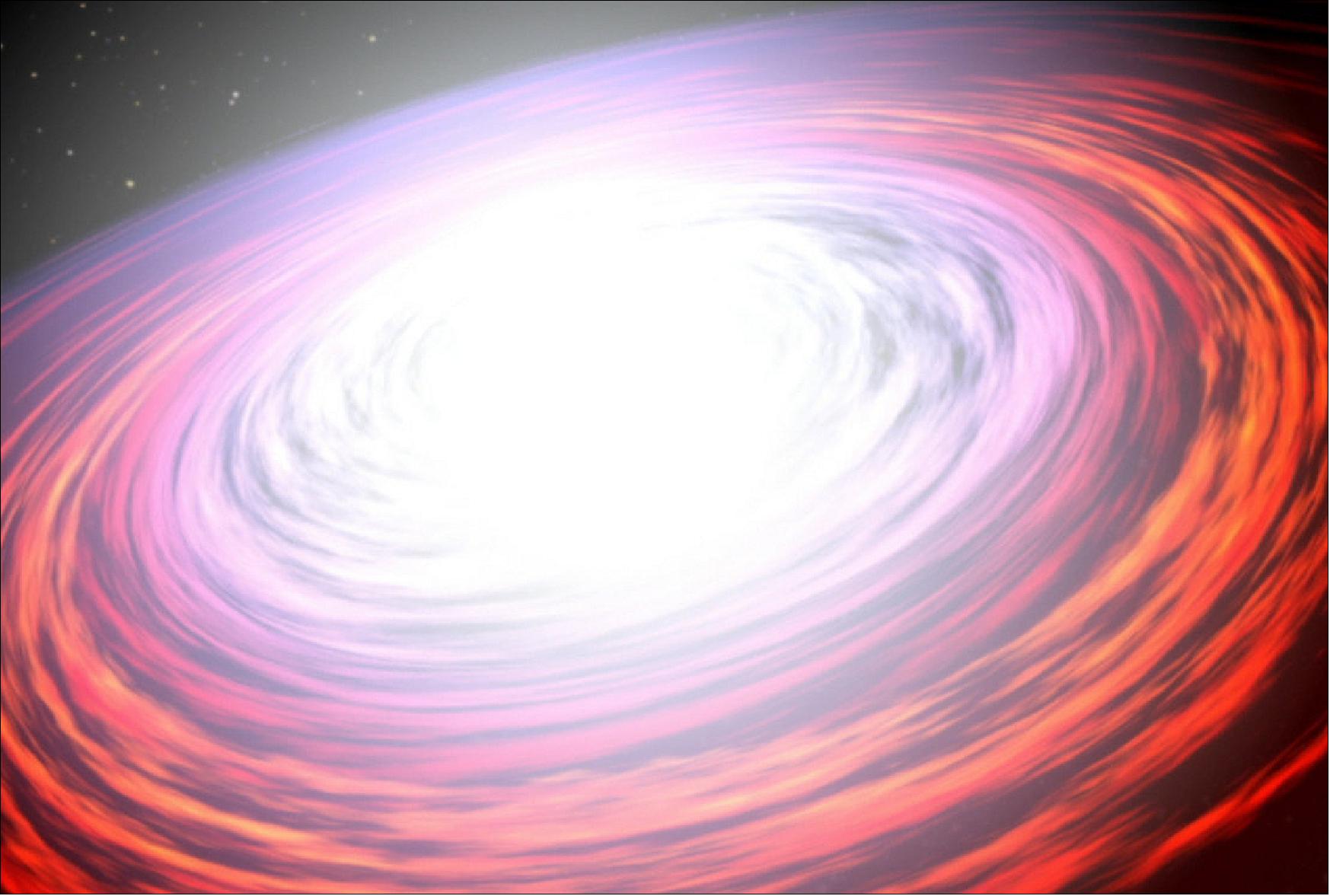
- Because the INTEGRAL scientists could not immediately decipher the nature of the object, they enlisted the help of NASA's Rossi X-ray Timing Explorer and the newly launched Swift satellite to observe it in different wavelengths.
- Because gamma rays are hard to focus into sharp images, the science team then used the X-ray telescope on Swift to determine a precise location. In mid April 2005, Swift confirmed that the light was ‘highly absorbed’, which means the binary system was filled with dense gas from the stellar wind of the companion star.
- Later the scientists used the Rossi Explorer to observe the source as it faded away. This observation revealed a familiar light signature, clinching the case for a fading high-mass X-ray binary with a neutron star.
- IGR J16283-4838 is the seventh so-called ‘highly absorbed’, or hidden neutron star to be identified. Neutron stars, created from fast-burning massive stars, are intrinsically tied to star formation rates. They are also energetic ‘beacons’ in regions too dusty to study in detail otherwise. As more and more are discovered, new insights about what is happening in the Galaxy's spiral arms begin to emerge.
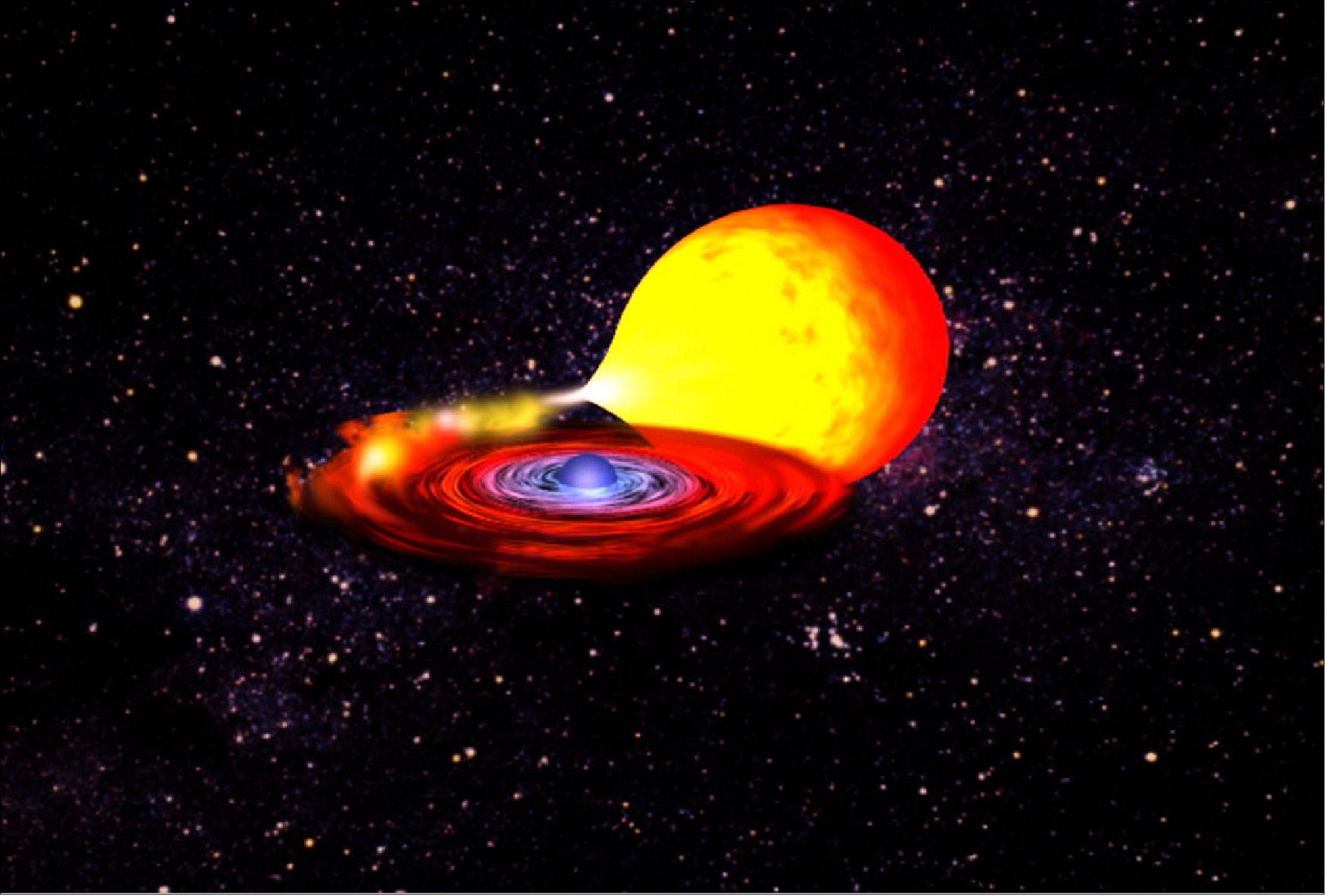
- IGR J16283-4838 revealed itself with an ‘outburst’ on or near its surface. Neutron stars such as IGR J16283-4838 are often part of binary systems, orbiting a normal star. Occasionally, gas from the normal star, lured by gravity, crashes onto the surface of the neutron star and releases a great amount of energy. These outbursts can last for weeks before the system returns to dormancy for months or years.
- INTEGRAL, the Rossi Explorer and Swift all detect X-rays and gamma rays, which are far more energetic than the visible light that our eyes detect. Yet each satellite has different capabilities. INTEGRAL has a large field of view, enabling it to scan our Milky Way galaxy for neutron stars and black hole activity.
- Swift contains a high-resolution X-ray telescope, which allowed scientists to zoom in on IGR J16283-4838. The Rossi Explorer has a timing spectrometer, a device used to uncover properties of the light source, such as speed and rapid variations in the order of milliseconds.
• February 18 2005: Astrophysicists from the MPE (Max-Planck-Institut für extraterrestrische Physik) in Garching near Munich measured the strongest burst from a magnetar. On December 27, 2004 at 21:30:26 UT the Earth was hit by a huge wave front of gamma and X-rays. It was the strongest flux of high-energetic gamma radiation measured so far. It was measured with the SPI spectrometer aboard the INTEGRAL satellite by the team of Roland Diehl and Giselher Lichti from the MPE . The wave front was in addition more intense than the strongest radiation burst measured so far from our sun. 56)
- The remarkable aspect of this discovery is the origin of this radiation: it originates from a tiny celestial body with an extreme density, a neutron star, a so-called magnetar, and with an extremely strong magnetic field which is located on the other side of our Milky Way at a distance of about 50,000 light years. The astrophysicists from Garching are confident that this event will cast new light on the physics of magnetars and that it will contribute to solve an old puzzle concerning the gamma-ray bursts.
• August 5, 2004: A gamma-ray burst detected by ESA's INTEGRAL gamma-ray observatory on 3 December 2003 has been thoroughly studied for months by an armada of space and ground-based observatories. Astronomers have now concluded that this event, called GRB 031203, is the closest cosmic gamma-ray burst on record, but also the faintest. This also suggests that an entire population of sub-energetic gamma-ray bursts has so far gone unnoticed. 57) 58) 59)
- Cosmic GRBs (Gamma-Ray Bursts) are flashes of gamma rays that can last from less than a second to a few minutes and occur at random positions in the sky. A large fraction of them is thought to result when a black hole is created from a dying star in a distant galaxy. Astronomers believe that a hot disc surrounding the black hole, made of gas and matter falling onto it, somehow emits an energetic beam parallel to the axis of rotation.
- According to the simplest picture, all GRBs should emit similar amounts of gamma-ray energy. The fraction of it detected at Earth should then depend on the 'width' (opening angle) and orientation of the beam as well as on the distance. The energy received should be larger when the beam is narrow or points towards us and smaller when the beam is broad or points away from us. New data collected with ESA's high energy observatories, INTEGRAL and XMM-Newton, now show that this picture is not so clear-cut and that the amount of energy emitted by GRBs can vary significantly. "The idea that all GRBs spit out the same amount of gamma rays, or that they are 'standard candles' as we call them, is simply ruled out by the new data," said Dr Sergey Sazonov, from IKI (Space Research Institute) of the Russian Academy of Sciences, Moscow (Russia) and the Max-Planck Institute for Astrophysics, Garching near Munich (Germany).
- Sazonov and an international team of researchers studied the GRB detected by INTEGRAL on 3 December 2003 and given the code-name of GRB 031203. Within a record 18 seconds of the burst, the INTEGRAL Burst Alert System had pinpointed the approximate position of GRB 031203 in the sky and sent the information to a network of observatories around the world. A few hours later one of them, ESA's XMM-Newton, determined a much more precise position for GRB 031203 and detected a rapidly fading X-ray source, which was subsequently seen by radio and optical telescopes on the ground.
- This wealth of data allowed astronomers to determine that GRB 031203 went off in a galaxy less than 1300 million light years away, making it the closest GRB ever observed. Even so, the way in which GRB 031203 dimmed with time and the distribution of its energy were not different from those of distant GRBs. Then, scientists started to realize that the concept of the 'standard candle' may not hold. "Being so close should make GRB 031203 appear very bright, but the amount of gamma-rays measured by INTEGRAL is about one thousand times less than what we would normally expect from a GRB," Sazonov said.
- A team of US astronomers, coordinated by Alicia Soderberg from the California Institute of Technology, Pasadena (USA), studied the 'afterglow' of GRB 031203 and gave further support to this conclusion. The afterglow, emitted when a GRB's blastwave shocks the diffuse medium around it, can last weeks or months and progressively fades away. Using NASA's Chandra X-ray Observatory, Soderberg and her team saw that the X-ray brightness of the afterglow was about one thousand times fainter than that of typical distant GRBs. The team's observations with the Very Large Array telescope of the National Radio Astronomy Observatory in Socorro (USA) also revealed a source dimmer than usual.
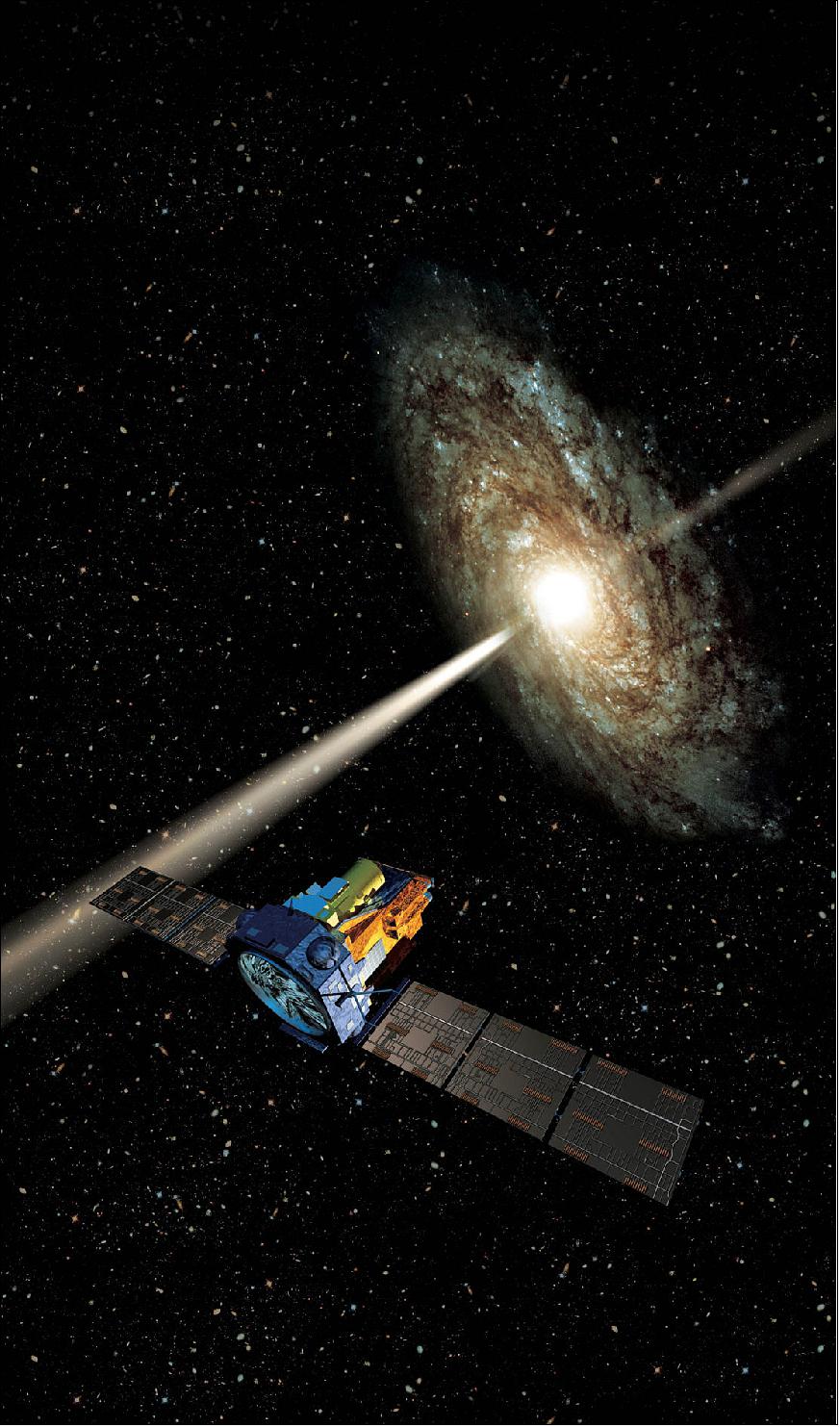
• November 2003: A space operations summary of the INTEGRAL spacecraft after one year in orbit. — Both the ground and space operations segments were active from the beginning of the mission. Despite some initial problems, operations have been conducted with high efficiency with, for example, 97.3% of the slewing maneuvers executed as planned. The only major changes to the ground segment were made to support an on-board change to the INTEGRAL software, which allowed 25% more telemetry to be transmitted to the ground. With this change INTEGRAL could transmit all the necessary science telemetry, so mitigating the earlier problems highlighted once the full complement of instruments were operational. 60)
- The performance of the space segment has remained good and the spacecraft has not exhibited any anomalies that could not be handled by the ground teams. As is only to be expected with such a complex mission, changes to the configurations and operational procedures of the various instruments have been implemented to take into account ‘in-space experience’, including five patches to the onboard software.
- The ISDC is routinely providing data and processed products to observers within 6 weeks of their observations – a remarkable feat given the complexity of the INTEGRAL data. For more detailed analyses, the ISDC also provides a complete set of analysis software that can be installed on the user’s own computer.
- Spacecraft Platform: All the Service Module subsystems continue to operate nominally and there have been no major anomalies on any unit. There has been no emergency Sun re-acquisition so far. Full redundancy is still available, with full solar-array power and no degradation identified. There have been periodic calibrations of the spacecraft thrusters and sensors to improve operational efficiency.
- Eclipses: Two eclipse seasons have been experienced so far. In the winter season eclipses occurred during revolutions 26 to 35, and in the summer season during revolutions 84 to 92. All subsystems performed nominally during these periods. The maximum depth of discharge experienced by the batteries was low, at 21.5% and 27.29%, during the two eclipse seasons.
- Fuel Consumption: The fuel consumed so far is 366.9 kg, from an initial 541.9 kg. 359.9 kg was used during the LEOP (Launch and Early Orbit Phase) mainly to raise the perigee height. This left 181.9 kg for operations. The average usage of 0.7 kg/month since then has been for reaction-wheel biasing. There is currently 174.9 kg left for future operations – enough for more than 15 years at the current rate of consumption.
- Instrument Calibration Activities: The main INTEGRAL calibration target for the high-energy instruments is the Crab Nebula. This is a bright high-energy source whose properties change only slowly with time. It has been observed by nearly all the high-energy missions flown and is used for comparing results from one mission to another. INTEGRAL has observed the Crab Nebula twice, from 7 to 27 February and from 14 to 17 August 2003. INTEGRAL will continue to observe the Crab Nebula every ~6 months in order to monitor the stability of the instruments.
- Due to radiation damage to the SPI’s germanium detectors, it is necessary to anneal, or bake them out, approximately every 6 months. The first annealing took place between 6 and 13 February 2003 and the second between 18 and 24 July. These have enabled the SPI’s energy resolution to be maintained to within 15% of its pre-launch value. The ability to anneal in space is a first for this type of instrument, able to measure the energy of a gamma-ray to 1 part in 500.
- The OMC’s calibration is maintained by so-called ‘flat field’ observations. Internal light sources are used to illuminate the CCD detector, allowing the instrument’s response to be quantified across the detector plane. It is important that there are no bright stars in the field, so that the intrinsic response can be cleanly measured. The best pointing directions for flat fielding are chosen by the OMC and ISOC teams. Seven such ‘flat field’ calibrations have been performed by the OMC team.
- Science operations: During the first year in orbit, the time available for INTEGRAL science operations was divided between the core program (35%) and general program (65%).
- The general program time is open to the whole science community, who can submit observing proposals. An independent TAC (Time Allocation Committee) then evaluates the proposals and determines which are to be performed based on scientific merit. The core program is reserved for the members of the ISWT (INTEGRAL Science Working Team) in return for their contributions to the mission. The ISWT is composed of instrument and data-center principal investigators, mission scientists, the project scientist, and representatives of the US and Russian scientific communities. This ‘core program’ observing time is used mainly for survey-type activities including regular scans along the GPS (Galactic Plane Scans) and deep exposures of the central radian of the Galaxy (GCDE).
- The GPS consists of a sawtooth pattern of observations along the visible parts of the Galactic Plane, in order to search for new and unexpected events.
• October 20, 2003: INTEGRAL, ESA's powerful gamma-ray space telescope, has discovered what seems to be a new class of astronomical objects. These are binary systems, probably including a black hole or a neutron star, embedded in a thick cocoon of cold gas. They have remained invisible so far to all other telescopes. INTEGRAL was launched one year ago to study the most energetic phenomena in the universe. 61)
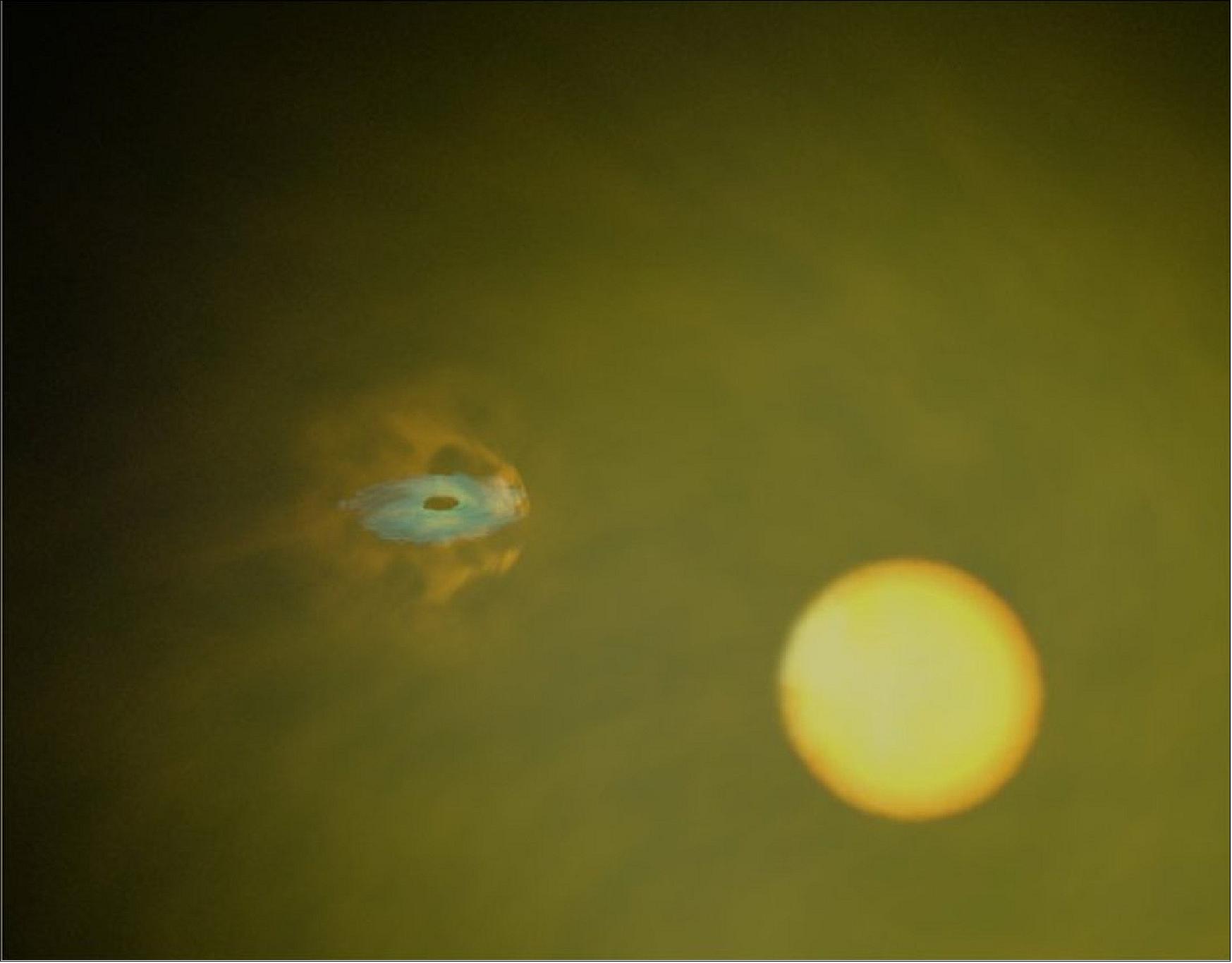
• February 14, 2003: During the galactic plane scan on 29 January2003 a new bright (50-100 mCrab) source was detected close (~1°) to the well-known Black Hole Candidate 4U 1630-47. This first INTEGRAL transient source was designated IGR J16318-4848 and reported in IAU circular 8063 by Courvoisier et al. It is visible in the INTEGRAL picture of the month February (POMFeb2003.html) as the bright spot to the right and below 4U 1630-47. 62)

• December 11, 2002: INTEGRAL, the European Space Agency’s gamma-ray satellite, has taken its first images and collected its first scientific data. These ‘first-light’ images confirm that INTEGRAL is working superbly. Everyone involved with the project is delighted with its performance so far. 63)
- Since its launch on 17 October, scientists have maneuvered INTEGRAL into its operational orbit, thoroughly tested their communications link, and verified the spacecraft's response to their commands. They have also been fine-tuning the instruments by observing the famous black hole, Cygnus X-1. "We have beautiful gamma-ray images and spectra of the sky to show", says Arvind Parmar. Astronomers use spectra to analyze the energy of the radiation that they observe.
- INTEGRAL's results promise to be very special because it has already captured one of the most elusive events in the cosmos – a gamma-ray burst. Gamma-ray bursts are titanic explosions of varying duration that occur about twice daily. Scientists think that collapsing stars in the very distant Universe cause these mysterious, tremendous explosions.
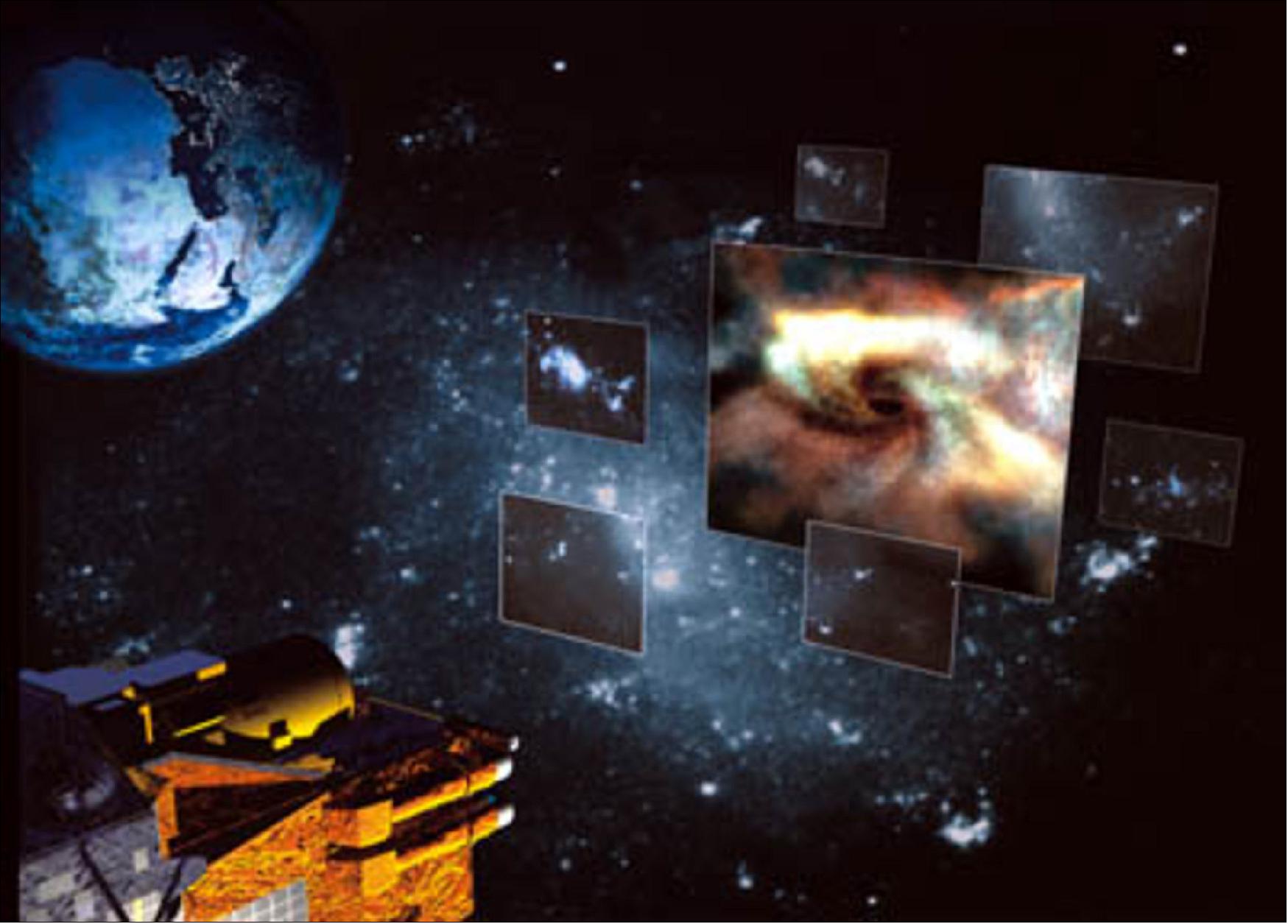
• November 1, 2001: After having successfully completed all orbit transfer maneuvers the final mission orbit has been obtained with perigee height of 9,049.6 km and apogee height of 153,657.2 km, inclination 52.246º. 64)
Sensor Complement
Observing gamma rays is a difficult task. The gamma-ray photons from distant objects are rare and with their penetrating power they cannot be focused by conventional mirrors or lenses. It requires specially designed detectors to register the gamma rays from space and determine their position of origin on the sky. 65)
INTEGRAL has two such detectors on board: an Imager (IBIS) and a Spectrometer (SPI). Two monitoring instruments support these instruments: an X-ray monitor and an optical camera. All four instruments are co-aligned and observe the same region of the sky simultaneously. This allows scientists to clearly identify gamma-ray sources, a key feature in studying high-energy processes in the violent Universe.
All instruments are provided by large collaborations encompassing many scientific institutes in the ESA member states, United States, Russia, Czech Republic, and Poland. Principal investigators in different European countries lead the nationally funded collaborations.
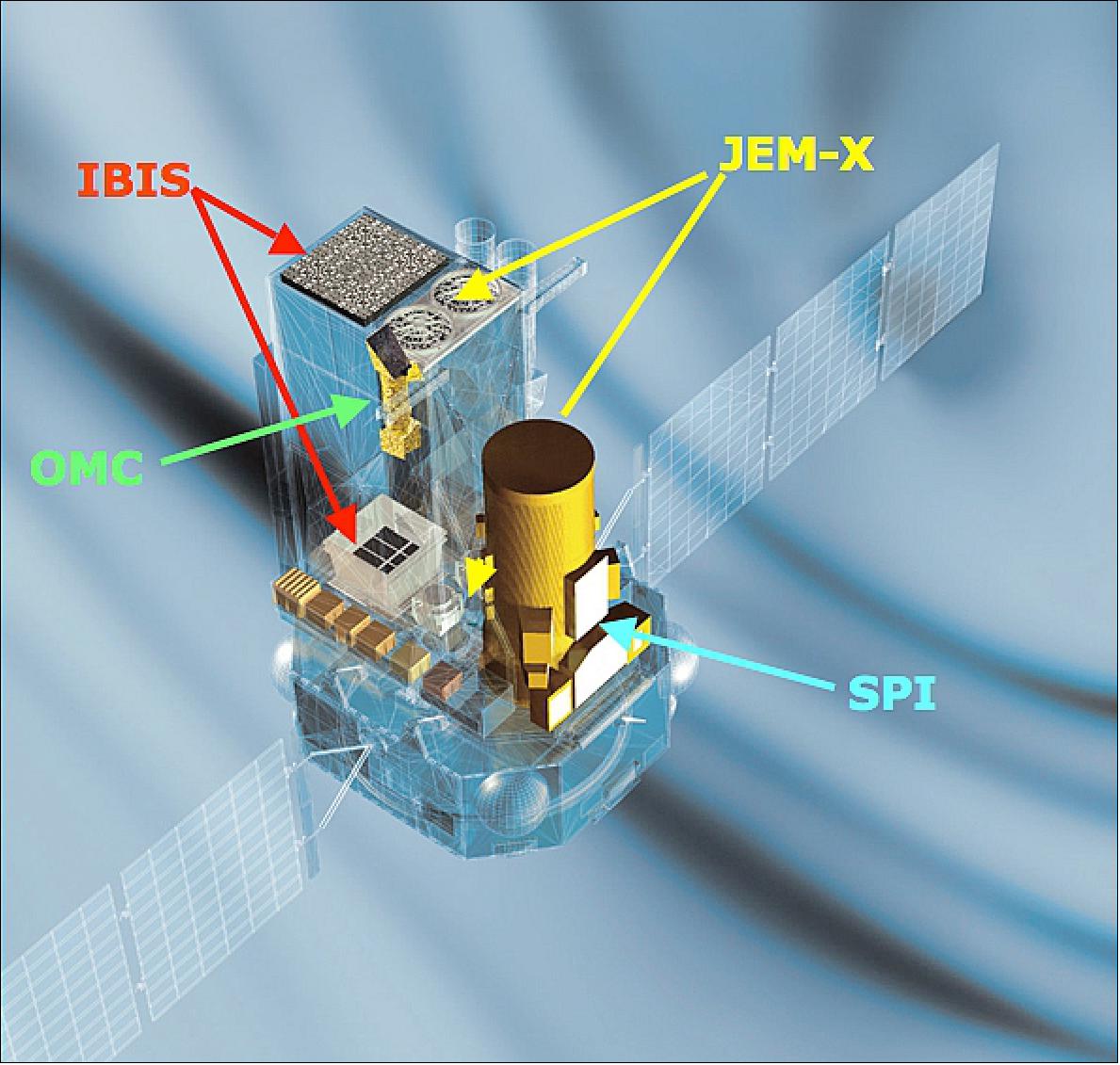
The INTEGRAL payload consists of two main gamma-ray instruments: SPI (Spectrometer on INTEGRAL) and IBIS (Imager on Board the INTEGRAL Satellite).
SPI (Spectrometer on INTEGRAL)
SPI is 100 times more sensitive than the previous high spectral-resolution space instruments. SPI performs spectral analysis of gamma-ray point sources and extended regions over an energy range between 18 keV and 8 MeV with an unprecedented energy resolution of 2.2 keV (FWHM) at 1.33 MeV. This is accomplished using an array of 19 hexagonal high purity Germanium detectors cooled by a Stirling cooler system to an operating temperature of 85 K. It makes the Spectrometer extremely heavy with a mass of 1300 kg. 66)
The PIs (Principal Investigators) of the SPI are: J.-P. Roques, CESR (Centre d'Etude Spatiale des Rayonnements), Toulouse, France and R. Diehl MPE (Max Planck Institute for Extraterrestrial Physics), Garching, Germany.
The total detection area is 500 cm2. A hexagonal coded aperture mask is located 1.7 m above the detection plane in order to image large regions of the sky (fully coded field of view = 16º) with an angular resolution of 2º. In order to reduce background radiation, the detector assembly is shielded by a veto (anticoincidence) system which extends around the bottom and side of the detector almost completely up to the coded mask. The aperture (and hence contribution by cosmic diffuse radiation) is limited to ~30 º. A plastic veto is provided below the mask to further reduce the 511 keV background.
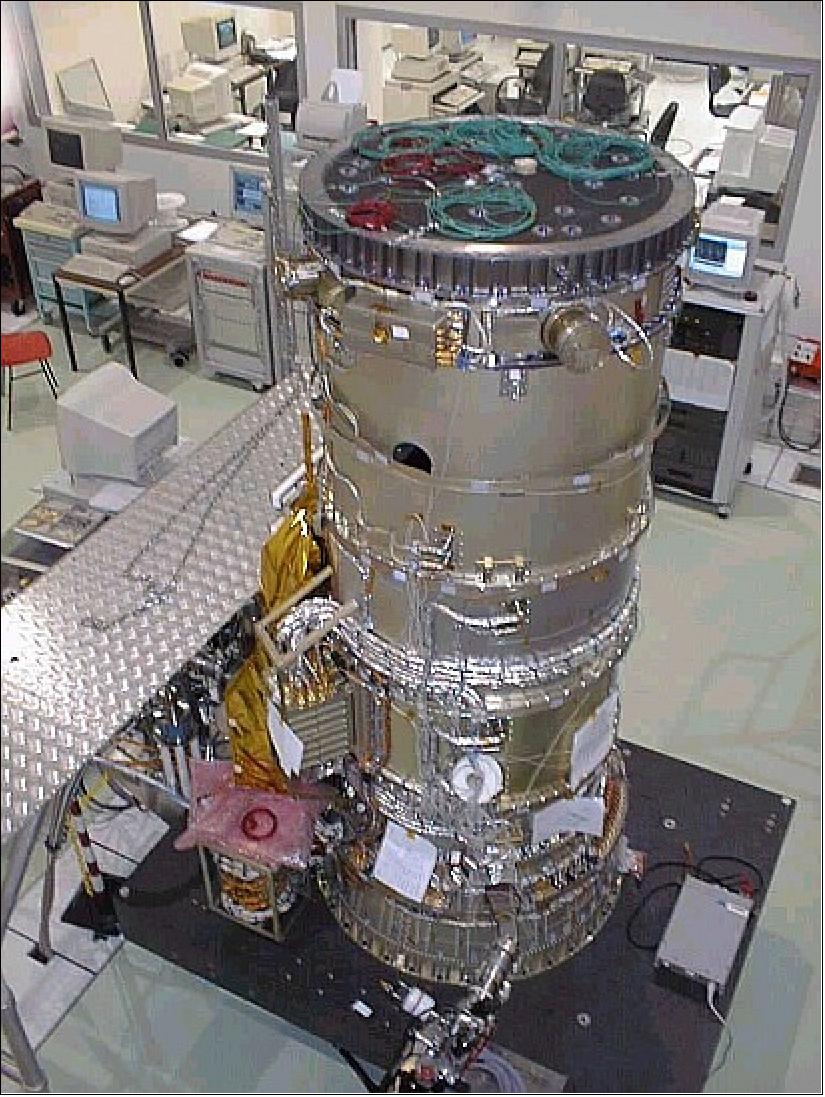
Energy range | 18 keV - 8 MeV |
Detector area | 500 cm2 |
Spectral resolution (E/ΔE @ 1 MeV) | ~ 450 (i.e. 2.33 keV FWHM @ 1.33 MeV) |
FOV (Field of View), fully coded | 14º flat-to-flat; 16º corner-to-corner |
Zero coding | 32º flat-to-flat; 35º corner-to-corner |
Angular resolution (point sources) | 2.5º FWHM (Full Width Half Maximum) |
Point Source Positioning | <1.3º |
Narrow-line sensitivity: - 3σ in 106 s, @ 1 MeV; - 3σ in 106 s, @ 511 keV | 2.4 x 10-5 phs-1cm-2; 4.6 x 10-5 phs-1cm-2 |
Continuum sensitivity (3σ in 106 s, @ 1 MeV) | 8.8 x 10-4 phs-1cm-2MeV-1 |
Timing accuracy (3σ) | 0.129 ms |
Resources [following EID-A (Experiment Interface Document-A) allocation] | |
Mass of instrument | 1309 kg |
Power (sun/eclipse) | 385/110 W |
Data rate | 45 kbit/s |
IBIS (Imager on-Board the INTEGRAL Satellite)
IBIS) is providing sharper gamma-ray images than any previous instrument. IBIS provides diagnostic capabilities of fine imaging (12 arcmin FWHM), source identification and spectral sensitivity to both continuum and broad lines over a broad (15 keV - 10 MeV) energy range. The imager examines, simultaneously with the other instruments on INTEGRAL, celestial objects of all classes ranging from the most compact galactic systems to extragalactic objects. A tungsten coded-aperture mask (located at 3.2 m above the detection plane) is optimized for high angular resolution. 67)
The PIs of IBIS are: P. Ubertini, IAS, Rome, Italy; F. Lebrun, SAp - CEA Saclay, France; G. DiCocco, ITESRE, Bologna, Italy.
As diffraction is negligible at gamma-ray wavelengths, the angular resolution obtainable with a coded mask telescope is limited by the spatial resolution of the detector array. The spatial resolution is dependent on the number of small sensitive elements of the detector, called pixels (picture elements). IBIS has a detector with a large number of pixels, all physically distinct from one another.
The detector uses two parallel planes of pixels located one on top of the other and separated by 90 mm. The top layer (ISGRI) is made of 16 384 cadmium telluride (CdTe) pixels, covering 2600 cm2 and each measuring 4 x 4 x 2 mm. This layer detects the low-energy gamma rays. The second layer (PICsIT) consists of 4096 cesium iodide (CsI) pixels, each 9 x 9 x 30 mm in size, covering 3100 cm2. This layer captures high-energy gamma rays.
The division into two layers allows scientists to track the paths of the photons in 3D, as they scatter and interact with more than one element. Events can be categorized and the signal to noise ratio improved by rejecting those which are unlikely to correspond to real (celestial) photons, for example towards the high end of the energy range. The aperture is restricted by a lead shielding tube and shielded in all other directions by an active BGO (Bismuth Germanate Oxide) scintillator veto system.
IBIS was put together by a number of collaborating institutes from around the world:
• Italy (IAS Rome, ITESRE Bologna, IFCAI Palermo)
• France (CEA Saclay)
• Norway (University of Bergen)
• Germany (University of Tuebingen)
• Spain (University of Valencia)
• USA (NASA/MSFC Huntsville,AL)
• Poland (Space Research Center, Warsaw)
• UK (University of Southampton)
Energy range | 15 keV - 10 MeV |
Detector area | 2600 cm2 (CdTe); 3100 cm2 (CsI) |
Spectral resolution | 8% @ 100 keV; 10% @ 1 MeV |
FOV (Field of View) | 8.3º x 8.0º fully coded; 29.1º x 29.4º zero response |
Angular resolution | 12 arcmin FWHM |
Point Source Location Accuracy | 30'' @ 100 keV - 50σ source; 3'' @ 100 keV - 5σ source; 5-10'' @ 1 MeV - 5σ source |
Narrow-line sensitivity |
|
Continuum sensitivity |
|
Timing accuracy (3σ) | 61 µs |
Typical Source Location: |
|
Resources [following EID-A (Experiment Interface Document-A) allocation] | |
Mass of instrument | 677 kg (+96 kg for tube) |
Power (sun/eclipse) | 240/0 W |
Data rate (solar maximum); Date rate (solar minimum) | 59.8 kbit/s; 56.8 kbit/s |
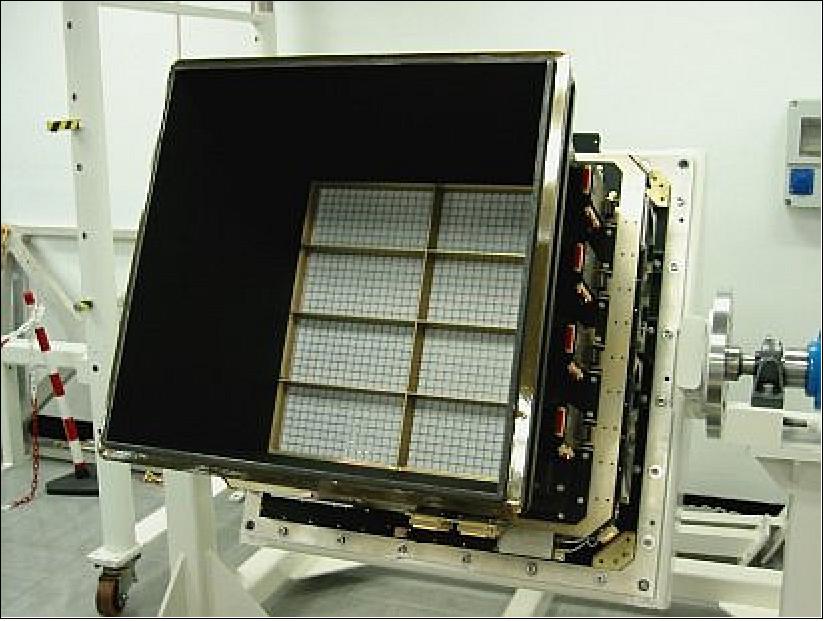
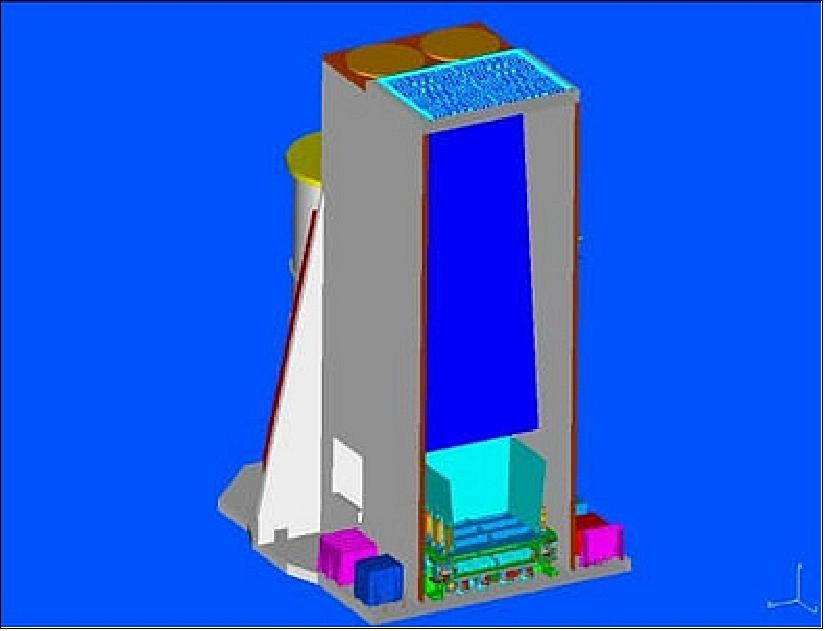
JEM-X (Joint European X-Ray Monitor)
JEM-X) is one of four instruments on ESA's INTEGRAL mission. It plays a crucial role in the detection and identification of the gamma-ray sources. JEM-X makes observations simultaneously with the main gamma-ray instruments and provides images in the 3 - 35 keV prime energy band with an angular resolution of 3 arcmin. It consists of two identical instruments and, like IBIS and SPI, uses the coded-mask technique for imaging. Two coded masks are located 3.2 m above the detection plane. 68)
The PI of JEM-X is: Søren Brandt, DSRI (Danish Space Research Institute), Copenhagen, Denmark.
The detector, an imaging microstrip gas counter, consists of two identical high pressure gas chambers filled with a mixture of xenon and methane at a pressure of 1.5 bar, that is 1.5 times the normal atmospheric pressure at sea level. When an incoming X-ray hits the xenon gas it knocks off an electron which is accelerated by the electric field in the detector and knocks off even more electrons. The electrons cascade onto one of the wires in the detector. By measuring the size of the electric charge on the wire scientists can determine the energy of the initial X-ray. JEM-X contains crossed wires so scientists can also determine the location of the electron cascade representing the incoming photon. The total detection area of JEM-X is 1000 cm2.
JEM-X has been built by a number of collaborating scientific institutes in Denmark (DSRI Lyngby), Finland (Metorex Espoo, University of Helsinki), Spain (University of Valencia, INTA Madrid), Italy (IAS Frascati, University of Ferrara, IFCAI Palermo, ITESRE Bologna), USA (NASA/GSFC Greenbelt, MD), Sweden (Observatory Stockholm), United Kingdom (University of Cambridge), Poland (Copernicus Center Warsaw, Space Research Center Warsaw), Russia (IKI Moscow).
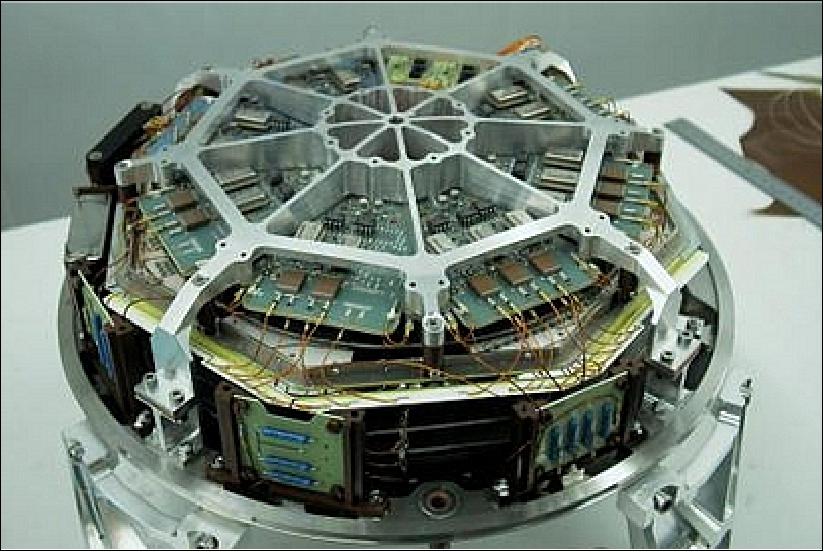
Energy range | 3 - 35 keV |
Detector area | 2 units, 500 cm2 each |
Spectral resolution | 1.3 keV @ 10 keV |
Field of view | 4.8º fully coded, 7.5º half response, 13.2º zero response |
Angular resolution | 3 arcmin FWHM |
Point Source Location Accuracy | 1 arcsec (90% confidence, 15σ isolated source) |
Narrow-line sensitivity: - 3σ in 105 s, @ 6 keV; - 3σ in 105 s, @ 20 keV | 1.64 x 10-4 phs-1cm-2 ; 1.30 x 10-4 phs-1cm-2 |
Continuum sensitivity: - 3σ in 105 s, @ 6 keV; - 3σ in 105 s, @ 30 keV | 1.2 x 10-4 phs-1cm-2keV-1; 1.0 x 10-4 phs-1cm-2keV-1 |
Timing accuracy (3σ) | 122 µs (relative); 1 ms (absolute) |
Typical Source Location (10σ source) | < 30" (arcsec) |
Resources [following EID-A (Experiment Interface Document-A) allocation] | |
Mass of instrument | 65 kg |
Power (sun/eclipse) | 50/0 W |
Data rate (solar maximum); Date rate (solar minimum) | 7.0 kbit/s; 7.0 kbit/s |
OMC (Optical Monitoring Camera)
The OMC on-board INTEGRAL offers the first opportunity to make long observations of the visible light coming from gamma-ray and X-ray sources. Multiwavelength observations are particularly important in high-energy astrophysics where variability is typically rapid. Using wide-band observation, INTEGRAL provides simultaneous observations over seven orders of magnitude in photon energy for some of the most energetic objects in the Universe for the first time.
The PI of the OMC is Miguel Mas-Hesse, LAEFF-INTA (Laboratorio de Astrofísica Espacial y Física Fundamental-Instituto National de Técnica Aeroespacial), Madrid, Spain.
The OMC is placed on top of the satellite and is sensitive to stars with a visual magnitude up to 19.7. The OMC is a standard optical refractor with a 5 cm lens and a CCD (Charge-Coupled Device), 2055 x 1056 pixels, imaging area: 1024 x 1024 pixels) in the focal plane. The CCD is located in the focal plane of a 50 mm (diameter) lens including a Johnson V-filter to cover the 500 - 600 nm wavelength range. These silicon chips consist of pixels, which convert impinging photons into an electric charge. The accumulated charge is transferred out of the device and recorded. The data can then be converted into an image. To reduce noise, the CCD head of the OMC is cooled to -80ºC.
The instrument has been built by collaborating scientific institutes in Spain (INTA/LAEFF Madrid, University of Valencia, University of Barcelona), Ireland (UCD (University College Dublin), Belgium (University of Liege), United Kingdom (MSSL Dorking), Czech Republic (Astrophysical Institute).
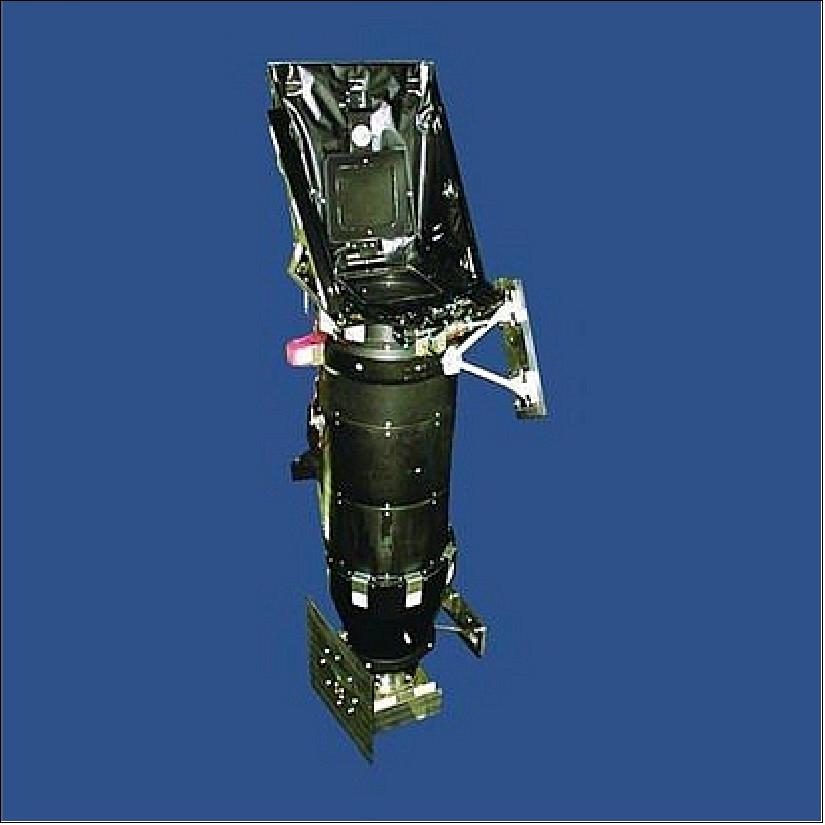
Field of view | 4.979º x 4.979º |
Aperture | 5 cm diameter |
Focal length | 153.7 mm (f/3.1) |
Optical throughput | > 70% at 550 nm |
Stray light reduction factor* (within UFOV^) | << 1e-4 (no stray light detected) |
Detector | 50 mm lens + CCD (2055 x 1056 pixels); imaging area = 1024 x 1024 pixels |
Pixel size | (13 x 13) µm2 = (17.5 x 17.5) arcsec2 |
CCD quantum efficiency | 88% at 550 nm |
CCD full well capacity | ~120,000 electrons/pixel |
Angular resolution | ~23 arcsec Gauss PSF (FWHM=1.3±0.1 pixel) |
ADC (Analog Digital Converter) levels | 12 bit signal, 4096 levels: |
Frame transfer time | ~ 2 ms |
Typical integration times | 10 s, 50 s, 200 s |
Time resolution | >3 s |
Limiting magnitude | 18.1 [V, 10 x 200 s, 3σ]; 18.9 [V, 50 x 200 s, 3σ]; 19.3 [V, 100 x 200 s, 3σ] |
Photometric accuracy | <0.3 mag for <16 mag and >300 s |
Point source location accuracy | ~2 arcsec |
IREM (INTEGRAL Radiation Environment Monitor)
IREM performs a wide range of radiation monitoring functions in-orbit, and downloads the results via the INTEGRAL spacecraft telemetry to the ground. 69)
The IREM data are part of the spacecraft "housekeeping" stream and, as such, are made available to all users via the ISDC (INTEGRAL Science Data Center).
The design of the IREM is based on that of the SREM ( Standard Radiation Environment Monitor), which is designed as a standard equipment compatible with all common spacecraft interfaces and mission constraints. The main difference between the IREM and other SREMs is the small interface box between the IREM instrument and the INTEGRAL spacecraft.
Ground Segment
Two ground stations are tracking the INTEGRAL satellite whenever it is visible: ESA's Redu in Belgium and NASA's Goldstone in the USA. These two satellite tracking stations establish and maintain communications between the gamma-ray observatory in space and the control center on the ground. 70)
ESA's MOC (Mission Operations Center) responsible for satellite control is located at ESOC (European Space Operations Center), in Darmstadt, Germany. The INTEGRAL team at ESOC performs the spacecraft operations and maintenance tasks and it uplinks the observation plan to the satellite in orbit.
The observation plan has been made by the ISOC (INTEGRAL Science Operations Center), at Noordwijk, the Netherlands. In October 2000 ISOC issued a first call for observation proposals addressed to the scientific community. This covers so-called guest observer observations for the first year of INTEGRAL operations. A committee selected the submitted proposals on their scientific merit. The accepted proposals are the basis of the General Program that covers most of the observing time of the INTEGRAL observatory. A remaining fraction of 25-35% has been reserved for scientific institutes participating in the design and development of the INTEGRAL mission.
ISOC processes the selected proposals into an optimized plan which consists of a time-line of target pointings and the corresponding instrument configuration. This observation plan will then be forwarded to the Mission Operations Center in Darmstadt. At ESOC the observation plan is transformed into an operational command sequence which is transmitted to the spacecraft from Redu and Goldstone.
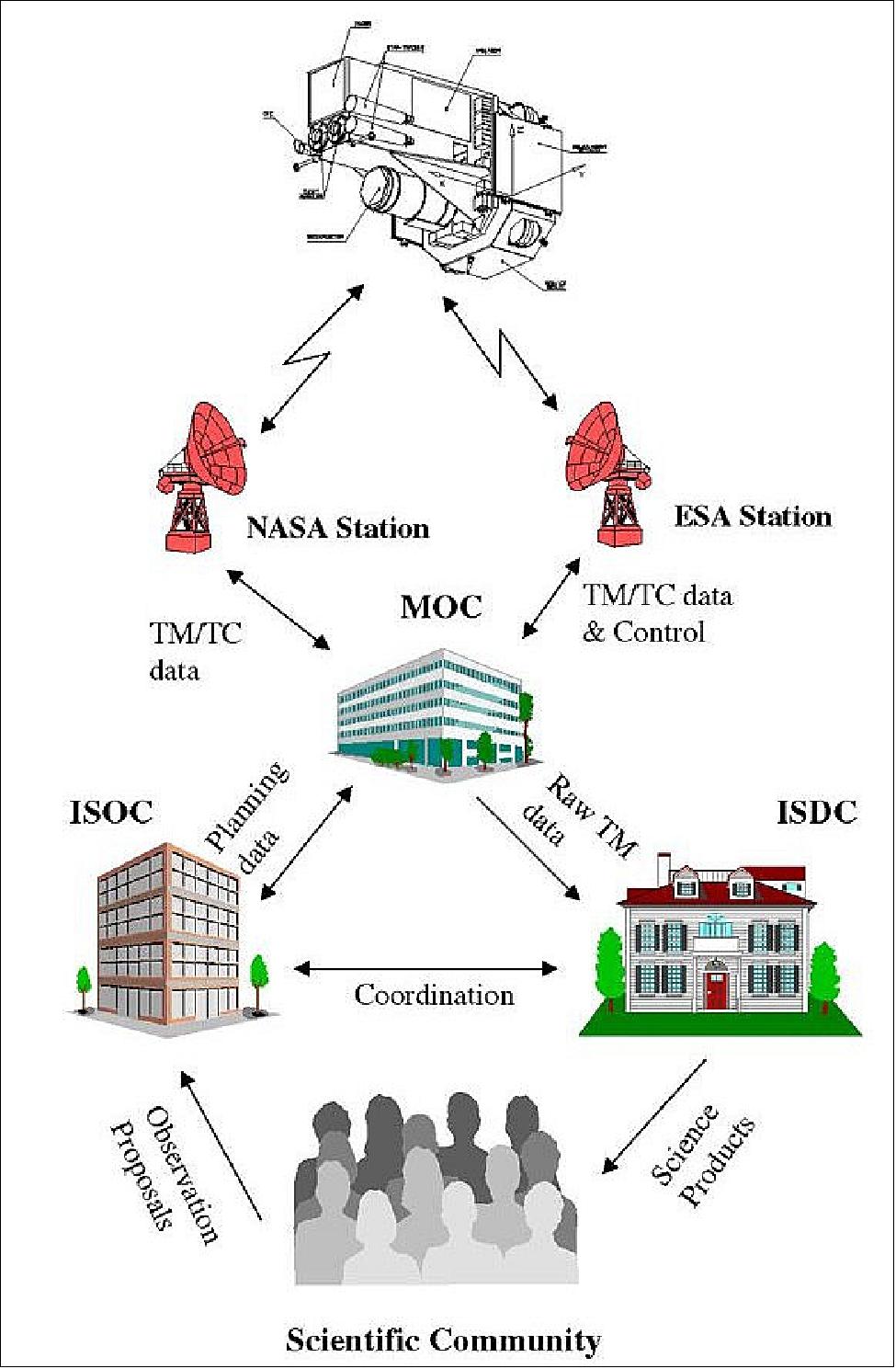
The MOC in Darmstadt also gathers the raw science data of INTEGRAL. These data are sent to the ISDC (INTEGRAL Science Data Center), in Versoix near Geneva, Switzerland. The ISDC processes the raw data taking into account the instrument characteristics and converts them into physical units. Then the data is distributed to the observer and archived for later use by the scientific community.
The ISDC monitors routinely the performance of the instruments and conduct a quick-look science analysis. If an object of special interest is detected, this is reported to the INTEGRAL Science Operations Center, ESOC, Madrid. There the project scientist will decide if the observing program has to be rescheduled to study the special object.
The MOC in Darmstadt and the ISOC (INTEGRAL Science Operations Center) in Madrid are under the responsibility of ESA. The scientific community, led by Swiss principal investigator Thierry Courvoisier, will provide help from the INTEGRAL Science Data Center in Versoix.
References
1) ”INTEGRAL Overview,” ESA, 13 April 2007, URL: http://www.esa.int/Our_Activities/Space_Science/Integral_overview
2) ”INTEGRAL Spacecraft, Launcher and Orbit,” ESA, URL: https://www.cosmos.esa.int/web/integral/spacecraft
3) P. L. Jensen, K. Clausen, C. Cassi, F. Ravera, G. Janin, C. Winkler, R.Much, ”The INTEGRAL spacecraft – in-orbit performance,” Astronomy & Astrophysics, Vol. 411, L7–L17 (2003), DOI: 10.1051/0004-6361:20031173, URL: https://www.aanda.org/articles/aa/pdf/2003/43/aaINTEGRAL59.pdf
4) ”Launch vehicle,” ESA, URL: http://sci.esa.int/integral/31287-launch-vehicle/
5) ”Three hours to save Integral,” ESA Enabling & Support, 18 October 2021, URL: https://www.esa.int/Enabling_Support/Operations/Three_hours_to_save_Integral
6) ”Rescuing Integral: No thrust? No problem,” ESA Enabling & Support, 16 July 2021, URL: https://www.esa.int/Enabling_Support/Operations/Rescuing_Integral_No_thrust_No_problem
7) ”Dead star emits never-before seen mix of radiation,” ESA Science & Exploration, 28 July 2020, URL: https://www.esa.int/Science_Exploration/Space_Science
/Dead_star_emits_never-before_seen_mix_of_radiation
8) S. Mereghetti, V. Savchenko, C. Ferrigno, D. Götz, M. Rigoselli, A. Tiengo, A. Bazzano, E. Bozzo, A. Coleiro, T. J.-L. Courvoisier, M. Doyle, A. Goldwurm, L. Hanlon, E. Jourdain, A. von Kienlin, A. Lutovinov, A. Martin-Carrillo, S. Molkov, L. Natalucci, F. Onori, F. Panessa, J. Rodi, J. Rodriguez, C. Sánchez-Fernández, R. Sunyaev, and P. Ubertini, ”INTEGRAL Discovery of a Burst with Associated Radio Emission from the Magnetar SGR 1935+2154,” The Astrophysical Journal Letters, Volume 898, Number 2, L29, Published: 27 July 2020, https://doi.org/10.3847/2041-8213/aba2cf
9) ”Scientists get to the bottom of a ‘spitting’ black hole,” ESA, 29 April 2019, URL: http://www.esa.int/Our_Activities/Space_Science/
Scientists_get_to_the_bottom_of_a_spitting_black_hole
10) James C. A. Miller-Jones, Alexandra J. Tetarenko, Gregory R. Sivakoff, Matthew J. Middleton, Diego Altamirano, Gemma E. Anderson, Tomaso M. Belloni, Rob P. Fender, Peter G. Jonker, Elmar G. Körding, Hans A. Krimm, Dipankar Maitra, Sera Markoff, Simone Migliari, Kunal P. Mooley, Michael P. Rupen, David M. Russell, Thomas D. Russell, Craig L. Sarazin, Roberto Soria & Valeriu Tudose, ”A rapidly changing jet orientation in the stellar-mass black-hole system V404 Cygni,” Nature Letter, https://doi.org
/10.1038/s41586-019-1152-0 Published: 29 April 2019,
11) ”Team of telescopes finds X-ray engine inside mysterious supernova,” ESA, 10 January 2019, URL: http://sci.esa.int/integral/61058-team-of-telescopes-finds-x-ray-engine-inside-mysterious-supernova/
12) Calla Cofield, Jeanette Kazmierczak,”Holy Cow! Mysterious Blast Studied with NASA Telescopes,” NASA, 10 January, 2019, URL: https://www.nasa.gov/feature
/jpl/holy-cow-mysterious-blast-studied-with-nasa-telescopes
13) Raffaella Margutti, B. D. Metzger, R. Chornock, I. Vurm, N. Roth, B. W. Grefenstette, V. Savchenko, R. Cartier, J. F. Steiner, G. Terreran, G. Migliori, D. Milisavljevic, K. D. Alexander, M. Bietenholz, P. K. Blanchard, E. Bozzo, D. Brethauer, I. V. Chilingarian, D. L. Coppejans, L. Ducci, C. Ferrigno, W. Fong, D. GÖtz, C. Guidorzi, A. Hajela, K. Hurley, E. Kuulkers, P. Laurent, S. Mereghetti, M. Nicholl, D. Patnaude, P. Ubertini, J. Banovetz, N. Bartel, E. Berger, E. R. Coughlin, T. Eftekhari, D. D. Frederiks, A. V. Kozlova, T. Laskar, D. S. Svinkin, M. R. Drout, A. Macfadyen, K. Paterson, ”An embedded X-ray source shines through the aspherical AT2018cow: revealing the inner workings of the most luminous fast-evolving optical transients,” Astrophysical Journal, Draft versersion 26 October 2018, URL: https://arxiv.org/pdf/1810.10720.pdf
14) ”Integral X-rays Earth's aurora,” ESA, 19 November 2018, URL: http://m.esa.int/spaceinimages/Images/2018/11/Integral_X-rays_Earth_s_aurora
15) ”Extended life for ESA's science missions,” ESA Science & Technology, 14 November 2018, URL: http://sci.esa.int/director-desk/60943-extended-life-for-esas-science-missions/
16) ”INTEGRAL joins multi-messenger campaign to study high-energy neutrino source,” ESA, 12 July 2018, URL: http://sci.esa.int/integral/
60492-integral-joins-multi-messenger-campaign-to-study-high-energy-neutrino-source/
17) The IceCube Collaboration, Fermi-LAT, MAGIC, AGILE, ASAS-SN, HAWC, H.E.S.S., INTEGRAL, Kanata, Kiso, Kapteyn, Liverpool Telescope, Subaru, Swift/NuSTAR, VERITAS, and VLA/17B-403 teams, ”Multimessenger observations of a flaring blazar coincident with high-energy neutrino IceCube-170922A,” Science, 13 July 2018, Vol. 361, Issue 6398, eaat1378, DOI: 10.1126/science.aat1378, URL: http://science.sciencemag.org/content/361/6398/eaat1378/tab-pdf
18) ”Donor star breathes life into zombie companion,” ESA, 5 March 2018, URL: http://m.esa.int/Our_Activities/Space_Science/Donor_star_breathes_life_into_zombie_companion
19) E. Bozzo, A. Bahramian, C. Ferrigno, A. Sanna, J. Strader, F. Lewis, D. M. Russell, T. di Salvo, L. Burderi, A. Riggio, A. Papitto, P. Gandhi, P. Romano, ”IGR J17329-2731: The birth of a symbiotic X-ray binary,” Astronomy & Astrophysics, DOI: https://doi.org/10.1051/0004-6361/201832588, February 27, 2018, URL: https://www.aanda.org/articles/aa/pdf/forth/aa32588-18.pdf
20) ”Green light for continued operations of ESA science missions,” ESA, 7 Dec. 2017, URL: http://sci.esa.int/director-desk/59839-green-light-for-continued-operations-of-esa-science-missions/
21) ”Happy Birthday - INTEGRAL celebrates 15 successful years in orbit,” ESA 17 Oct. 2017, URL: https://www.cosmos.esa.int/web/integral/home
22) ”INTEGRAL’s orbits 2002–17,” ESA, 20 Nov. 2017, URL: http://m.esa.int/spaceinimages/Images/2017/11/Integral_s_orbits_2002_17
23) ”INTEGRAL sees blast travelling with gravitational waves,” ESA, 16 October, 2017, URL: http://sci.esa.int/integral/59664-integral-sees-blast-travelling-with-gravitational-waves/
24) ”Two-year extensions confirmed for ESA's science missions,” ESA, 22 Nov. 2016, URL: http://sci.esa.int/director-desk/58589-two-year-extensions-confirmed-for-esa-s-science-missions/
25) ”INTEGRAL sets limits on gamma rays from merging black holes,” ESA, 30 March 2016, URL: http://sci.esa.int/integral/57655-integral-sets-limits-on-gamma-rays-from-merging-black-holes/
26) V. Savchenko, C. Ferrigno, S. Mereghetti, L. Natalucci, A. Bazzano, E. Bozzo, S. Brandt, T. J.-L. Courvoisier, R. Diehl, L. Hanlon, A. von Kienlin, E. Kuulkers, P. Laurent, F. Lebrun, J. P. Roques, P. Ubertini, G. Weidenspointner, ”INTEGRAL Upper Limits On Gamma-Ray Emission Associated With The Gravitational Wave Event GW150914," The Astrophysical Journal Letters, Vol. 820:L36 (5pp), 2016 April 1, doi:10.3847/2041-8205/820/2/L36, URL: http://iopscience.iop.org/article/10.3847/2041-8205/820/2/L36/pdf
27) ”INTEGRAL X-rays Earth's aurora,” ESA, 26 Jan. 2016, URL: http://sci.esa.int
/integral/57257-integral-x-rays-earths-aurora/
28) ”Astronomers use cosmic gravity to create a 'black-hole-scope',” ESA, 6 July 2015, URL: http://sci.esa.int/integral/56128-astronomers-use-cosmic-gravity-to-create-a-black-hole-scope/
29) ”Gravitational lensing,” ESA, 6 July 2015, URL: http://sci.esa.int/integral/56129-gravitational-lensing/
30) Andrii Neronov, Ievgen Vovk, Denys Malyshev, ”Central engine of a gamma-ray blazar resolved through the magnifying glass of gravitational microlensing,” Nature Physics, Vol. 11, 664–667 (2015), doi:10.1038/nphys3376, Published online: 06 July 2015, URL: https://www.nature.com/articles/nphys3376.pdf
31) ”INTEGRAL maneuvers for the future,” ESA, 23, Jan. 2015, URL: http://sci.esa.int
/integral/55345-integral-manoeuvres-for-the-future/
32) ”Working life extensions for ESA’s science missions,” 20 Nov. 2014, URL: http://sci.esa.int
/director-desk/54999-working-life-extensions-for-esas-science-missions/
33) ”Debris from stellar explosions in the Galaxy's fast lane,” ESA, 19 Nov. 2013, URL: http://sci.esa.int/integral/53245-debris-from-stellar-explosions-in-the-galaxy-fast-lane/
34) Karsten Kretschmer, Roland Diehl, Martin Krause, Andreas Burkert, Katharina Fierlinger, Ortwin Gerhard, Jochen Greiner, Wei Wang, ”Kinematics of massive star ejecta in the Milky Way as traced by 26Al,” Astronomy & Astrophysics, Volume 559, November 2013, Article No A99, doi: https://doi.org
/10.1051/0004-6361/201322563
35) ”INTEGRAL celebrates a decade of discoveries,” ESA 17 Oct. 2012, URL: http://sci.esa.int/integral/50938-integral-celebrates-a-decade-of-discoveries/
36) ”Illustration of a Supergiant Fast X-ray Transient (SFXT) source,” ESA, 21 June 2010, URL: http://sci.esa.int/integral/47224-illustration-of-a-supergiant-fast-x-ray-transient-sfxt-source/
37) ”The entire sky in hard X-rays as viewed by INTEGRAL,” ESA, 17 Oct. 2012, URL: http://sci.esa.int/integral/50767-the-entire-sky-in-hard-x-rays/
38) ”Closer than ever in the last nine years,” ESA, INTEGRAL News archive for 2011, 25 Oct. 2011, URL: https://www.cosmos.esa.int/web/integral/news-2011
39) ”Active Sun affects INTEGRAL again,” ESA, INTEGRAL News archive for 2011, 5 Aug. 2011, URL: https://www.cosmos.esa.int/web/integral/news-2011
40) ”Magnetar observed during outburst thanks to rapid response of INTEGRAL,” ESA, 27 Jan. 2009, URL: http://sci.esa.int/integral/44074-magnetar-observed-during-outburst-thanks-to-integral-s-rapid-response/
41) ”XMM-Newton and INTEGRAL clues on magnetic powerhouses,” ESA 14 Nov. 2008, URL: http://m.esa.int/Our_Activities/Space_Science/Integral/
XMM-Newton_and_Integral_clues_on_magnetic_powerhouses
42) A. J. Dean, D. J. Clark, J. B. Stephen, V. A. McBride, L. Bassani, A. Bazzano, A. J. Bird, A. B. Hill, S. E. Shaw, P. Ubertini, ”Polarized Gamma-Ray Emission from the Crab,” Science, 29 Aug 2008, Vol. 321, Issue 5893, pp. 1183-1185, DOI: 10.1126/science.1149056
43) N. Rea, S. Zane, R. Turolla, M. Lyutikov, D. Goetz, ”Resonant cyclotron scattering in magnetars’ emission,” Astrophysical Journal, Vol. 686, pp:1245-1260, 20October 2008, URL: http://iopscience.iop.org/article/10.1086/591264/pdf
44) ”INTEGRAL locates origin of high-energy emission from Crab Nebula,” ESA, 29 Aug. 2008, URL: http://m.esa.int/Our_Activities/Space_Science/Integral/
Integral_locates_origin_of_high-energy_emission_from_Crab_Nebula
45) ”Science with INTEGRAL – five years on,” ESA, 17 Oct. 2007, URL: http://m.esa.int/Our_Activities/Space_Science/Science_with_Integral_five_years_on
46) ”Radioactive iron, a window to the stars,” ESA, 25 June, 2007, URL: http://m.esa.int/Our_Activities/Space_Science/Radioactive_iron_a_window_to_the_stars
47) W. Wang, M. J. Harris, R. Diehl, H. Halloin, B. Cordier, A. W. Strong, K. Kretschmer, J. Knödlseder, P. Jean, G. G. Lichti, J. P. Roques, S. Schanne, A. von Kienlin, G. Weidenspointner, C. Wunderer, ”SPI observations of the diffuse 60Fe emission in the Galaxy,” Astronomy & Astrophysics, Vol. 469, pp: 1005–1012 (2007), DOI: 10.1051/0004-6361:20066982, URL: https://www.aanda.org/articles/aa/pdf/2007/27/aa6982-06.pdf
48) ”INTEGRAL catches a new erupting black hole,” ESA, 27 Nov. 2006, URL: http://m.esa.int/Our_Activities/Space_Science/Integral/Integral_catches_a_new_erupting_black_hole
49) ”ESA steps towards a great black hole census,” ESA, INTEGRAL News archive for 2006, 7 Sept. 2006, URL: https://www.cosmos.esa.int/web/integral/news-2006
50) ”Integral's black hole census,” ESA, 7 Sept. 2006, URL: http://m.esa.int/spaceinimages/Images/2006/09/Integral_s_black_hole_census
51) ”ESA's INTEGRAL and XMM-Newton missions extended,” ESA, INTEGRAL News archive for 2005, 5 Dec. 2005, URL: https://www.cosmos.esa.int/web/integral/news-2005
52) ”Star eats companion,” ESA, 6 Sept. 2005, URL: http://m.esa.int/Our_Activities/Space_Science/Star_eats_companion
53) ”Artist's impression of a pulsar 'eating' a companion star,” ESA, 31 Aug. 2005, URL: http://m.esa.int/spaceinimages/Images/2005/08/Artist_s_impression_of_a_pulsar_eating_a_companion_star
54) ”Three satellites needed to bring out ‘shy star’,” ESA, 13 July 2005, URL: http://m.esa.int
/Our_Activities/Space_Science/Three_satellites_needed_to_bring_out_shy_star
55) V. Beckmann, J. A. Kennea, C. Markwardt, A. Paizis, S. Soldi, J. Rodriguez, S. D. Barthelmy, D. N. Burrows, M. Chester, N. Gehrels, N. Mowlavi, J. Nousek, ”Swift, INTEGRAL, RXTE, and Spitzer reveal IGR J16283-4838,” Astrophysics Journal, Vol. 631, pp: 506-510, 8 June 2005, doi: 10.1086/432600, URL: https://arxiv.org/pdf/astro-ph/0506170.pdf
56) ”Gamma Burst hits the Earth,” ESA, INTEGRAL News archive for 2005, 18 Feb. 2005, URL: https://www.cosmos.esa.int/web/integral/news-2005
57) ”ESA's Integral detects closest cosmic gamma-ray burst,” ESA, 5 Aug. 2004, URL: http://m.esa.int/Our_Activities/Space_Science/Integral/
ESA_s_Integral_detects_closest_cosmic_gamma-ray_burst
58) S. Yu. Sazonov, A. A. Lutovinov, R. A. Sunyaev, ”An apparently normal γ-ray burst with an unusually low luminosity,” Nature, Vol. 430, pp: 646–648 (05 August 2004), doi:10.1038/nature02748
59) A. M. Soderberg, S. R. Kulkarni, E. Berger, D. W. Fox, M. Sako, D. A. Frail, A. Gal-Yam, D. S. Moon, S. B. Cenko, S. A. Yost, M. M. Phillips, S. E. Persson, W. L. Freedman, P. Wyatt, R. Jayawardhana, D. Paulson, ”The sub-energetic γ-ray burst GRB 031203 as a cosmic analogue to the nearby GRB 980425,” Nature, Vol. 430, pp: 648–650 (05 August 2004), doi:10.1038/nature02757
60) ”The International Gamma-Ray Astrophysics Laboratory - 1 Year in Orbit,”ESA brochure, BR 210, Nov. 2003, URL: https://www.cosmos.esa.int/documents/332075/1123850/BR-210.pdf
61) ”ESA's Integral discovers hidden black holes,” ESA, 20 Oct. 2003, URL: http://m.esa.int
/Our_Activities/Space_Science/Integral/ESA_s_Integral_discovers_hidden_black_holes
62) ”INTEGRAL discovers new transient (IGR J16318-4848),” ESA INTEGRAL archive, 14 February, 2003, URL: https://www.cosmos.esa.int/web/integral/news-2003
63) ”ESA presents Integral's first images,” ESA, Press Release 79–2002, 11 Dec. 2002, URL: http://www.esa.int/For_Media/Press_Releases/ESA_presents_Integral_s_first_images
64) ”INTEGRAL News Archive for 2002,” ESA, URL: https://www.cosmos.esa.int/web/integral/news-2002
65) ”Instruments overview,” ESA, URL: http://sci.esa.int/integral/31175-instruments/?fbodylongid=717
66) ”INTEGRAL Instruments - SPI,” ESA, URL: http://sci.esa.int
/integral/31175-instruments/?fbodylongid=719
67) ”INTEGRAL instruments - IBIS,” ESA, URL: http://sci.esa.int
/integral/31175-instruments/?fbodylongid=720
68) ”INTEGRAL instruments - JEM-X,” ESA, URL: http://sci.esa.int
/integral/31175-instruments/?fbodylongid=721
69) ”INTEGRAL instruments - IREM,” ESA, URL: http://sci.esa.int
/integral/31175-instruments/?fbodylongid=723
70) ”Mission Operations,” ESA, 11 March 20111, URL: http://sci.esa.int/integral/39782-mission-operations/
The information compiled and edited in this article was provided by Herbert J. Kramer from his documentation of: ”Observation of the Earth and Its Environment: Survey of Missions and Sensors” (Springer Verlag) as well as many other sources after the publication of the 4th edition in 2002. - Comments and corrections to this article are always welcome for further updates (eoportal@symbios.space).
Spacecraft Launch Mission Status Sensor Complement Ground Segment References Back to top